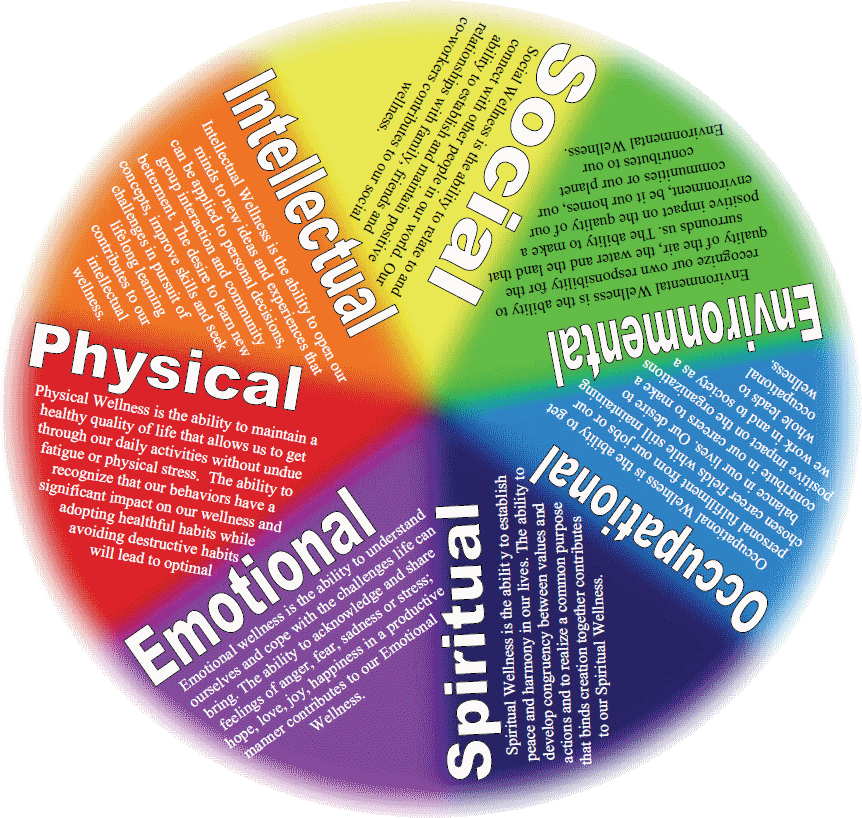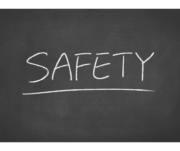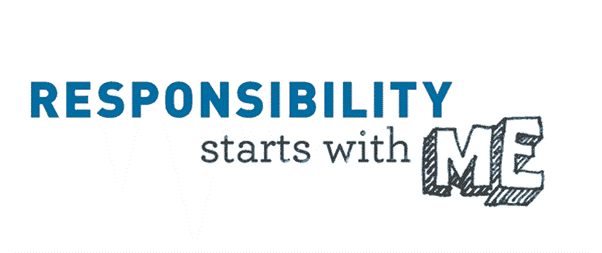Simplified Wellness – Workshop 1 (Health & Wellness: An Introduction)

The Appleton Greene Corporate Training Program (CTP) for Simplified Wellness is provided by Mrs. Sciortino Certified Learning Provider (CLP). Program Specifications: Monthly cost USD$2,500.00; Monthly Workshops 6 hours; Monthly Support 4 hours; Program Duration 12 months; Program orders subject to ongoing availability.
If you would like to view the Client Information Hub (CIH) for this program, please Click Here
Learning Provider Profile

Mrs Sciortino is a Certified Learning Provider (CLP) with Appleton Greene. An internationally renowned author, Simplicity Expert and Professional Speaker, she spent almost two decades as a high-functioning, award-winning executive before she experienced a life-changing event that forced her to stop and ask the question: ‘What if there’s a better way to live?’.
Embarking on a journey to answer this question, Mrs Sciortino uncovered a simple system to challenge the status quo and use the power of questions to purposefully direct life.
A highly accomplished businesswoman, Mrs Sciortino is an official member of the Forbes Coaches Council, has received nominations for the Top Female Author awards, was awarded a prestigious silver Stevie International Business Women Award, named as the recipient of a 2022 CREA Global Award and has also been awarded over 20 international awards for the uniqueness of the tools and resources she offers.
Sought globally for expert comment by media, she’s been featured in podcasts, Facebook Live, YouTube, blog articles, print media and in live TV and Radio.
Mrs Sciortino works globally with corporate programs, conference platforms, retreats, professional mentoring and in the online environment to teach people how easy it is to live life in a very different way.
When not working, she can be found in nature, on the yoga mat, lost in a great book, meditating, hanging out with her husband and her house panthers or creating magic in her kitchen.
MOST Analysis
Mission Statement
The health and wellness industry has grown to be a US$4 trillion a year market. We’re bombarded with information every day – most of it contradictory – and it creates confusion about what you should and shouldn’t be doing, what’s right and wrong for you and what works and doesn’t. This module explores what health and wellness actually is, what the principles of wellness are, why you want health and wellness in your life, how your values and beliefs play a part and how you can create a powerful relationship with wellness that has YOU at the center of the equation.
Objectives
1. Introduction to Health and Wellness – introduction to the course materials and explore personal expectations of this program. Understand what health and wellness really are and how the industry works.
2. The Current State of Play – look at where health and wellness currently stand, what the projection for growth of the industry is, the current level of participation and why there is an engagement crisis at all levels.
3. Health, Wellness and Wellbeing – explore health versus wellness, the ways in which they are different things but must always go together and how wellbeing fits into the picture.
4. Great Expectations – look at how expectations have changed over time, the weight of responsibility that comes with them and who expects what, when, how and why.
5. The Principles of Wellness – explore what can be achieved when a bespoke program is designed to meet the unique needs of an organization’s employees.
6. Benefits: Employers and Employees – explore the debate around whether the benefits of health and wellness programs are worthwhile, including looking at the impact that physical, mental and emotional health has on financial results, morale, motivation, satisfaction, engagement and stress reduction.
7. Organizational Change – understand what positive organizational culture looks like, why you need it to implement an effective health and wellness program, what your culture might be costing you and how a holistic approach can assist in making change management easier.
8. Personal Responsibility – understand the role of personal responsibility and the critical part it plays in the success of a health and wellness program.
9. Truth, Myths and Marketing Spin – learn how to see through the myths and marketing spin to source the information that empowers you to create the way forward that’s perfect for you.
10. Happiness – learn what happiness is, what the four states of happiness are and understand the important role that happiness plays in health and wellness.
11. Values – explore what values are, why you not only need but actually want them, how to develop values and how to use them to enhance your health and wellness once you have them.
12. Beliefs – understand what beliefs are, their role in your life, where they come from and whether they help or hinder your health and wellness.
Strategies
1. Engage and elicit expectations for the program.
2. Introduce health and wellness and complete an exercise on current views of the effectiveness of health and wellness programs.
3. Set aside time to study the information, tools and resources in the workshop.
4. Set aside time to meet with their team to discuss the elements of the workshop.
5. Identify, and make a list of, the key personnel needed to participate in health and wellness discussions.
6. Participants to complete the exercises individually and then discuss as a group.
7. Allocate time to consider the current effectiveness of any health and wellness program in place.
8. Without conducting any in-depth research, identify any obviously missing elements from existing health and wellness programs.
9. Identify any elements that are working well from existing health and wellness programs.
10. Identify the convincing rationale for creating a bespoke health and wellness program.
11. Create a clear narrative regarding the need for a collaborative approach to creating the framework for a health and wellness program.
12. Set aside time to identify, and write down, what commitment you are prepared to make to your health and wellness journey.
Tasks
1. Set aside time to read through course manuals and make notes.
2. Allocate time to read the workshop’s preliminary analysis.
3. Identify the key personnel needed to create an effective health and wellness program.
4. Ensure relationships are built with key personnel through regular meetings, discussion and gathering ideas.
5. Schedule a meeting within the next 30 days for participants to meet and discuss workshop.
6. Participate in small groups during the workshop to share observations and reflections.
7. Determine and schedule the time needed to dedicate each workshop.
8. Demonstrate preparedness, commitment and personal presence at each workshop.
9. Prepare questions, seek feedback and create a plan for personal growth.
10. Each exercise in the workshop must be fully completed by the participants, and they must share the process and outcomes with the group.
11. Participants should identify and put into practise the adjustments presented throughout the workshop in order to finish their project.
12. Participants are asked to go over resources for ideas and choose at least one new tool from the list to use.
Introduction
The first workshop in the Simplified Wellness Program – Health and Wellness: An Introduction – focuses on demystifying the health and wellness industry so you can better understand how to move forwards in a way that allows you to thrive rather than just survive.
During this workshop, you’ll learn what health and wellness actually is, what the principles of wellness are, why you want health and wellness in your life, how your values and beliefs play a part and how you can create a powerful relationship with wellness that has YOU at the center of the equation.

History
The term “wellness” has historical roots. Since the 1950s, 1960s, and 1970s, when the writings and leadership of a loosely connected group of American doctors and philosophers greatly influenced how we understand and talk about wellbeing today, wellness has gained popularity as a modern concept.
But the roots of wellness go back much further than that, even to ancient times. Aspects of the wellness idea have their beginnings in a number of intellectual, religious and medical revolutions that took place during the 19th Century in Europe and the United States. The principles of wellbeing can also be traced to the prehistoric societies of Asia, Greece, and Rome, whose historical traditions have had a profound impact on the contemporary wellness movement.

Current Position
Today, the term “health and wellness” refers to a broad range of practices that support both physical and mental health, including yoga, healthy eating, personal grooming, weight loss, meditation, spa retreats, corporate wellness and wellness travel. Nearly 40 years after its founding, however, wellness is still not well understood and continues to be articulated by many people in different ways.
Since the opening of the first wellness center on the west coast of the United States, the idea of wellness has influenced American and international society, including professionals, clients and scientists. Thousands of records containing the phrase “wellness” are now found in scientific databases all over the world.
Particularly in practice, the term “wellness” is frequently oversimplified to mean “being well and healthy”. Wellness gyms, gardening businesses providing “wellness” services and even wellness pet food are now commonly available. This trend is global; one may purchase ‘wellness tuna fish’ or ‘wellness shower gel’ both in the United States and the Czech Republic, for example.
Globally, there are diverse interpretations of the wellness notion, and the term is frequently misused to sell products and services. Today, it can easily be characterized as a division between quasi-spiritual wellness and secular wellness:
• Secular wellness is based on science, personal responsibility, critical thinking, exercise and fitness, and a conscious search for additional meaning and purpose in life.
• Quasi/spiritual wellness is based on faith, emotions, supernaturalism, the recovery movement, wishful thinking, weepy/swaying, hand-holding, New Age mysticism and guru worship.
Numerous applications of wellness concepts can be found between these two poles of the present wellness movement, including those most frequently seen today being: workplace wellness, wellness coaching and wellness tourism.
Additionally, soaring healthcare costs create intense pressure that has forced a shift to wellness as the major focus of every individual, organization and government body.
This environment has seen traditional medical establishments and more governments turn their attention to wellness and prevention, chiefly as a result of the global epidemic of chronic diseases and obesity that has resulted in unaffordable healthcare expenses in this century. For instance, whereas in the 1990s the majority of academic medical facilities took a negative stance towards complementary medicine, today several of the world’s most prestigious institutions have departments of integrative medicine.

Future Outlook
The perception of ‘healthy’ is the thing that has most likely undergone the biggest mental shift of the 21st Century.
In the history of humanity, wellness has never been a goal for such a sizable section of the people. The majority of human history has seen specific fitness and wellness activities restricted to specialized groups, while the general public perceived the influence of lifestyle on daily wellness as a natural occurrence.
Now, over 50% of people currently hold the active or latent belief that their health and wellbeing can be actively managed and promoted.
A portion of the population is motivated by the idea of holistic wellness, longevity, quality of life and permanently maintaining healthy vitals, even though for 90% of wellness seekers, health and wellness still remain driven by tangible parameters linked to rising individuality: looks, managing health conditions and entertainment.
Before the global pandemic of 2020-2021, the health and wellness industry generated approximately US$4 trillion per annum. It is now expected to reach over US$7.5 trillion by 2030, growing at a rate of approximately 5.5% each year.
New technologies and virtual worlds are being developed by the wellness sector, and they will radically alter how wellness is provided to customers worldwide.
Health
Consumers are spending more money on their health and are wanting easier access to inexpensive care. Additionally, after the pandemic, consumers are upgrading their level of health and safety and are willing to pay more for products with health-related brands.
As a result, the needs of various patient populations and the related effective care pathways will determine health in addition to other factors. The consumer-focused character of these ecosystems will also expand the variety of healthcare touchpoints available to alter patient behavior and enhance outcomes.
Fitness
The future of fitness is positioned to continue down a creative and forward-thinking route, where gradual and pressing requirements will be met by contemporary solutions. Fitness enthusiasts have faced difficulties over the last two pandemic-impacted years, while also learning important lessons.
The ability to successfully utilize technology to deliver immersive and cutting-edge experiences will determine the direction of fitness in the future. Fitness consumers have a greater chance to complete a work-out from home, be engaged and maintain their fitness levels thanks to the capabilities of fitness software, which can offer an integrated streaming service or integrate with wearable fitness equipment, for instance.
Nutrition
More people are interested in discovering a solution as a result of the increased focus on nutrition. Technology will become increasingly important in this as we develop.
Food monitoring, for instance, will assist businesses in identifying the origins and routes of their products. Better information access will change how people view food and its connection. Additionally, increased understanding of the catastrophic and pervasive repercussions of poor nutrition will eventually lead to the adoption of more capable, healthy and resilient eating habits.
We don’t need a choice; we need to return to the principles of good nutrition that allow our bodies and brains to function properly and live longer. On the front lines of this revolution will be battles over nutrition.
Being mindful
The pandemic has improved our knowledge of how susceptible our mental health is. We have witnessed firsthand how rapidly external circumstances and obstacles affect our emotions and actions, since they are directly impacted by both our physical health and the external environment. We’ve even come to appreciate the power and adaptability of the human intellect. It’s also conceivable that artificial intelligence may get to the point where it can offer basic medical assistance.
In the upcoming decades, practically all product and service offers will include wellness as standard. It will eventually become the focal point around which solutions are developed. By this time, it will be commonplace to believe that anything created or provided by any corporation will improve outcomes in terms of health and fitness. This is comparable to how, in the 1950s and 1960s, quality and safety elements gradually crept into every product and service offered.
Executive Summary
The first workshop in the Simplified Wellness Program – Health and Wellness: An Introduction, focuses on understanding what health and wellness actually is, where the health and wellness industry is currently, what’s possible and how you can create a completely new relationship with your health and wellness to move forwards in a different way.
The health and wellness industry covers many areas, has millions of providers and generates over US$4 trillion a year. Aside from the pharmaceutical and medical portion of the industry, there’s little regulation and many people with varied opinions and beliefs.
There’s a lot of noise, a lot of sales and often a big spiral that keeps people trapped. This workshop aims to assist you in cutting through the ‘stuff’, giving you the information you need to understand how the industry works, and then providing you with simple but effective steps you can take to start moving your life in the direction that’s right for you.
This workshop has 12 focus areas. Here’s what they cover:

Chapter 1: Introduction to Health and Wellness
According to the World Health Organization (WHO), health is defined as being a state of complete physical, mental and social wellbeing and not merely an absence of disease or infirmity. It’s critical to comprehend how wellness is related to health in order to appreciate its significance. The achievement of improved physical and mental health results – and to thrive rather than just survive – means that we need to practice healthy behaviors on a regular basis.
There’s so much information available at our fingertips now – more than ever before. There’s also no clear pathway, or one solution, that works for everyone – despite the results that are promised by providers in the marketplace. It’s confusing and it can be hard to know where to start.
Understanding what health and wellness really is, and how the industry works, will help you in all aspects of your life.
In this focus area you will learn what health and wellness is, why you want them, the principles of wellness and the eight dimensions of wellness.
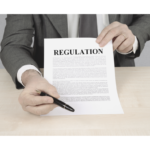
Chapter 2: The Current State of Play
Mental health has rapidly become the number one focus of organizations around the globe. Although, as the first focus area of this workshop shows, mental health is only one plank of wellbeing, it has fast become the only one that individuals are focusing on. Research is being conducted around the globe on all aspects of mental health and, as a result, organizations are beginning to focus their wellness programs in this area.
Despite its high profile, there remains a small percentage of participation in wellness programs by both organizations and individuals. Furthermore, most of these programs are implemented with unclear tactics and benefits and therefore provide small, short-term gains.
In this focus area you will learn where things are currently, what the projection for growth of the industry is, the current level of participation and why there is an engagement crisis at all levels of the programs that are in place.
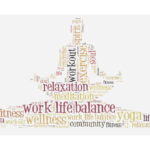
Chapter 3: Health, Wellness and Wellbeing
Health and wellness are terms that are often used interchangeably, but they do have different meanings.
Understanding the difference between the two is a great place to start on a journey to wellness – both within an organization and also as individuals.
Workplace wellness boosts both employee health and an organization’s financial bottom line. Developing a culture of health and wellness at work enhances employee lives, maintains staff morale, and contributes to an organization’s success.
In this focus area you’ll learn why health and wellness are separate things but must always go together, the difference between health and wellness and also the difference between wellness and wellbeing.

Chapter 4: Great Expectations
In every employer/employee relationship, a set of expectations is formed. Over time, as the relationship grows and develops, expectations also grow but often lines of communication become blurred.
There’s always a weight that comes with carrying any expectation and the weight of expectations around health and wellness can be a significant burden to carry over time.
In 2019, the WHO redefined burnout in its International Classification of Diseases (ICD) and stated that it is an ‘Occupational Phenomenon’ (World Health Organization ICD-11, 2019), linked to stress at work, that can be defined as including depleted energy, exhaustion, negativity, cynicism and reduced productivity.
This seemed to point the finger squarely at organizations to ‘fix’ the growing stress and burnout issues being experienced around the globe. However, it also led to the conundrum of organizations needing to provide health and wellness solutions that were effective for each and every individual in their employ.
In this focus area you’ll learn about the weight of expectations, the judgement and criticism that occurs when it appears to go wrong, unconscious bias and behaviors and who expects what, when, how and why.

Chapter 5: The Principles of Wellness
The thing to understand is that it doesn’t matter where you are starting from. Rather, what’s most important is to understand where you’re going, so you can create a simple and effective plan to get your there.
Around the globe, organizations and individuals are turning their focus to make health and wellness a priority.
The critical thing to get right at the start is the creation of a bespoke program that is as unique as the individuals in your organization, and that starts with providing tools and resources that every individual can tailor to their unique circumstances.
In this focus area you’ll learn how to turn your attention to the things you can do, rather than be constrained by the things that can’t be done. You’ll discover how to create simple and effective steps to build sustainable wellbeing, the importance of creating healthier people and workplaces and the ultimate way to allow everyone the perfect work/life blend.
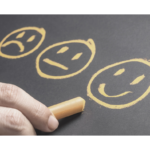
Chapter 6: Benefits: Employers and Employees
To date there’s been much debate about whether there are any benefits to employers for providing wellness programs, or to employees for participating in them.
Workplace wellness programs have a longer history than most people know, with the first programs originating in the early 1900s when labor unions campaigned for worker’s rights and as business owners saw the value of having a healthy, rested workforce.
Since then, the workforce has shifted with the changing tides of society, and there has been a rapid and significant change in the way we work. Despite this, the focus on health and wellness hasn’t really changed in response.
In this focus area you’ll learn the benefits of a holistic, bespoke wellness program that is designed to meet the unique needs of your workforce. You’ll discover why the physical, mental and emotional health in your individuals will lead to boosts in financial results, morale, motivation, satisfaction, engagement and significant stress reduction.

Chapter 7: Organizational Change
Organizational change plays a critical role in trying to do anything differently in the workplace. Change is embraced by some and actively avoided by others, and then there are those who point-blank refuse to consider anything that remotely resembles change.
But in order to keep up and remain competitive – or even to lead – in our ever-evolving business world, organizations often need to implement enterprise-wide changes that can affect their people, processes or products – and often all three at the same time.
It can be challenging to successfully implement organizational change, so it’s crucial to do everything you can to give the change you’re trying to make the greatest chance of success.
In this focus area you’ll learn what positive organizational culture is, the difference between good and bad culture, what your culture may be costing you and how a holistic approach can assist you to make the change management process easier.

Chapter 8: Personal Responsibility
The key piece that’s missing from most corporate health and wellness programs is that of the personal responsibility of each individual for their own wellbeing.
The WHO may have redefined burnout in 2019, linking it to workplace stress, but there is only so much that organizations can do to assist their employees in taking charge of their health and wellness.
Personal responsibility is the key component that must be explored for individuals to experience great health and wellness over a sustained period of time.
In this focus area you’ll learn what personal responsibility is and where it has ‘gone wrong’ up until now. You’ll also learn why personal responsibility is imperative, how to take control of it, how to change your perspective around it and the power that introducing questions into your daily life can give you when you’re in the process of taking back control.

Chapter 9: Truth, Myths and Marketing Spin
The health and wellness industry grows exponentially every year, through the use of clever marketing campaigns that blur the lines between what’s true for you, the myths that have been used to keep people locked into diet and exercise fad cycles for decades, and the marketing spin that is based around triggering fears to make you jump on to the ‘next best thing’.
In this focus area you’ll learn how to source information that is true for you and your circumstances, how you will know what’s true and therefore be able to see through the myths and the marketing spin. In doing so, you will empower yourself to create the way forward that’s perfect for you.

Chapter 10: Happiness
So many of us believe that we will be happy once we have all our ‘ducks in a row’ and we’ve achieved success. Scientific studies show us that there are three things that make most people happy, and they’re all independent from being successful. Why, then, is it necessary to be happy? Many aspects of life, including marriage, friendship, income, productivity at work, and health, are more successful for happy people.
People who are joyful are less likely to get sick and have milder symptoms when they do. People who are content are friendlier and have stronger social networks.
In this focus area you’ll learn what happiness is, the four states of happiness, how happiness impacts your health and wellness, why being happy is a choice, the myths about happiness, what you can do to create happiness and where your barriers to happiness come from.
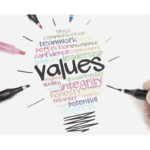
Chapter 11: Values
Do you know what values you hold?
It’s only in recent years that values have begun to be talked about, but if you don’t know what your values are, it makes it next to impossible to choose what matters most in your life.
Values play a critical role in creating the health and wellness program that is perfect for you. But first you must understand what values are on a broader level in order to respond to this question.
Your values are the things you hold dear in terms of how you live and do business. Your priorities should be based on them, and you presumably use them to gauge whether your life is going in the direction you want it to go.
This is why it’s so crucial to deliberately consider your ideals.
In this focus area you’ll learn what values are, why you need and want them, what role they play, how they work for you, how to develop them and how to use them once they’re developed.

Chapter 12: Beliefs
For generations there’s been confusion about what beliefs are and the role they play in our lives. This confusion stems from most people being unaware that beliefs stem from a place well beyond the religious connotation that they’ve been given.
The reality is that we hold beliefs about a lot of things, most of them unconsciously. Some beliefs are supported by evidence, some not. Whether they’re supported by evidence or not doesn’t matter; they’re still beliefs.
What most people aren’t aware of, however, is that your beliefs govern the way you experience your life. If you aren’t consciously questioning and probing your beliefs, then they can cause your life to stagnate. As a result you become stuck in the same position, and seriously impacting your ability to grow and develop.
You end up retreating within what you’ve done before, rather than consistently pushing and questioning your views and being willing to find new perspectives and think otherwise about the opportunities available to you.
And that creates vulnerability in a world that is changing quickly.
In this focus area you’ll learn what beliefs are, their role in your life, where they come from, the justification you create for them, whether they’re a help or a hindrance and how to evolve and change your beliefs over time.
Curriculum
Simplified Wellness – Workshop 1 – Health & Wellness: An Introduction
- Introduction to Health & Wellness
- The Current State of Play
- Health, Wellness and Well-being
- Great Expectations
- The Principles of Wellness
- Benefits: Employers & Employees
- Organizational Change
- Personal Responsibility
- Truth, Myths & Marketing Spin
- Happiness
- Values
- Beliefs
Distance Learning
Introduction
Welcome to Appleton Greene and thank you for enrolling in the Simplified Wellness corporate training program.
You will be learning using our special distance learning facilitation approach, which will allow you to put everything you learn in school into practice. The techniques and resources used in your program have been created and developed to guarantee that you get the maximum benefits and enjoyment possible.
We hope you enjoy the curriculum and find it both thought provoking and enjoyable. But if you’ve never studied remotely before, you could be feeling apprehensive about the task at hand. In order to get you started, we will provide you with some fundamental knowledge and instructions on how to use the modules effectively, how to handle the materials, and what to do as you go through them. This manual is intended to put you in the correct path and assist you in developing your skills as a successful distance learner. Before you begin studying seriously, spend a few hours reading this guide and your guide to tutorial support for students and taking notes.
Study Environment
To study, it’s often best to choose a space that is both private and peaceful. Preferably, this should be a room where you have easy access to isolation from outside distractions. Make sure the space is well-lit and has a relaxed, inviting atmosphere. Doing this will give you the opportunity to create the right frame of mind when you do spend time to studying.
A lovely fire, the option to play calming background music, mild but effective lighting, perhaps a nice view if it’s possible, and a good-sized desk with a comfy chair are a few examples of ways to make your study space more inviting.
Make sure your family is aware of your study schedule and is familiar with your study guidelines. Your learning environment is crucial. If at all feasible, having a separate study area that you can dedicate to yourself is great. If this is not possible, you will need to devote much more time to creating and maintaining your study plan because it will have an impact on both you and other people. The more attuned to learning you space is, the more easily you will be able to study.
Study Tools and Rules
Make an effort to ensure that your study materials are adequate and in good operating condition. You will require access to a computer, scanner, and printer as well as internet connectivity. You will require a good filing system in addition to a comfortable chair that supports your lower back.
Spending valuable study time trying to remedy unreliable or improperly designed study tools can be highly irritating. Make sure your study aids are current. You should also take a few study guidelines into account. You will be subject to some of these guidelines, which are meant to help you be more organised about when and how you study.
After reading this guide to distance learning, spend some time creating your study rules. You will also need to come to an agreement with your family, friends, or anyone living with you over some study guidelines. To be able to help you as you study, they too will need to practice discipline. It’s crucial to include your family and friends as active participants in your study group. Their encouragement and support may prove to be a vital factor in your ability to successfully complete the program.
Successful Distance Learning
Since individuals can learn in their own way, at their own pace, and for their own purposes, distance learners are not required to attend regular classes or seminars.
But with a distant learning program, unlike traditional internal training courses, it is the student’s job to make sure they manage their own study contribution.
Strong self-discipline, self-motivation, and a strong will to achieve are required for this. Students who prefer working alone, are adept at managing others, and are accustomed to controlling themselves are more likely to succeed as distance learners.
It’s crucial to understand your primary motivations for studying as well as the primary outcomes you hope to obtain as a result. When you need to encourage yourself, you will need to keep these goals in mind.
Keep both your short-term and long-term objectives in mind at all times.
You will need to find ways to motivate and appreciate yourself while you are studying because no one is here to spoil, take care of, or spoon-feed you information. Make sure to keep track of your academic progress so that you can be confident in your accomplishments and periodically review your goals and objectives.
Self-Assessment
All of the Appleton Greene training programs are post-graduate degrees. Consequently, you ought to be a seasoned learner with a degree in a business-related field.
As a result, you ought to be aware of your academic talents and shortcomings. What time of day, for instance, are you most productive? Are you an owl or a lark? Which research techniques do you find most effective? Are you a diligent student? How do you maintain self-control? How can you make sure you have fun while studying?
If you want to apply yourself effectively, it’s crucial to understand who you are as a student. To do this, you’ll need to do some self-evaluation early on.
Make a SWOT analysis of your academic career. Describe your internal and external opportunities and threats, as well as your strengths and shortcomings as a student.
Later on, when you are making a study plan, this will be useful. Then, you can include elements in your study schedule to make sure you are playing to your strengths and making up for your inadequacies. Additionally, you can make sure that you take full use of your possibilities while avoiding any dangers to your success.
Accepting Responsibility as a Student
Training programs almost always entail a sizable investment, both in terms of money and the amount of time you must devote to studying, and the student bears the entire burden of responsibility for their effective completion.
This is never more obvious than when a student is taking a course remotely.
A crucial step in ensuring that you can successfully complete your training program is accepting responsibility as a student. When anything goes wrong, it is simple to point the finger at other people or situations. However, the reality is that if a failure is your fault, you have the power to correct it; the decision rests totally with you.
You are helpless to change the situation if it is always someone else’s fault. Due to the fact that each student is an individual and that what works for one student may not necessarily work for another, every student studies in a completely different manner.
You must take personal responsibility for figuring out how to create, carry out, and maintain a personalised study plan if you want to succeed. You are the only one to blame if you don’t succeed.
Planning
The sense of not being in control is by far the most important factor contributing to stress. Without planning, we have a tendency to be reactive and can stumble from one obstacle to another, hoping that all will work out in the end. Almost always, they don’t!
We must be certain of the steps we want to take and when we want to take them in order to be in charge. Additionally, we must take into account as many potential outcomes as we can so that we are ready for them when they occur.
Compared to emergent change, prescriptive change is much simpler to govern and control.
This also applies to distance learning. If you believe that you are in charge and that everything is going according to plan, it is much simpler and more fun.
Even if something does go wrong, you are ready for it and can respond to it without being overly stressed. It is crucial that you do take the time to carefully plan your academic schedule.
Management
It is equally crucial to make sure you oversee its implementation once you have created a clear study plan.
The majority of us often enjoy planning, but implementation is usually when things go wrong. We don’t know why goals aren’t being met.
At times, we are unsure even if our goals have been reached. We cannot simply draw the conclusion that the study strategy was unsuccessful. If it isn’t working, you’ll need to know what to do to fix it.
Similarly, even if your study strategy is working, you still need to know why so that you can keep getting results.
Therefore, you need to have self-assessment criteria so that you can consistently increase performance throughout the program. Your performance should continue to advance throughout the program if you handle things properly.
Study Objectives and Tasks
Creating your program objectives is where you should start first. These should feature your priorities and reasons for enrolling in the training program.
To avoid confusion, keep them brief and to the point. Don’t just jot down the first ideas that occur to mind because they probably overlap too much.
List potential department names like “customer service,” “e-business,” “finance,” “globalisation,” “human resources,” “technology,” “legal,” “management,” “marketing,” and “production.” List as many goals under each heading as possible to generate ideas, and then rearrange these goals according to importance.
Finally, identify the most important item under each department heading to serve as your program’s goals.
Try to limit yourself to five, as doing so will help you concentrate. If the main goals are all accomplished, it is likely that the other items you stated will be as well. Simply go through the procedure once more if this is not the case.
Study Forecast
Depending on your availability and ongoing obligations, the Appleton Greene Simplified Wellness corporate training program should be finished in 12 to 18 months.
Whilst the program is designed to be completed in a 12 month period, every student is an individual with varying commitments and production levels, which accounts for the wide variation in time estimations.
The fact that this is a distance learning program that integrates the practical integration of academic theory as an as a part of the training program then magnifies these distinctions. Because every project study is based on actual data, crucial choices and trade-offs must be made. To guarantee that everything goes according to plan, you’ll need to be patient with your expectations. We would always advise you to use caution when making your own task and time estimates, but you must still create them and have a good understanding of what are reasonable expectations in your particular situation.
Regarding your time planning, think about how much time you can realistically devote to studying with the program each week. Then, using the guidelines provided here, estimate how long it should take you to complete the program. Finally, divide the program into logical modules and allot an appropriate amount of time to each one; these will be your milestones. You can make a time plan using a computer spreadsheet or a personal organiser like Mimio.
Refer to your list of tasks that must be completed in order to meet your program’s objectives when planning your tasks; Calculate each task’s implementation date in relation to your time plan, keeping in mind that you are not estimating when your objectives will be met but rather when you will need to concentrate on implementing the corresponding tasks.
You also need to make sure that each task is carried out in conjunction with the relevant training modules that are associated with it. the next step is to divide each activity into a list of particular to-dos, say 10 for each task, and add these to your study plan; Once more, you might create your study plan using MS Outlook to include your time and task management.
You could also use a project management tool like MS Project. Now that you know when you can anticipate being able to take action to complete the tasks necessary to fulfil your program objectives, you should have a clear and realistic prediction.
Performance Management
Creating a study forecast is one thing, but tracking your progress is quite another.
In the end, it matters less if you meet your initial research forecast than how frequently you revise it to keep it reasonable and in line with your performance.
You will have a better understanding of your own performance and productivity levels as a distance learner as you progress through the program. You should reevaluate your study forecast after finishing your first study module so that it accurately reflects the amount of achievement you really accomplished.
You must first time yourself while practicing by utilising an alarm clock in order to achieve this. Set the alarm for hourly intervals, and then record your progress throughout the course of each hour. After that, you can record your actual performance on your study plan and compare it to your forecast.
Then, whether they were good or bad, think about the factors that led to your performance level and thoughtfully change your future forecasts as a result. With time, you ought to begin routinely hitting your forecasts.
Time yourself while you are studying and record the actual time taken in your study plan. Think about your time-efficiency successes and the reasons for each success when reviewing future time planning. Think about your time-efficiency failures and the reasons for each failure when reviewing future time planning. Re-evaluate your study strategy.
You must consistently manage your time otherwise you will never finish your academics. This will either happen because you are not dedicating enough time to your studies or because you are using your study time less effectively. Keep in mind that if you let your studies go out of control, they can end up adding to your stress.
Consider your successes with task-efficiency and the reasons for the success in each case; take this into consideration when reviewing future task planning. Consider your failures with task-efficiency and the reasons for the failures in each case; take this into consideration when reviewing future task planning. Time yourself while you are studying and make a note of the actual tasks that you have undertaken in your study plan. If you don’t manage your tasks consistently, you won’t be able to tell if your program objectives are being met or not.
Keeping in Touch
You will have access to qualified professors and tutors who are competent and experienced and who are in charge of giving tutorial help for your specific training program. Therefore, don’t be afraid to let them know how you’re doing. We save electronic copies of all emails sent in support of tutorials so that instructors and tutors can examine earlier exchanges before deciding how to react to a specific request.
Additionally, it means that all correspondence between you and your instructors and tutors is documented, preventing any needless repetition, misunderstanding, or misinterpretation. Send them an email if you are experiencing any issues with the program.
Since they are more than likely to have dealt with a situation similar to yours before, they can frequently offer valuable advice and point you in the correct way. Please refer to the Tutorial Support section of this student information guide for more information on when and how to use tutorial support. This will enable you to make the most of the tutorial support that is offered to you and will eventually help you succeed in and enjoy your training program.
Work Colleagues and Family
It is important to share your program study progress with your family, friends, and coworkers.
The training courses offered by Appleton Greene are highly useful. It’s part of the program to seek out information from others, collaborate with others to plan, develop, and implement processes, and get feedback from them on the processes’ feasibility and productivity. As a result, you’ll have lots of chances to put your theories to the test and get feedback from others.
Don’t keep your feelings within; people are often understanding of distance learners. Get outside and spread the word! Your family, coworkers, and friends are probably going to gain from your efforts with the program, therefore they are probably more interested in getting engaged than you might imagine. Don’t be afraid to assign tasks to others who could gain from them. This is a fantastic method to get buy-in and understanding from those that you may later depend on for process implementation. Talk about your experiences with your loved ones.
Making It Relevant
Making information relevant to your own unique situation is the key to learning effectively. You should constantly be attempting to draw connections between the program’s content and your personal situation. Remember that this is the most crucial and satisfying step in turning your studies into genuine self-improvement, whether you accomplish it alone or in conversation with your family, clients, or colleagues.
Be specific about how you hope to benefit from the program. This entails establishing precise study goals related to the course’s material in terms of comprehension, concepts, completing research or review exercises, and connecting the material to your own situation. As you progress through the program, it is understandable for your goals to change. In this situation, you should update your study plan with the new goals, so you always know what you are aiming for, when, and why.
Distance Learning Checklist
• Prepare your workspace, materials, and norms for studying.
• Detailed self-evaluation of your capacity for learning should be done.
• Make a structure for your study schedule.
• Take into account your study goals and assignments.
• Make a forecast for the study.
• Analyze your academic performance.
• Review the prediction from your study.
• When organising your study schedule, be consistent.
• For tutorial assistance, contact an Appleton Greene Certified Learning Provider (CLP).
• Be sure to stay in touch with those in your vicinity.

Tutorial Support
Programs
Appleton Greene uses standard and bespoke corporate training programs as vessels to transfer business process improvement knowledge into the heart of our clients’ organizations. Each individual program focuses upon the implementation of a specific business process, which enables clients to easily quantify their return on investment. There are hundreds of established Appleton Greene corporate training products now available to clients within customer services, e-business, finance, globalization, human resources, information technology, legal, management, marketing and production. It does not matter whether a client’s employees are located within one office, or an unlimited number of international offices, we can still bring them together to learn and implement specific business processes collectively. Our approach to global localization enables us to provide clients with a truly international service with that all important personal touch. Appleton Greene corporate training programs can be provided virtually or locally and they are all unique in that they individually focus upon a specific business function. They are implemented over a sustainable period of time and professional support is consistently provided by qualified learning providers and specialist consultants.
Support available
You will have a designated Certified Learning Provider (CLP) and an Accredited Consultant and we encourage you to communicate with them as much as possible. In all cases tutorial support is provided online because we can then keep a record of all communications to ensure that tutorial support remains consistent. You would also be forwarding your work to the tutorial support unit for evaluation and assessment. You will receive individual feedback on all of the work that you undertake on a one-to-one basis, together with specific recommendations for anything that may need to be changed in order to achieve a pass with merit or a pass with distinction and you then have as many opportunities as you may need to re-submit project studies until they meet with the required standard. Consequently the only reason that you should really fail (CLP) is if you do not do the work. It makes no difference to us whether a student takes 12 months or 18 months to complete the program, what matters is that in all cases the same quality standard will have been achieved.
Support Process
Please forward all of your future emails to the designated (CLP) Tutorial Support Unit email address that has been provided and please do not duplicate or copy your emails to other AGC email accounts as this will just cause unnecessary administration. Please note that emails are always answered as quickly as possible but you will need to allow a period of up to 20 business days for responses to general tutorial support emails during busy periods, because emails are answered strictly within the order in which they are received. You will also need to allow a period of up to 30 business days for the evaluation and assessment of project studies. This does not include weekends or public holidays. Please therefore kindly allow for this within your time planning. All communications are managed online via email because it enables tutorial service support managers to review other communications which have been received before responding and it ensures that there is a copy of all communications retained on file for future reference. All communications will be stored within your personal (CLP) study file here at Appleton Greene throughout your designated study period. If you need any assistance or clarification at any time, please do not hesitate to contact us by forwarding an email and remember that we are here to help. If you have any questions, please list and number your questions succinctly and you can then be sure of receiving specific answers to each and every query.
Time Management
It takes approximately 1 Year to complete the Simplified Wellness corporate training program, incorporating 12 x 6-hour monthly workshops. Each student will also need to contribute approximately 4 hours per week over 1 Year of their personal time. Students can study from home or work at their own pace and are responsible for managing their own study plan. There are no formal examinations and students are evaluated and assessed based upon their project study submissions, together with the quality of their internal analysis and supporting documents. They can contribute more time towards study when they have the time to do so and can contribute less time when they are busy. All students tend to be in full time employment while studying and the Simplified Wellness program is purposely designed to accommodate this, so there is plenty of flexibility in terms of time management. It makes no difference to us at Appleton Greene, whether individuals take 12-18 months to complete this program. What matters is that in all cases the same standard of quality will have been achieved with the standard and bespoke programs that have been developed.
Distance Learning Guide
The distance learning guide should be your first port of call when starting your training program. It will help you when you are planning how and when to study, how to create the right environment and how to establish the right frame of mind. If you can lay the foundations properly during the planning stage, then it will contribute to your enjoyment and productivity while training later. The guide helps to change your lifestyle in order to accommodate time for study and to cultivate good study habits. It helps you to chart your progress so that you can measure your performance and achieve your goals. It explains the tools that you will need for study and how to make them work. It also explains how to translate academic theory into practical reality. Spend some time now working through your distance learning guide and make sure that you have firm foundations in place so that you can make the most of your distance learning program. There is no requirement for you to attend training workshops or classes at Appleton Greene offices. The entire program is undertaken online, program course manuals and project studies are administered via the Appleton Greene web site and via email, so you are able to study at your own pace and in the comfort of your own home or office as long as you have a computer and access to the internet.
How To Study
The how to study guide provides students with a clear understanding of the Appleton Greene facilitation via distance learning training methods and enables students to obtain a clear overview of the training program content. It enables students to understand the step-by-step training methods used by Appleton Greene and how course manuals are integrated with project studies. It explains the research and development that is required and the need to provide evidence and references to support your statements. It also enables students to understand precisely what will be required of them in order to achieve a pass with merit and a pass with distinction for individual project studies and provides useful guidance on how to be innovative and creative when developing your Unique Program Proposition (UPP).
Tutorial Support
Tutorial support for the Appleton Greene Simplified Wellness corporate training program is provided online either through the Appleton Greene Client Support Portal (CSP), or via email. All tutorial support requests are facilitated by a designated Program Administration Manager (PAM). They are responsible for deciding which professor or tutor is the most appropriate option relating to the support required and then the tutorial support request is forwarded onto them. Once the professor or tutor has completed the tutorial support request and answered any questions that have been asked, this communication is then returned to the student via email by the designated Program Administration Manager (PAM). This enables all tutorial support, between students, professors and tutors, to be facilitated by the designated Program Administration Manager (PAM) efficiently and securely through the email account. You will therefore need to allow a period of up to 20 business days for responses to general support queries and up to 30 business days for the evaluation and assessment of project studies, because all tutorial support requests are answered strictly within the order in which they are received. This does not include weekends or public holidays. Consequently you need to put some thought into the management of your tutorial support procedure in order to ensure that your study plan is feasible and to obtain the maximum possible benefit from tutorial support during your period of study. Please retain copies of your tutorial support emails for future reference. Please ensure that ALL of your tutorial support emails are set out using the format as suggested within your guide to tutorial support. Your tutorial support emails need to be referenced clearly to the specific part of the course manual or project study which you are working on at any given time. You also need to list and number any questions that you would like to ask, up to a maximum of five questions within each tutorial support email. Remember the more specific you can be with your questions the more specific your answers will be too and this will help you to avoid any unnecessary misunderstanding, misinterpretation, or duplication. The guide to tutorial support is intended to help you to understand how and when to use support in order to ensure that you get the most out of your training program. Appleton Greene training programs are designed to enable you to do things for yourself. They provide you with a structure or a framework and we use tutorial support to facilitate students while they practically implement what they learn. In other words, we are enabling students to do things for themselves. The benefits of distance learning via facilitation are considerable and are much more sustainable in the long-term than traditional short-term knowledge sharing programs. Consequently you should learn how and when to use tutorial support so that you can maximize the benefits from your learning experience with Appleton Greene. This guide describes the purpose of each training function and how to use them and how to use tutorial support in relation to each aspect of the training program. It also provides useful tips and guidance with regard to best practice.
Tutorial Support Tips
Students are often unsure about how and when to use tutorial support with Appleton Greene. This Tip List will help you to understand more about how to achieve the most from using tutorial support. Refer to it regularly to ensure that you are continuing to use the service properly. Tutorial support is critical to the success of your training experience, but it is important to understand when and how to use it in order to maximize the benefit that you receive. It is no coincidence that those students who succeed are those that learn how to be positive, proactive and productive when using tutorial support.
Be positive and friendly with your tutorial support emails
Remember that if you forward an email to the tutorial support unit, you are dealing with real people. “Do unto others as you would expect others to do unto you”. If you are positive, complimentary and generally friendly in your emails, you will generate a similar response in return. This will be more enjoyable, productive and rewarding for you in the long-term.
Think about the impression that you want to create
Every time that you communicate, you create an impression, which can be either positive or negative, so put some thought into the impression that you want to create. Remember that copies of all tutorial support emails are stored electronically and tutors will always refer to prior correspondence before responding to any current emails. Over a period of time, a general opinion will be arrived at in relation to your character, attitude and ability. Try to manage your own frustrations, mood swings and temperament professionally, without involving the tutorial support team. Demonstrating frustration or a lack of patience is a weakness and will be interpreted as such. The good thing about communicating in writing, is that you will have the time to consider your content carefully, you can review it and proof-read it before sending your email to Appleton Greene and this should help you to communicate more professionally, consistently and to avoid any unnecessary knee-jerk reactions to individual situations as and when they may arise. Please also remember that the CLP Tutorial Support Unit will not just be responsible for evaluating and assessing the quality of your work, they will also be responsible for providing recommendations to other learning providers and to client contacts within the Appleton Greene global client network, so do be in control of your own emotions and try to create a good impression.
Remember that quality is preferred to quantity
Please remember that when you send an email to the tutorial support team, you are not using Twitter or Text Messaging. Try not to forward an email every time that you have a thought. This will not prove to be productive either for you or for the tutorial support team. Take time to prepare your communications properly, as if you were writing a professional letter to a business colleague and make a list of queries that you are likely to have and then incorporate them within one email, say once every month, so that the tutorial support team can understand more about context, application and your methodology for study. Get yourself into a consistent routine with your tutorial support requests and use the tutorial support template provided with ALL of your emails. The (CLP) Tutorial Support Unit will not spoon-feed you with information. They need to be able to evaluate and assess your tutorial support requests carefully and professionally.
Be specific about your questions in order to receive specific answers
Try not to write essays by thinking as you are writing tutorial support emails. The tutorial support unit can be unclear about what in fact you are asking, or what you are looking to achieve. Be specific about asking questions that you want answers to. Number your questions. You will then receive specific answers to each and every question. This is the main purpose of tutorial support via email.
Keep a record of your tutorial support emails
It is important that you keep a record of all tutorial support emails that are forwarded to you. You can then refer to them when necessary and it avoids any unnecessary duplication, misunderstanding, or misinterpretation.
Individual training workshops or telephone support
Please be advised that Appleton Greene does not provide separate or individual tutorial support meetings, workshops, or provide telephone support for individual students. Appleton Greene is an equal opportunities learning and service provider and we are therefore understandably bound to treat all students equally. We cannot therefore broker special financial or study arrangements with individual students regardless of the circumstances. All tutorial support is provided online and this enables Appleton Greene to keep a record of all communications between students, professors and tutors on file for future reference, in accordance with our quality management procedure and your terms and conditions of enrolment. All tutorial support is provided online via email because it enables us to have time to consider support content carefully, it ensures that you receive a considered and detailed response to your queries. You can number questions that you would like to ask, which relate to things that you do not understand or where clarification may be required. You can then be sure of receiving specific answers to each individual query. You will also then have a record of these communications and of all tutorial support, which has been provided to you. This makes tutorial support administration more productive by avoiding any unnecessary duplication, misunderstanding, or misinterpretation.
Tutorial Support Email Format
You should use this tutorial support format if you need to request clarification or assistance while studying with your training program. Please note that ALL of your tutorial support request emails should use the same format. You should therefore set up a standard email template, which you can then use as and when you need to. Emails that are forwarded to Appleton Greene, which do not use the following format, may be rejected and returned to you by the (CLP) Program Administration Manager. A detailed response will then be forwarded to you via email usually within 20 business days of receipt for general support queries and 30 business days for the evaluation and assessment of project studies. This does not include weekends or public holidays. Your tutorial support request, together with the corresponding TSU reply, will then be saved and stored within your electronic TSU file at Appleton Greene for future reference.
Subject line of your email
Please insert: Appleton Greene (CLP) Tutorial Support Request: (Your Full Name) (Date), within the subject line of your email.
Main body of your email
Please insert:
1. Appleton Greene Certified Learning Provider (CLP) Tutorial Support Request
2. Your Full Name
3. Date of TS request
4. Preferred email address
5. Backup email address
6. Course manual page name or number (reference)
7. Project study page name or number (reference)
Subject of enquiry
Please insert a maximum of 50 words (please be succinct)
Briefly outline the subject matter of your inquiry, or what your questions relate to.
Question 1
Maximum of 50 words (please be succinct)
Maximum of 50 words (please be succinct)
Question 3
Maximum of 50 words (please be succinct)
Question 4
Maximum of 50 words (please be succinct)
Question 5
Maximum of 50 words (please be succinct)
Please note that a maximum of 5 questions is permitted with each individual tutorial support request email.
Procedure
* List the questions that you want to ask first, then re-arrange them in order of priority. Make sure that you reference them, where necessary, to the course manuals or project studies.
* Make sure that you are specific about your questions and number them. Try to plan the content within your emails to make sure that it is relevant.
* Make sure that your tutorial support emails are set out correctly, using the Tutorial Support Email Format provided here.
* Save a copy of your email and incorporate the date sent after the subject title. Keep your tutorial support emails within the same file and in date order for easy reference.
* Allow up to 20 business days for a response to general tutorial support emails and up to 30 business days for the evaluation and assessment of project studies, because detailed individual responses will be made in all cases and tutorial support emails are answered strictly within the order in which they are received.
* Emails can and do get lost. So if you have not received a reply within the appropriate time, forward another copy or a reminder to the tutorial support unit to be sure that it has been received but do not forward reminders unless the appropriate time has elapsed.
* When you receive a reply, save it immediately featuring the date of receipt after the subject heading for easy reference. In most cases the tutorial support unit replies to your questions individually, so you will have a record of the questions that you asked as well as the answers offered. With project studies however, separate emails are usually forwarded by the tutorial support unit, so do keep a record of your own original emails as well.
* Remember to be positive and friendly in your emails. You are dealing with real people who will respond to the same things that you respond to.
* Try not to repeat questions that have already been asked in previous emails. If this happens the tutorial support unit will probably just refer you to the appropriate answers that have already been provided within previous emails.
* If you lose your tutorial support email records you can write to Appleton Greene to receive a copy of your tutorial support file, but a separate administration charge may be levied for this service.

How To Study
Your Certified Learning Provider (CLP) and Accredited Consultant can help you to plan a task list for getting started so that you can be clear about your direction and your priorities in relation to your training program. It is also a good way to introduce yourself to the tutorial support team.
Planning your study environment
Your study conditions are of great importance and will have a direct effect on how much you enjoy your training program. Consider how much space you will have, whether it is comfortable and private and whether you are likely to be disturbed. The study tools and facilities at your disposal are also important to the success of your distance-learning experience. Your tutorial support unit can help with useful tips and guidance, regardless of your starting position. It is important to get this right before you start working on your training program.
Planning your program objectives
It is important that you have a clear list of study objectives, in order of priority, before you start working on your training program. Your tutorial support unit can offer assistance here to ensure that your study objectives have been afforded due consideration and priority.
Planning how and when to study
Distance-learners are freed from the necessity of attending regular classes, since they can study in their own way, at their own pace and for their own purposes. This approach is designed to let you study efficiently away from the traditional classroom environment. It is important however, that you plan how and when to study, so that you are making the most of your natural attributes, strengths and opportunities. Your tutorial support unit can offer assistance and useful tips to ensure that you are playing to your strengths.
Planning your study tasks
You should have a clear understanding of the study tasks that you should be undertaking and the priority associated with each task. These tasks should also be integrated with your program objectives. The distance learning guide and the guide to tutorial support for students should help you here, but if you need any clarification or assistance, please contact your tutorial support unit.
Planning your time
You will need to allocate specific times during your calendar when you intend to study if you are to have a realistic chance of completing your program on time. You are responsible for planning and managing your own study time, so it is important that you are successful with this. Your tutorial support unit can help you with this if your time plan is not working.
Keeping in touch
Consistency is the key here. If you communicate too frequently in short bursts, or too infrequently with no pattern, then your management ability with your studies will be questioned, both by you and by your tutorial support unit. It is obvious when a student is in control and when one is not and this will depend how able you are at sticking with your study plan. Inconsistency invariably leads to in-completion.
Charting your progress
Your tutorial support team can help you to chart your own study progress. Refer to your distance learning guide for further details.
Making it work
To succeed, all that you will need to do is apply yourself to undertaking your training program and interpreting it correctly. Success or failure lies in your hands and your hands alone, so be sure that you have a strategy for making it work. Your Certified Learning Provider (CLP) and Accredited Consultant can guide you through the process of program planning, development and implementation.
Reading methods
Interpretation is often unique to the individual but it can be improved and even quantified by implementing consistent interpretation methods. Interpretation can be affected by outside interference such as family members, TV, or the Internet, or simply by other thoughts which are demanding priority in our minds. One thing that can improve our productivity is using recognized reading methods. This helps us to focus and to be more structured when reading information for reasons of importance, rather than relaxation.
Speed reading
When reading through course manuals for the first time, subconsciously set your reading speed to be just fast enough that you cannot dwell on individual words or tables. With practice, you should be able to read an A4 sheet of paper in one minute. You will not achieve much in the way of a detailed understanding, but your brain will retain a useful overview. This overview will be important later on and will enable you to keep individual issues in perspective with a more generic picture because speed reading appeals to the memory part of the brain. Do not worry about what you do or do not remember at this stage.
Content reading
Once you have speed read everything, you can then start work in earnest. You now need to read a particular section of your course manual thoroughly, by making detailed notes while you read. This process is called Content Reading and it will help to consolidate your understanding and interpretation of the information that has been provided.
Making structured notes on the course manuals
When you are content reading, you should be making detailed notes, which are both structured and informative. Make these notes in a MS Word document on your computer, because you can then amend and update these as and when you deem it to be necessary. List your notes under three headings: 1. Interpretation – 2. Questions – 3. Tasks. The purpose of the 1st section is to clarify your interpretation by writing it down. The purpose of the 2nd section is to list any questions that the issue raises for you. The purpose of the 3rd section is to list any tasks that you should undertake as a result. Anyone who has graduated with a business-related degree should already be familiar with this process.
Organizing structured notes separately
You should then transfer your notes to a separate study notebook, preferably one that enables easy referencing, such as a MS Word Document, a MS Excel Spreadsheet, a MS Access Database, or a personal organizer on your cell phone. Transferring your notes allows you to have the opportunity of cross-checking and verifying them, which assists considerably with understanding and interpretation. You will also find that the better you are at doing this, the more chance you will have of ensuring that you achieve your study objectives.
Question your understanding
Do challenge your understanding. Explain things to yourself in your own words by writing things down.
Clarifying your understanding
If you are at all unsure, forward an email to your tutorial support unit and they will help to clarify your understanding.
Question your interpretation
Do challenge your interpretation. Qualify your interpretation by writing it down.
Clarifying your interpretation
If you are at all unsure, forward an email to your tutorial support unit and they will help to clarify your interpretation.
Qualification Requirements
The student will need to successfully complete the project study and all of the exercises relating to the Simplified Wellness corporate training program, achieving a pass with merit or distinction in each case, in order to qualify as an Accredited Simplified Wellness Specialist (ASWS). All monthly workshops need to be tried and tested within your company. These project studies can be completed in your own time and at your own pace and in the comfort of your own home or office. There are no formal examinations, assessment is based upon the successful completion of the project studies. They are called project studies because, unlike case studies, these projects are not theoretical, they incorporate real program processes that need to be properly researched and developed. The project studies assist us in measuring your understanding and interpretation of the training program and enable us to assess qualification merits. All of the project studies are based entirely upon the content within the training program and they enable you to integrate what you have learnt into your corporate training practice.
Simplified Wellness – Grading Contribution
Project Study – Grading Contribution
Customer Service – 10%
E-business – 05%
Finance – 10%
Globalization – 10%
Human Resources – 10%
Information Technology – 10%
Legal – 05%
Management – 10%
Marketing – 10%
Production – 10%
Education – 05%
Logistics – 05%
TOTAL GRADING – 100%
Qualification grades
A mark of 90% = Pass with Distinction.
A mark of 75% = Pass with Merit.
A mark of less than 75% = Fail.
If you fail to achieve a mark of 75% with a project study, you will receive detailed feedback from the Certified Learning Provider (CLP) and/or Accredited Consultant, together with a list of tasks which you will need to complete, in order to ensure that your project study meets with the minimum quality standard that is required by Appleton Greene. You can then re-submit your project study for further evaluation and assessment. Indeed you can re-submit as many drafts of your project studies as you need to, until such a time as they eventually meet with the required standard by Appleton Greene, so you need not worry about this, it is all part of the learning process.
When marking project studies, Appleton Greene is looking for sufficient evidence of the following:
Pass with merit
A satisfactory level of program understanding
A satisfactory level of program interpretation
A satisfactory level of project study content presentation
A satisfactory level of Unique Program Proposition (UPP) quality
A satisfactory level of the practical integration of academic theory
Pass with distinction
An exceptional level of program understanding
An exceptional level of program interpretation
An exceptional level of project study content presentation
An exceptional level of Unique Program Proposition (UPP) quality
An exceptional level of the practical integration of academic theory
Preliminary Analysis
To be able to effectively understand the role that health and wellness plays in our lives, it’s important to understand what it actually is, where it has come from and how we can best apply it to our personal circumstances to create the solution that is perfect for our circumstances.
To many of us, health and wellness seem to be relatively new terms, particularly in the context of their role in the workplace. The reality is that there have been health and wellness industries for centuries, and they have held their own place in global economies for decades, albeit with a more recent morph into the workplace sectors as well.
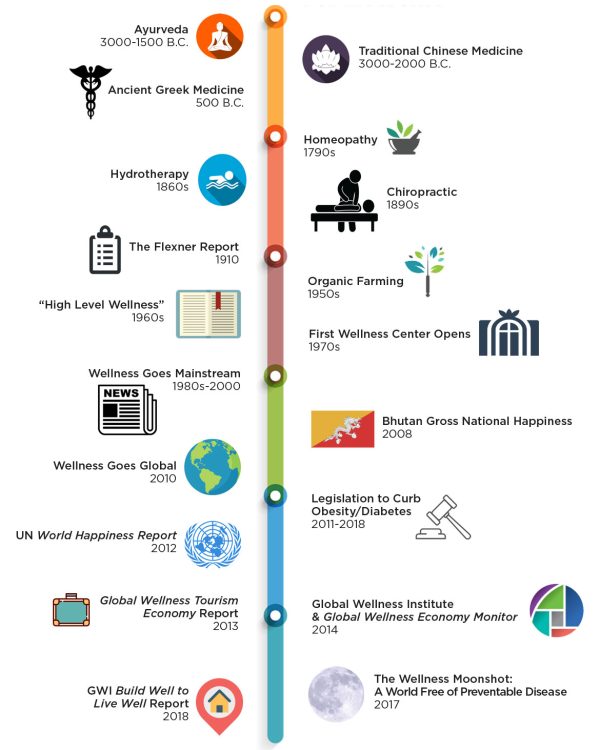
You can read more about the history of the health and wellness industries here:
www.globalwellnessinstitute.org
Some of the key drivers of health and wellness today are:
• Lifestyle and environmental disease
• Loneliness and mental health
• Population aging
• Pollution
• Agriculture and food
• Care dependence and unwell lifestyles
• Failing health systems
• Unsustainable economic costs of healthcare
• Urbanisation and middle-class growth
• Awareness and self-responsibility
• Technology and connectivity
These key factors will force change in the global health and wellness industry for years to come and will see the industry revolutionise itself in response to global demands.
The wellness economy is already expanding to include new facets, including things such as mental health, workplace wellness and wellness real estate demands. These have been added to the existing sectors of physical health, wellness tourism, the spa industry and thermal/mineral springs.
You can read more about the key drivers of wellness here:
www.globalwellnessinstitute.org
Further Reading
Article: The history of wellness
It seems that wellness is a relatively new focus that has arisen in response to our increasingly chaotic lifestyles and stressful careers. We practice wellness in order to better balance our life and be happier, but the origins of wellness go back far longer than many of us realize. In fact, wellness is a very ancient practice.
In Ancient Practice
In ancient practice, wellness can be found in every religion that focuses on the harmony of the spirit and the body. It can be traced as far back as 3000 B.C.E. in Ayurveda as an oral tradition, later being transcribed into the four sacred Hindu texts, the Vedas. Wellness practice can also be found in ancient Chinese history, as they developed the world’s first system of medicine based on the practices of Buddhism and Taoism. Examples of these wellness practices include acupuncture and herbal medicines.
In the west, there are instances of wellness found in ancient Greek and ancient Roman societies. Hippocrates argued that illness came about from poor lifestyle choices and the Romans, in turn, adopted the Greek beliefs and as a result developed a public health system including one of the first instances of aqueducts and sewers to help minimize the spread of disease.
To continue reading this article, please visit:
Article: Wellness Tourism – The Past, the Present and the Future
Forty years ago, when health resorts first came to the forefront as an option for travel, there were just a few dozen of what would eventually become known as the original “Destination Spas”. Destination spas were different than resort spas as they would truly have an educational component to the vacation.
The focus was not meant to be just on relaxation, but in addition a wholehearted effort to get guests to bring what they learned on vacation home. In addition to spa treatments, a full program of fitness classes and healthy spa cuisine was offered, one that that emphasized whole grains, fruits and vegetables. This was the beginning of the wellness tourism boom, though that is not what it was called at the time.
The true origin of wellness tourism goes back to the first group of people who discovered that the clean fresh mountain air and healing hot springs cured whatever it was that ailed them. At the destination spas of the past few decades, ancient traditions have been mixed with modern improvements to enhance our lives in this stressful, wired world.
To continue reading this article, please visit:
www.magazine.medicaltourism.com
Article: The Rise of Workplace Wellness
For wellness practitioners, it is clear that the more things change, the more they remain the same.
Workplace fitness programs we enjoy today can be traced back to executive fitness programs started after World War II by business leaders wanting to promote healthy lifestyles in the workplace.
John F. Kennedy once said: “Change is the law of life. And those who look only to the past and present are certain to miss the future.” Anyone working in the wellness industry and seeking to find a path forward in this post-COVID-19 pandemic era should keep this quote in mind. For wellness practitioners, it is clear that the more things change, the more they remain the same. Welcome to the new normal.
A study of workplace wellness activities since the 1950s indicates corporate wellness programs have benefitted the company more than employees. While the availability of specific health-related resources may have increased worker safety and productivity, programs were fundamentally about managing costs and mitigating risks.
Although cost containment remains an important aspect of employee wellness programs, the primary driver behind today’s programs is to improve the health of the workforce. This benefits the employer too because it is much less expensive to retain existing talent than to recruit new talent.
To continue reading this article, please visit:
Course Manuals 1-12

Course Manual 1: Introduction to Health and Wellness
Introduction
The world is rapidly shifting its perspective on health and wellness and it’s fast becoming the number one focus in most people’s lives. A willingness to dedicate 100% of focus to the workplace is being superseded by a loudly spoken requirement for people to have health and wellness as their first concern, and then turn to the needs of the organization they work for as a secondary consideration.
Thanks to the evolution of technology there’s no longer anywhere for organizations to hide, and there’s no way of getting away with anything other than best practice for fear of being publicly shamed.
With the rise in popularity of wellness trends and the escapism that’s offered through wellness tourism, people are now demanding a different relationship with their employer so that they can experience life in a different way.
It’s clear that there’s an evolution under way around the way that people are now prepared to live their lives, and the expectations they have on who is responsible for helping them get there.

What is health?
Health refers to a state in which the physical body is free from sickness.
According to the World Health Organization (WHO), health is “a condition of total physical, mental, and social wellbeing and not only the absence of disease or disability”.
Over time, the term ‘health’ has been used to create new definitions and has begun to be applied in different ways. For example, the term ‘healthy behavior’ is seen more and more often now. How often have you seen things that encourage you to engage in ‘healthy’ activities such as eating well, regular exercise and getting enough sleep? Conversely, ‘health’ is also now applied to ‘unhealthy’ behaviors such as smoking, high levels of stress, and eating poorly.
Health can also be applied to personal decisions that are made around things such as engaging in high-risk activities (like skydiving, bungee jumping and the like) and can also be seen as the result of a lack of access to essential healthcare services.
Then there’s the individual versus community applications of health where hereditary illness and social conditioning play a part in health.
As you can see, there’s so much to such a small word. It’s no wonder there’s so much confusion and so many people are off track with their individual health.

What is wellness?
Wellness refers to an entire state of balance between a person’s physical, social, spiritual, emotional, intellectual, environmental, and occupational wellbeing.
When a person consistently makes decisions that will advance their health and fulfilment, they will have achieved wellness. Overall health directly affects wellness.
A few significant facets of your lifestyle are regarded as elements of general wellness. They consist of awareness, exercise, good nutrition, and social connection.
Your physical and mental health are affected by each. You will be well on your way to lowering stress, having great social connections, and reaching optimum wellness by consistently making straightforward and healthy decisions.
Workplace wellness boosts both employee health and an organization’s financial line. Developing a culture of health and wellness at work enhances employee lives, maintains staff morale, and contributes to an organization’s success.
To understand how the health and wellness industries arrived at where we currently are, it’s useful to explore where they came from, how they evolved and the significant developments that have influenced their growth along the way.
Where did ‘health’ come from?
One of the most essential experiences of modern life is that of health and disease.
The theories that people from different cultures have employed to try to comprehend and react to those experiences have to do with how people interact with society and nature. Diagnosis and treatment, professional attitudes and behaviors, patient coping strategies, social attitudes and structures, the nature of moral judgments, and the cultural meaning of activities associated with sickness and wellness are all profoundly impacted by the conceptions of health and disease.

Health and sickness are not only medical phrases; they are equally important concepts in sociology, psychology, philosophy and theology. In fact, because medicine deals with the nature and fate of humans, these very disciplines serve to continually remind medicine of its distinctively anthropological origin.
The polar opposite categories of natural sciences and human sciences cannot be used as a foundation for understanding medicine or the notions of health and sickness with which it deals.
Nature and culture must be connected in order to comprehend health and sickness, just as medicine cannot be limited to either of the two.
Just as it has been for developing a universally accurate definition of disease, a definition of health has proven to be difficult to come up with. Although these two types of concepts have not always been clearly distinguished in the historical development of these ideas, health and disease are physical, social, psychological and spiritual phenomena that can be represented in both normative (meaning based on norms) and descriptive (meaning based on definitions) concepts.
Humans not only individually choose what will be considered to be “in good health” and what will be considered to be “disease”, but they also interpret these experiences and then choose how to react to them.
Medicine, and our expectations of it, have changed dramatically over time.
Pain and illness are an inevitable part of life; history bears witness to this. The skeletons of the earliest humans (500,000 B.C.E.) show fractures and abnormalities in the bones. Because statements about the health and illness of historically primitive peoples must rely on finite and problematic textual, archaeological, and paleopathological sources, it is challenging to provide reliable descriptions of those conditions.
In ancient times there have been several well-known and documented individuals – Socrates, Hippocrates, Galen, Plato and Aristotle – who contributed greatly to the body of knowledge that is now commonly referred to as ‘medicine’.
In particular, Galen was renowned for his belief that health and disease are a framework made up of substances, traits, organs, temperaments, humors, seasons, and times of day. Disease could be traced back to an imbalance, or a failed relationship between body and soul. The body’s ability to maintain homoeostasis was a sign of health.
In modern society, we see that health and disease are the two states of being. Galen believed that there was a third state as well: neutrality. He saw this as a state that existed between health and wellness.
It was in in ancient times that the clinical aspects of medicine – prognosis, therapy and prevention – as well as the explanatory aspects – symptomology, nosology (the classification of diseases), diagnosis and aetiology (the study of diseases’ causes) – started to take root. The traditional healer evolved into the modern physician, and specialization occurred. In this time period, medical thought and practice coexisted with scientific observation, causal explanation, magic and faith.
The Middle Ages (approximately 500-1300 A.D.) saw theological perspectives used to interpret health and illness.

The supernatural idea of transcendence was subjected to, but did not replace, cosmological (or natural) and anthropological (or human) approaches. Natural causes of health and sickness were not incompatible with Christian teachings.
In this age, it was possible to think of illnesses both as physical things and as divine interventions.
Health, or a high quality of life, was considered in the Christian, Arabic, and Jewish faiths as a result of having a strong relationship with God.
Each of the two parts of medicine – theory and practice – was further broken down. Dietetics, medications (therapeutic substances) and surgery made up the medical practice. Throughout the Middle Ages, Galen’s humoral pathology predominated and dietetics, used broadly in antiquity, remained the most significant kind of medical care. The focus on spirituality did not conflict with medical assistance or health promotion. The body needed careful consideration because it is the container for the soul.
For persons of different ages, professions, classes as well as for both sexes, a variety of specific health regulations were created during the Middle Ages.
A focus on this world, nature and the person supplanted the mediaeval emphasis on the afterlife with the advent of the Modern Age during the Renaissance, which started in the 14th Century.
The secularization of paradise, or the desire to experience youth, beauty and health in this life, has shaped human behavior and the development of medicine up to the present.
The principles of medical education, research and practice have evolved to include empirical observation, causal analysis and rational therapy. Nevertheless, for a long time during this age, magic, astrology and alchemy all had a place in medicine.
It wasn’t until the 18th Century that a real public health movement started to take shape, and it wasn’t until the twentieth Century that psychology and sociology advanced the scientific understanding of health and disease, highlighting the distinction between illness and sickness as subjective and social, and disease as objective and physical.
The goal of 21st Century medicine today has moved to focusing on being able to preserve health in addition to curing illness.
There has been a shift away from natural remedies and foods as the solution to disease, and a move towards reliance on pharmacological substances that assist in masking symptoms – supporting life in a less than healthy state rather than actually finding the cause of the imbalance and curing the disease.
Alongside curative therapy, prevention and rehabilitation are becoming increasingly significant. Treatment is viewed as encompassing careful care and encouragement. The doctor-patient relationship is subject to different expectations from acute illnesses than it is from chronic pain and death.
New definitions of health and sickness are necessary in light of these advances. Arriving at those definitions may be aided by a historical retrospective.
The goal of modern medicine is increasingly to preserve health in addition to curing illness. And increasingly, the health and wellness conversation has moved away from the traditional doctor-patient relationship and into the employer-employee relationship.
Where did ‘wellness’ come from?
Where health has a long-documented history dating back to ancient times, the term ‘wellness’ has historical roots but is a more modern concept.
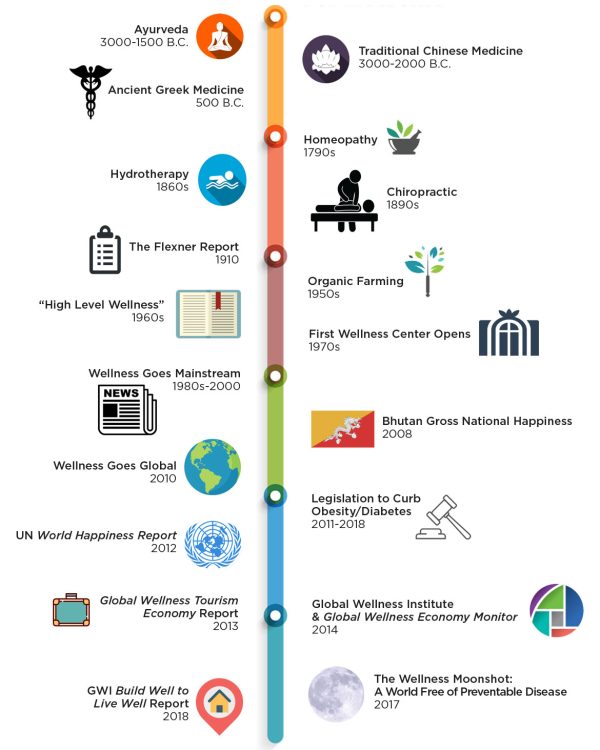
Since the 1950s, 1960s, and 1970s, when the writings and leadership of a loosely connected group of American doctors and philosophers greatly influenced how we understand and talk about wellbeing today, wellness has gained popularity as a modern concept.
But the roots of wellness go back much further—even to ancient times. Aspects of the wellness idea have their roots in a number of intellectual, religious and medical revolutions that took place in the 19th Century in Europe and the United States. The principles of wellbeing can also be traced to the prehistoric societies of Asia, Greece and Rome, whose historical traditions have had a profound impact on the contemporary wellness movement.
At the forefront of the wellness movement is the Ayurvedic and Traditional Chinese Medicine (TCM) modalities.
Ayurveda was originally an oral tradition passed down through families that was eventually written down in the four ancient Hindu texts known as the Vedas.
Regimens are individualized to each person’s unique constitution (their nutritional, exercise, social contact and hygiene needs) with the aim of maintaining a balance that avoids illness. Ayurveda is a comprehensive philosophy that seeks to promote harmony between body, mind and spirit. Yoga and meditation are essential to the tradition and are, of course, being practiced more often all throughout the world. Records show that Ayurveda dates back to between 3,000-1,500 B.C.E.
The development of TCM, one of the oldest medical systems in existence, occurred between 3,000-2,000 B.C.E.
TCM, which was influenced by Taoism and Buddhism, uses a holistic approach to promote harmony in one’s life in order to achieve health and wellbeing. Acupuncture, herbal medicine, qi gong and tai chi are among the TCM-derived methods that have become central to contemporary wellness, and even to Western medicine.
Around 500 B.C.E. Hippocrates, an ancient Greek physician, may have been the first to emphasize wellness rather than illness. He also made the case that environmental, dietary and lifestyle factors contribute to disease.
And around 50 B.C.E. the Greek idea that sickness was a result of nutrition and lifestyle was adopted by ancient Roman medicine, which placed an emphasis on disease prevention. With its large network of aqueducts, sewers, and public baths, Ancient Rome’s highly developed public health system contributed to the prevention of disease and the maintenance of a healthier population.
New intellectual movements, spiritual ideologies, and medical techniques proliferated throughout the 19th Century in both the United States and Europe.
Several alternative healthcare practices, including homoeopathy, osteopathy, chiropractic and naturopathy (which emphasize self-healing), holistic approaches and preventive treatment, were developed during this time and became widely accepted in both Europe and the United States.
The “mind-cure movements”, which included New Thought and Christian Science, and other new ideologies with a stronger spiritual focus contributed to the modern notion that a person’s mental and spiritual wellbeing are the main sources of their physical health.
These movements popularized concepts about restoring or maintaining one’s health through food, exercise and other lifestyle changes, even though some of the notions stated by the philosophers behind these movements have been disproved or seem “wacky” today.
These core beliefs, or systems, dating from the 19th Century – that a healthy body results from a healthy mind and spirit – are now seen as the forerunners of the flourishing wellness and self-help movements.
A few of these approaches are also regaining popularity among the general public and mainstream medical community, despite the fact that many of them lost favor with the advent of modern, evidence-based medicine in the middle of the 20th Century.
In the 20th Century, wellness as a concept spread and the wellness movement started to get more serious.
And then the 21st Century saw the advent of a ‘tipping point’, where the rising cost of providing healthcare to an increasingly aging and unwell global population forced a shift to a focus of prevention and wellbeing.
The wellness industry is now firmly established and generates approximately US$4 trillion per annum globally.
Regulation of the health and wellness industries
In most developed countries, there are complex and tightly regulated systems in place in the health care industry. A broad range of regulatory bodies and programs exist that are particular to each country, and often to states, provinces and territories within a country.
People engaging with the health care professions, or working within them, often find the breadth and scope of the laws to be overwhelming. Nearly every component of the industry is governed by one regulatory authority and occasionally – and sometimes confusingly – by several. Healthcare workers are often heard to say that they believe that they spend more time adhering to the rules that govern their employment than they do actually carrying out their jobs.
The fundamental issues at stake are what give health care regulation its pervasive characteristic. The majority of observers agree that when variables as important as life and health are involved, some sort of control is required. Even individuals who have a strong aversion to oppressive government bureaucracy might recognize the public interest in some kind of external oversight of this industry. The majority of policy discussions center on how oversight should be organized, rather than whether it should even exist.
However, the current regulatory framework is neither consistent nor uniform. Different regulatory organizations and initiatives apply in different ways to different facets of the industry. Federal, state and municipal governments, as well as a wide range of business groups, all work together to create and enforce health care regulations – often working without any cooperation between the different parties.
However, despite the rapidly growing trend for people to spend money on wellness products, there is very little regulation in the wellness industry.
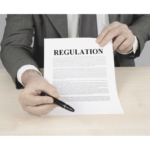
The industry thrives on the invention and expansion of jargon and ‘buzz words’ that create the next new fad – which sees people dipping into their pockets in a desperate attempt to get their health back.
There are swathes of cases where brands are making headlines for their questionable marketing statements about the products and services they’re selling to the public.
The wellness industry relies on ‘self-regulation’, but it doesn’t have any set standards that individuals and companies need to regulate themselves against. With the rise in social media, and more recently in influencer marketing, the public information domain is now flooded with marketing statements around wellness for which there is little to no requirement to provide any evidence backing the statements being made.
It rests completely with the individual and the organization to determine the level of credibility their marketing statements contain.
Where the health and wellness industries are going
In the last few years, the health care systems in most developed countries have continued to struggle under the weight of the chronic physical and mental health issues they’re currently experiencing. This has seen a shift in governmental focus to bringing education around personal responsibility to the forefront and encouraging prevention rather than cure as the standard way of life.
This has opened the door for the wellness industry to take a step forward as a key player in the market.

However, despite the millions of products and services being offered in the health and wellness industry, except for China and Brazil, consumer reports of wellness improvements have lagged behind hopes and expectations in every nation, raising the possibility that the market may be underserved.
The majority of consumers worldwide claim that their level of personal wellness is stagnant or perhaps even falling.

Case Study: McKinsey’s Six Wellness Views
In research conducted by McKinsey & Co, six wellness views were used to define wellness by consumers:
1. Better health – probably the oldest category linked with wellness, it goes beyond drugs and supplements to encompass personal health monitors and consumer medical gadgets. Consumers are increasingly taking control of their own health. We are witnessing an increase in targeted, data driven care, apps that make it simple for consumers to schedule appointments with doctors or order the prescriptions they require, and gadgets that allow them to keep track of their symptoms in between doctor visits.
2. Better fitness – regular access to gyms or engagement in sports is seen as critical to being able to maintain fitness. This has seen an increase in technology-based ‘fitness’ programs and apps that enable people to maintain their fitness without leaving their home.
3. Better nutrition – wellness has always included nutrition, but today’s consumers expect their food to support their overall wellness as well as taste good. In the coming years, more than a third of customers worldwide say they “probably” or “certainly” intend to boost their expenditure on subscription food services, diet apps and juice cleanses.
4. Better appearance – thanks to successful marketing campaigns, people now believe that regularly wearing athletic clothing and using cosmetic products like skincare and collagen supplements will assist them to improve their appearance. Recently, a number of service-oriented options in this field have appeared for non-surgical aesthetic procedures using oxygen jets, lasers and micro-needling.
5. Better sleep – given the stress and strain of life in the last few years, it may not be surprising that customers are interested in relatively new categories like better sleep. Modern sleep aids like melatonin and app-enabled sleep trackers are competing with traditional sleep drugs – for example, blackout curtains and gravity blankets. More goods and services are wanted, according to 50% of customers worldwide, in order to address the demand for better sleep.
6. Better mindfulness – has recently become more widely accepted by consumers, thanks to products like meditation- and relaxation-focused apps. Global complaints of mental health and exhaustion have increased, and now more than half of consumers say they want to prioritize mindfulness more. A market potential for businesses may be seen in the fact that half of consumers said they wished there were more mindfulness-related goods and services available.
Generally, consumers expect to increase the amount of money and time they spend on the purchase of wellness products and services in the coming years.
In addition to the above areas, six consumer wellness-related trends have started to gain traction in recent years. The wellness sector as a whole is affected by these changes – from traditional consumer healthcare to exercise programs and nutrition to beauty, organizational health and wellness, clothing, and retail.
Trend 1 – Clean, natural products: the importance of this trend should not be overlooked, as the significance of this shift is startling. This trend is of such importance to consumers that they are actively choosing products – even if they are less effective than less clean competitor products.
Trend 2 – Bio-individuality is key: consumers are no longer prepared to accept an off-the-shelf product that has been engineered for mass production. They are demanding individual personalization of the wellness products they purchase, so they know that they are tailored specifically to them.
Trend 3 – Go digital: Consumers want to be able to access everything they need at the stroke of a key. If they can’t get it online, then it doesn’t exist.
Trend 4 – Influencers hold the influence: the rise of the influencers now means that consumers rely on recommendations from them to inform their buying choices. The key is to choose influencers who resonate authentically with the people you’re trying to reach.
Trend 5 – Services take their place: the wellness industry has been dominated by products for a long time, but that is now being balanced with the rise of services being provided within the industry. This opens a great opportunity to marry products with services and create tailored wellness packages that meet bio individual demands.
Trend 6 – Collaborations: most individuals don’t want one organization providing them with a one solution fits all ‘package’. This opens the opportunity for individuals and organizations to work together to create holistic solutions for individuals that meet their needs.

Exercise 1.1: Wellness Views
1. Write down how you feel when you wake up each morning (for example: exhausted, stressed, sore, energized, happy, sad and so on).
2. Write down how well you believe you sleep now.
3. Write down the things that keep you awake at night.
4. Write down one simple thing you can do to remove or minimize the issues that contribute to the things that keep you awake or sleeping restlessly.
5. Write down three simple things you can do to create a sleep routine that will help you to get better sleep.
6. Write down the first action you need to take in order to make sure you can have these things.
7. Write down how and when you will implement this action.
8. Write down how you will hold yourself accountable for making sure this action gets done.

Course Manual 2: The Current State of Play
Introduction
The global wellness economy includes industries and businesses that help people live healthier lifestyles and engage in wellness-related activities.
Globally, there have been significant changes and disruptions, with a period of rapid growth during the period 2017-2019 and the devastating economic shock of the 2020 pandemic which followed.
In light of the fact that 2020 has now become a watershed year that will forever separate history into “before” and “after” COVID-19, it’s not surprising that an update for the global wellness economy was particularly intriguing in the years since.
The wellness economy operates globally but can be broken into significant regions throughout the world. These regions include:
• North America
• Asia-Pacific
• Europe
• Latin America – Caribbean
• Middle East – North Africa
• Sub-Saharan Africa
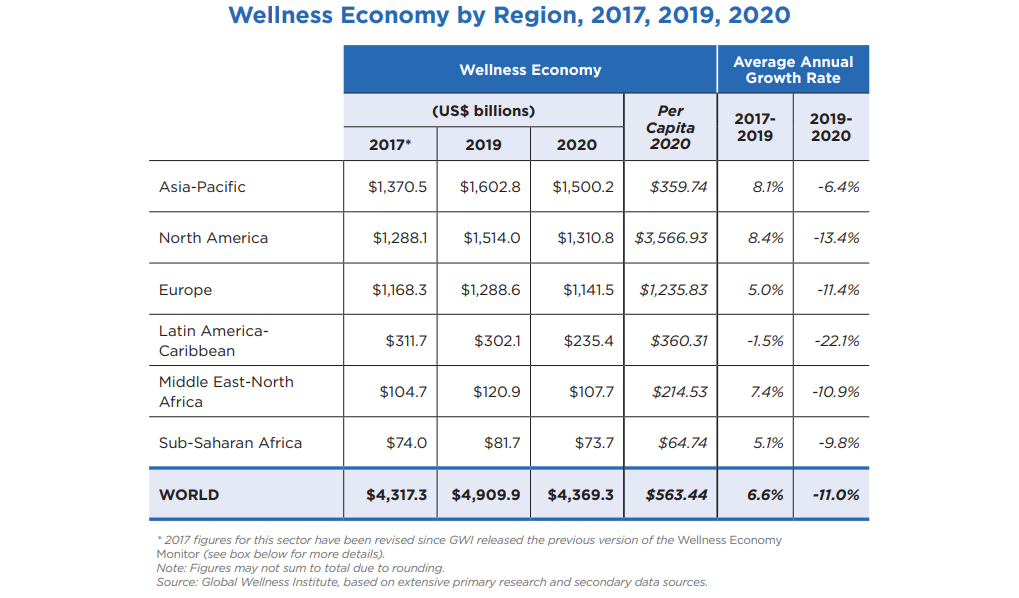
With the addition of mental wellness post-2020, the industry can now be broken into eleven key sectors, as follows:
1. Personal care & beauty
2. Healthy eating, nutrition & weight loss
3. Physical activity
4. Wellness tourism
5. Traditional & complementary medicine
6. Public health, prevention & personalized medicine
7. Wellness real estate
8. Mental wellness
9. Spas
10. Workplace wellness
11. Thermal/mineral springs
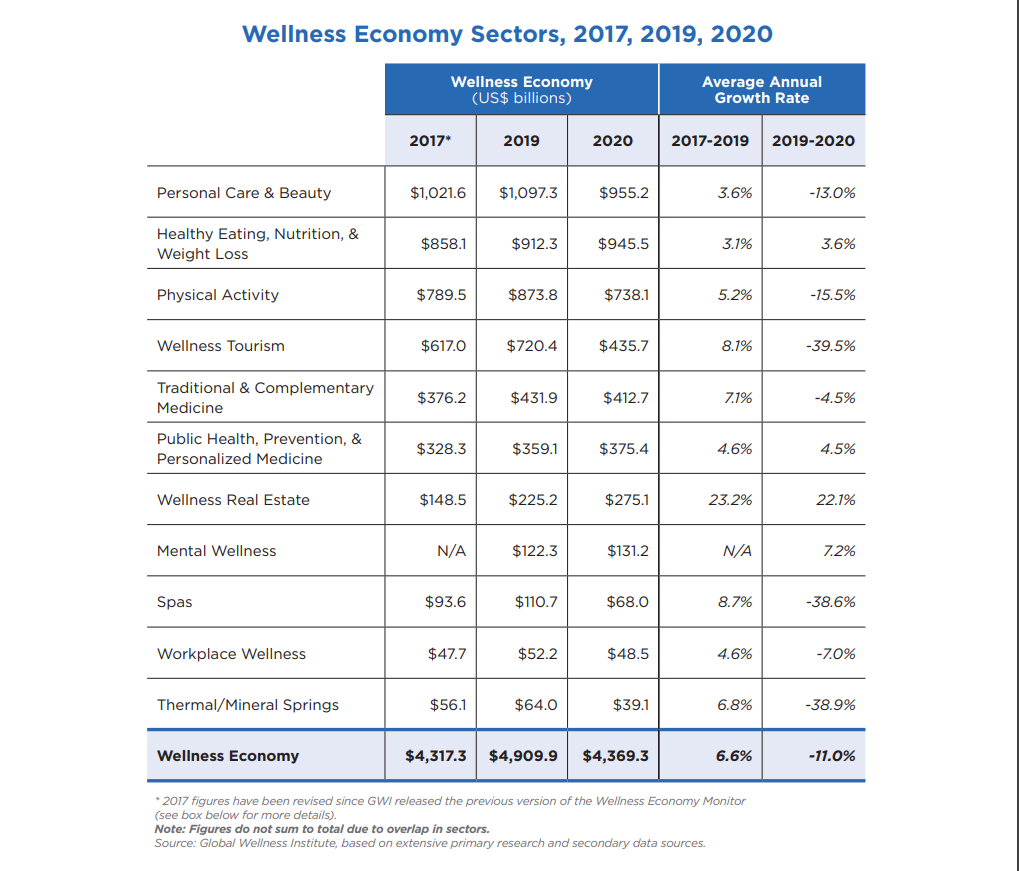
Size of the current health and wellness industry
Between 2017 and 2021, the global health and wellness industry expanded from US$3.7 trillion per annum to US$4.2 trillion per annum.
This represents growth that is twice as fast as that of the world economy, with mental health and spiritual self-care related products, services and activities being just two of the numerous players that have contributed to the explosive expansion of this industry.
Industry Projection
The statistics show that the COVID-19 pandemic accelerated the growth of the health and wellness industry and brought it forwards as the primary focus and value for consumers globally.
Consumers are now significantly more conscious about their individual health outcomes, mental toughness and their general feeling of wellbeing as impacted by every element of their lives, including where they live, how they work, what they eat and how they exercise, socialize and travel.
The pandemic forced everyone into a homeostasis of wondering what the new standard is, and what will be available to them moving forwards.
Despite the short-term shocks brought on by the COVID-19 pandemic, the fundamental forces driving the expansion of wellness are as strong as ever. These include the expanding global middle class, population ageing, the continuing rise in chronic disease as well as growing consumer interest in, and awareness of, healthy lifestyles.
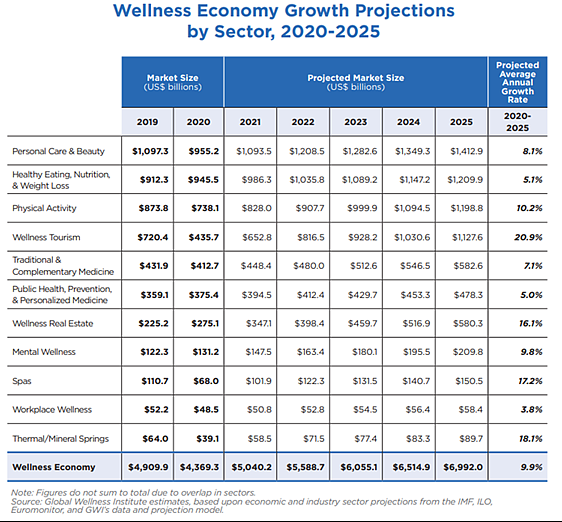
Between 2022 and 2027, the majority of the individual wellness sectors are anticipated to increase faster than gross domestic product (GDP). The industries that were expected to develop the fastest in 2020 – wellness tourism, spas and thermal/mineral springs – were also the ones that suffered the most. Because they reflect a period of quick post-pandemic recovery in 2021 and 2022 before tapering off to a growth trajectory similar to their pre-pandemic levels, the growth rates for certain sectors may appear to be excessively high.
In the upcoming years, it is anticipated that other industries with strong growth patterns throughout the 2020 pandemic, such as wellness real estate and mental wellbeing, will continue their growth trajectories.
Although the wellness sector is in a good position to bounce back and thrive, future expansion will probably appear different from previous expansion. The short-term effects of travel restrictions, company closures and capacity limitations may be swiftly recovered in several industry segments.
As consumers and markets balance vaccination rates and the worry of new waves of infection, experiential activities and those involving physical touch or intimate contact may return more gradually.
It’s significant to note that the COVID-19 experience has led to some significant changes in how customers perceive, experience and anticipate wellbeing. In the future, these changes will have a significant impact on the wellness industry as a whole.
The ‘wellness’ effect of the pandemic
There has long been a strong ‘Wellness Industry’, but there is no doubting that the COVID-19 pandemic has seen consumer interest in everything wellness-related soar. In some ways, enthusiasm surged during the pandemic, even though consumer spending on wellness declined overall during this time.
Wellness is now pervasive in media and retail, and is becoming more and more ingrained in typical consumer lifestyles.
Wellness is now THE differentiator or selling point for many kinds of goods, services and technologies; strong growth rates being reported by all eleven wellness sectors from 2017 to 2019 demonstrate the wellness economy’s rising trend.
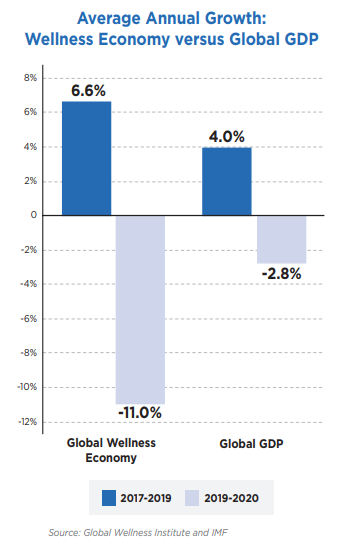
Prior to COVID-19, all but two wellness industries (and the entire wellness industry overall) were expanding faster than the global GDP (see chart to the right). Due to the pandemic’s broad disruptions, the wellness economy shrank by almost four times as much from 2019 to 2020 as the global GDP did.
Fundamentally, wellness as a concept is unquestionably successful because people all over the world are realizing the value of leading healthy lifestyles and developing personal resilience as a first line of defense against infectious and chronic disease.
The pandemic brought with it serious economic turmoil. This saw the wealth and income gap between the rich and the poor grow and the division between the luxury and mass markets deepen. Many middle- and low-income customers had little time or money to spend on wellness in 2020; in contrast, wealthy consumers in high-income countries may have had relatively little change in their expenditure throughout the pandemic.
As has long been the case, there are significantly more people in the middle- and low-income earning categories than there are those who are wealthy. It is the deepening of this division, along with the pressure of the pandemic, that has seen individuals change their expectations and expect their employers to fill the ‘wellness gap’ for them.
What is the future of the wellness economy?
Despite the short-term shocks brought on by the COVID-19 pandemic, the fundamental forces driving the expansion of wellness are as strong as ever.
These include the expanding global middle class, population ageing, the continuing rise in chronic disease and growing consumer interest in and awareness of healthy lifestyles. Furthermore, there’s now a focus on employers to provide a holistic wellness solution as part of everyday employment.
The pandemic has also brought about new changes that have accelerated many wellness-related factors, such as a growing understanding of how the built environment affects health, a growing emphasis on mental health and wellbeing, a rethinking of the balance between work and life, an expanding focus on social justice and environmental sustainability, and much more.
It is anticipated that by 2025 the global wellness sector will expand at a strong rate of 9.9% per annum, which is much faster than the projected 7.3% growth of the world’s economy as a whole and will increase to about US$7.0 trillion in 2025 as the global economy recovers from the shock of the pandemic.
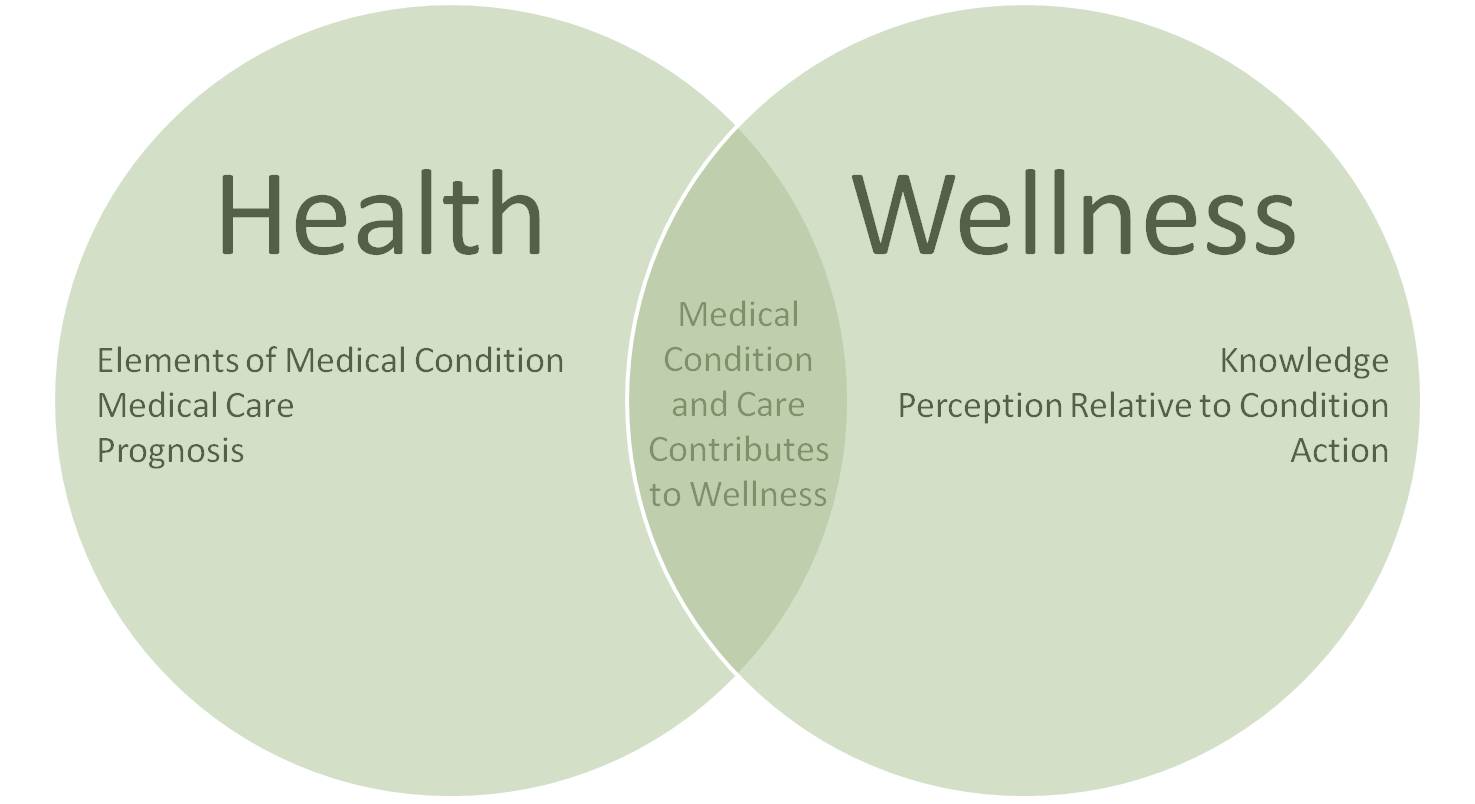
Self-care will become a priority
Up until recent times, society had moved towards holding self-care in the ‘wishy washy’ category. It’s a ‘nice to have’, but also a bit of a ‘woke’ thing to have in your life.
It became a part of the wellness tourism promotion strategy and suddenly came with hefty price tags and a requirement to take yourself away for days at a time to a spa or a health retreat.
Since the pandemic, self-care has taken on a new lease in life and has become front-of-mind for the general population. Wellness is now frequently linked with self-care, or just taking care of yourself, in consumer lingo.

Although the idea of self-care has been gaining ground for many years – fueling the wellness economy’s explosive expansion – it has frequently been linked to pampering or taking a break from our everyday obligations.
The pandemic’s wide range of pressures has caused a significant change in how we think about self-care.
Self-care is now viewed as a strategy of surviving and self preservation.
Individuals have turned their attention to making it a priority to answer the question: ‘How can I look after my own needs so that I can take care of myself, my family and my obligations while managing a challenging situation?’
It now includes a lot more than just a bubble bath, a facial, a spin class or a meditation session. It also includes home-cooked meals, interpersonal relationships, sleep, time in nature, financial wellness, the search for meaning and purpose, and much more.
The pandemic highlighted the multi-faceted and pervasive character of wellness.
Wellness is no more something we do for an hour a day, a few times a month, or simply while we are on vacation; it is an important emphasis that must be ingrained in our everyday lives and priorities if we want to survive and maintain our sanity.
Because it has sat outside the mainstream way of life for so long, wellness practices, advocates and businesses offering dubious and occasionally hazardous “cures” and quick solutions, misleading efficacy claims, magical thinking, phony science and even anti-science, often gives wellness a poor name.
The wellness movement has grown mostly outside of orthodox medicine and its research, operational and financial processes, with some help from consumers and companies.
Consumer interest in various “alternative”, preventive and lifestyle-based wellness methods is growing. This has made medical science scramble to keep up with the wellness sector.
While many well-known wellness modalities have been practiced as a form of self-care for hundreds or even thousands of years, recent advancements in science and technology have made it possible to test and validate their efficacy – for example: yoga, meditation, plant-based medicines, chiropractic, acupuncture and psychedelics.
As a result, some of these practices are now being gradually accepted by conventional medicine. That said, the consumer uptake of wellness practices is expanding considerably more quickly than the rate of scientific research, particularly in sectors like supplements and functional foods.
The future of conventional medicine will see it turning more and more towards wellness and valuing it for its holistic lifestyle approaches and therapies, due to economic pressures on health systems, ageing populations and the rise of chronic disease globally.
The focus is on mental health
For a while now, the public health catastrophe caused by our mental illness has been getting worse, but it was not until the pandemic that we took any real notice.
The prevalence of mental and drug use disorders is about 15% worldwide. In many nations, happiness is declining while stress, anxiety, depression, burnout and loneliness are rising.
Dementia is also on the rise. The COVID-19 pandemic has hastened the decline in our society’s health. It has highlighted the enormous disparity between mental health needs and resources as well as our susceptibility to mental anguish, even when we do not have a mental disorder that has been officially diagnosed.
In the face of this declining situation, mental wellness offers a solution that can assist in addressing general needs and improve everyone’s wellbeing.
In fact, a significant movement towards mental wellness is just getting started, serving as a personal road to greater wellbeing, a safeguard for the workforce and a public health and community plan.
In order to support people in improving their mental wellness and resilience in their daily activities at their homes, schools and places of employment, as well as in hospitality settings and throughout the built environment, the private sector has been developing new solutions, services and products in response to the pace that is being set by the demand from consumers.

Prevention has become the main lifestyle choice
Until the pandemic, everyone was stuck in a cycle of worrying about curing something after it happened. Now, the focus has shifted onto prevention being the primary focus in everyday life.
Governments have realized that they can no longer afford the significant costs associated with a seriously unhealthy cohort. Organizations have realized that the cost of a significantly unwell workforce is massively impacting the bottom line. Crucially, individuals have realized that they are no longer prepared to trade their future for an unhealthy, miserable and mentally strained present.
Everyone – individual and organization alike – is turning to prevention as the solution to the current day wellness problems they’re experiencing.
Collectively, everyone has realized that health on every level requires a greater investment of time, money and resources, and that it has to extend beyond personal vacation time and health check-ups.

Case Study: Wellness Real Estate Trends
According to ‘The Global Wellness Economy: Looking Beyond COVID’ report produced by the Global Wellness Institute in December 2021, the Wellness Real Estate Trend was ‘defined and measured for the first time in the 2018 research report Build Well to Live Well’.
The construction of residential and commercial/institutional properties (including office, hospitality, mixed-use/multi-family, medical, and leisure properties) that intentionally incorporate wellness elements in their design, materials, and construction – as well as their amenities, services and/or programming – was defined as the sector in this report.
The construction and real estate industries saw a significant shift towards wellness as a result of the COVID 19 pandemic.
Global wellness real estate grew to US$275 billion in value by 2020, up from US$148 billion in 2017. As of December 2021, 2.4% of yearly global construction production is made up of wellness properties.
From 2017 to 2019, wellness real estate rose by 23% annually, while construction as a whole only grew by 5.4% annually. Wellness real estate grew by nearly 22% during the pandemic year (2019-2020), despite a 2.5% decline in construction output overall.
This growth has been aided by a number of trends that emerged during the pandemic, such as the increased understanding of how buildings and indoor air contribute to the spread of communicable diseases, and the increased reliance on outdoor recreational opportunities and public spaces because indoor recreation centers were closed (see further discussion below).
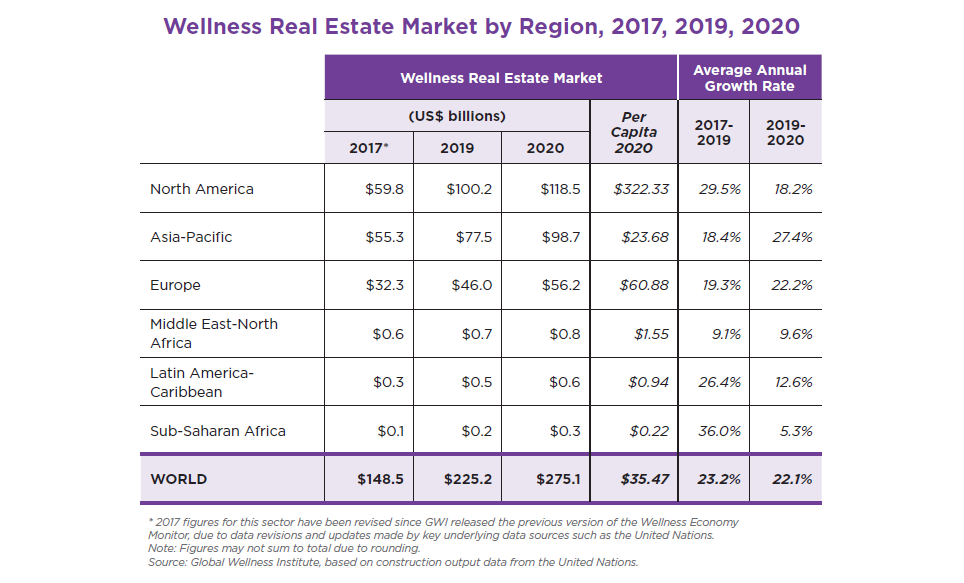
It is forecast that this growth trend will continue as healthy building elements, particularly in the commercial/office real estate sector, move from being a luxury or ‘nice to have’ to becoming an expectation or even a minimal norm.
Ten Key Drivers of Future Growth for Wellness Real Estate
1. Rapidly rising interest in wellness certifications for residential properties (in addition to office/commercial properties).
2. In multi-family developments, wellness features and healthy design will become nearly ubiquitous in luxury properties, and will increasingly be found in mid-market and affordable properties. In particular, countries with publicly funded healthcare will help push health-protecting and health enhancing features into affordable/subsidized housing, as a front-end investment to lower public health spending.
3. Continued growth of master-planned communities, mixed-use developments and urban districts, with expansive wellness amenities and/or with health and wellbeing as a key selling point. This trend will be especially strong in countries with rapid urbanization and a rising middle class, where more people are moving to suburbs and are looking to bring urban-style wellness amenities to the suburbs with them – for example: walkability, mixed use and so on.
4. Wellness residential concepts will grow rapidly in developments targeting seniors and young adults, including senior living, multi-generational living, and co-living – especially in Europe and Asia.
5. “Retreat-style” wellness living concepts (second homes, vacation homes) will expand to most major destination spa and destination resort brands.
6. A heightened appreciation for, and emphasis on, natural areas, parks, outdoor recreation amenities and public spaces will continue in the post-COVID era – and especially a heightened focus on more equitable distribution of, and access to, these spaces.
7. Post-COVID, there will be ongoing emphasis on indoor air quality and general sanitation, especially in workplaces, schools, retail and other public buildings.
8. As people return to their workplaces in the post-COVID era, employers will be forced to reconfigure workplace design to address employee concerns about disease risks, and increasingly other wellness needs – for example: mental and emotional wellness.
9. Growing interest in healthy buildings and health-enhancing built environments among real estate investors – especially in Asia, North America and Europe – driven by tenant demand as well as a growing emphasis on human health as part of ESG (environmental, social, and corporate governance) initiatives.
10. Increasing overlap between planetary health (sustainability) and human health (wellness) across all types of building projects.
(Source: Global Wellness Institute – The Global Wellness Economy: Looking Beyond COVID)
Active wellness
The pandemic also saw a rapid shift from passive to active wellness. This saw individuals move to actively take control of their health, demand more from the organizations they’re connected with – especially the ones they work for – and demand more quality produce for consumption.
This can be seen in the way people use the streets in their neighborhoods and cities, with more walking and biking occurring, more community-based social gatherings and more outdoor-based events (especially dining). Many cities are now making modifications to their infrastructure, scenery and layout – keeping in mind public health and safety while also minimizing the spread of infectious diseases, encouraging residents to stay active and keeping a close watch on pollution reduction.

Physical activity for mental wellness is now a ‘thing’
When the pandemic hit, everyone was forced home and, in a lot of cases, into lockdown situations.
This meant that for most people, the usual physical activity – gym, fitness classes and recreational sport – became unavailable.
This situation highlighted the vital connections between exercise and our mental and emotional wellness. Physical activity is crucial for our health, and it has numerous known and well-supported positive effects on our mental wellness.
The majority of recreational physical activities can improve our overall wellbeing by promoting a sense of purpose, a sense of fun and joy, a sense of relaxation and de-stressing, and by building resilience.
Exercise locations and methods can also benefit our mental health. For instance, when we participate in team sports, we forge and sustain the social relationships that are so important for our mental health.
Likewise, exercising outside has the extra psychological and emotional advantages of being in nature.
Before the pandemic, global rates of physical exercise were falling in many nations despite these obvious advantages. COVID has made this issue worse. According to studies, over a quarter of adults are physically inactive. During the pandemic most people, especially children and young people, were increasingly sedentary, and as a result they missed out on the numerous advantages of physical activity – even as many experienced increased stress, anxiety and lack of sleep.
Weight loss and physical appearance used to be the primary motivators for people to exercise. Increasingly, recreational exercisers now have goals such as lowering stress levels and enhancing sleep to drive their physical activity. Yoga and other mindful movement practices are becoming more and more popular as more people realize how beneficial they are for mental health.
Physical activity will be more integrated with mental wellness through new programs and services as our awareness of the mind-body relationship grows.

Now that the link between health and wellbeing is better understood, it is no surprise to see the wellness industry respond with products and services that are greatly influenced by physical activity, including cardiovascular health, stress reduction, social relationships and the development of both physical and mental resilience.
People were forced to abandon the gym due throughout the pandemic and instead complete their workout at home or in public areas.
More than ever there is a widespread understanding that having a walkable area and access to parks, public recreation centers and outdoor spaces for physical activity has a direct impact on our health and emotional wellbeing.
The pandemic brought to light the stark disparity in access to these essential facilities, particularly for the urban underprivileged and marginalized people. These populations are not only denied access to free, well kept, high-quality outdoor leisure areas, but also sometimes have to stay inside due to unhealthy air quality, pollution or general safety issues.
In some of the more progressive countries in the world, doctors can prescribe exercise, albeit it is not yet a common practice. Some doctors believe that physical activity is an essential component of patient care, particularly when it comes to managing chronic pain, recovery/rehabilitation and mental health.
Exercise regimens can help long-term COVID patients with their chronic symptoms and recovery. Fitness facilities – in particular, gyms, community centers, and physical rehabilitation centers – are crucial to the delivery of these services.
It is obvious that the idea that exercise is only for leisure needs to change, and there is still a long way to go before communities and governments invest enough in infrastructure to make physical activity genuinely a right for everyone.

Exercise 1.2 – Local Changes
1. Write down the changes you’ve noticed about health and wellness activities in the past few years.
– What’s new?
– What’s gone?
– What do you think is missing?
2. How has the way you experience and/or interact with health and wellness activities changed?
– Are you doing more/fewer activities?
– What types of activities are you doing?
– Are there some activities you used to do that you now find exhausting?
– Have you tried new activities or stuck to the same old ones?
3. Are you motivated to participate in health and wellness activities?
– What are your motivation levels?
– Do you self-motivate?
– Do you need to attend a class or have an appointment to get your health and wellness ‘done’?
4. Do you let other things take priority or importance over your health and wellness?
– What gets in the way?
– What is more important?

Course Manual 3: Health, Wellness and Well-being
Introduction
It’s a well-known and accepted fact that being healthy and maintaining good wellness will make it easier to lead a happy life.
Without great health and wellness, it’s also almost impossible to achieve at the highest levels.
Yet until recently, it’s the number one thing to be pushed aside and left until ‘later’.
The onslaught of stress and the sheer number of people whose health – and their loved ones’ health – was affected during the pandemic showed us that too many people in our working population have put their health on the back-burner and allowed the demands of life to take over.
Despite the advantages of enhancing whole-person wellbeing in adults – being an improved standard of living, a more extended and healthy life, engaging in social interaction, emotional wellbeing, contribution to the workforce and financial self-sufficiency – for too long, we’ve lived a fast-paced, over-stimulated and on demand lifestyle that gives little, if any, credence to the importance of our health and wellbeing.
Nowadays, we’re seeing the true cost of allowing a population to live unhealthy lives for too long, and there’s a growing ground swell of people globally that are demanding that they be supported in living their lives differently.
As part of this movement, people are seeking to better understand what health and wellness is, how they work together and why they must go together to create a holistic plan moving forward.
Defining Health
The existence or absence of disease or risk factors in an individual, as determined by a doctor, might be considered as indicators of their health. Nevertheless, health is defined as “… a condition of complete physical, mental, and social wellbeing and not only the absence of disease or infirmity …” in a more general sense (World Health Organization (WHO), 1946).
In 1986, the WHO then clarified this definition and added that health is a “… resource for everyday life, not the objective of living. Health is a positive concept emphasizing social and personal resources, as well as physical capacities.”
This indicates that health is a resource to support a person’s role in larger society, rather than being a goal in and of itself. The means to live a full life with meaning and purpose are provided by a healthy lifestyle.
Importantly, not just the absence of illness or disability, but also total physical, mental and social wellbeing, is referred to as being ‘in good health’.
The two categories of health that are perhaps most frequently discussed are physical and mental.
The state of one’s finances, emotions and spirituality all affect overall health. These have been connected by medical professionals to a reduction in stress levels and enhanced mental and physical wellbeing.
People who are in better financial condition, for instance, might be less concerned about money and have the resources to purchase fresh food more frequently. A peace and sense of purpose that supports good mental health may be experienced by those with strong spiritual health.

A person with good physical health is likely to have optimally functioning body systems.
This is not just because there are no diseases present. Healthy living is influenced by regular exercise, a well-balanced diet, and enough sleep. When necessary, people need medical care to keep the balance.
In order to reduce the risk of disease, maintaining a healthy lifestyle is essential for physical wellbeing. For instance, maintaining physical fitness helps safeguard and enhance a person’s capacity for breathing, heart function, muscular strength, flexibility and body composition.
Taking care of one’s physical health and wellbeing also results in lowering the likelihood of suffering from an illness or injury, such as:
• reducing job risks
• using contraception while having sex
• maintaining good hygiene
• abstaining from tobacco, alcohol, and illegal drugs
• travelling with the prescribed vaccinations for a certain disease or nation
The whole quality of life can be enhanced by having good physical and mental health.
According to the U.S. Department of Health & Human Services, a person’s emotional, social and psychological wellbeing is referred to as their mental health. As part of a complete and active lifestyle, mental health is just as crucial as physical health.
Every individual is unique. Therefore, as a result of the fact that many psychological diagnoses depend on a person’s interpretation of their experience, mental health is more difficult to define than physical health. However, with advancements in testing in recent years, medical professionals can now spot some physical indicators of some types of mental illness in CT scans and genetic studies.
It’s not just the presence of sadness, anxiety or other psychological disorders that define mental health. Additionally, it depends on a person’s capacity for:
• appreciating life
• recovering from traumatic events
• overcoming adversity
• balancing all aspects of life, including family and finances, feeling secure and safe, and reaching their full potential
Often, two or more of these are closely related to one another. For instance, a chronic condition that makes it difficult for a person to carry out daily chores may cause stress and despair. These emotions may be brought on by mobility or financial challenges.
An eating disorder or depression can have an impact on general function and body weight.
It is critical to treat health holistically rather than as a collection of discrete elements. People should strive for general wellbeing and balance as the keys to excellent health because all sorts of health are interconnected.
People’s health and their environment as they age, grow, live, work and play are closely related. Health is influenced by a number of variables, including money, employment, education, housing, social support, the environment, behavior and heredity.
In order to manage stress and live a longer and more active life, good health is essential. The interplay between a person’s environment, lifestyle and heredity is reflected in their state of health.
These numerous “health determinants”, which can be hazardous or protective, interact to affect the health of people and communities.
In most developed nations, it can be demonstrated that each of the socioeconomic factors in the framework for determinants of health – education, employment, income, family and early childhood circumstances, housing, working conditions, and social support – affects health outcomes, with some overlap between them. For instance, people with higher education are more likely to have higher incomes. They significantly impact health inequalities, which are avoidable disparities in health status within and between groups and nations.
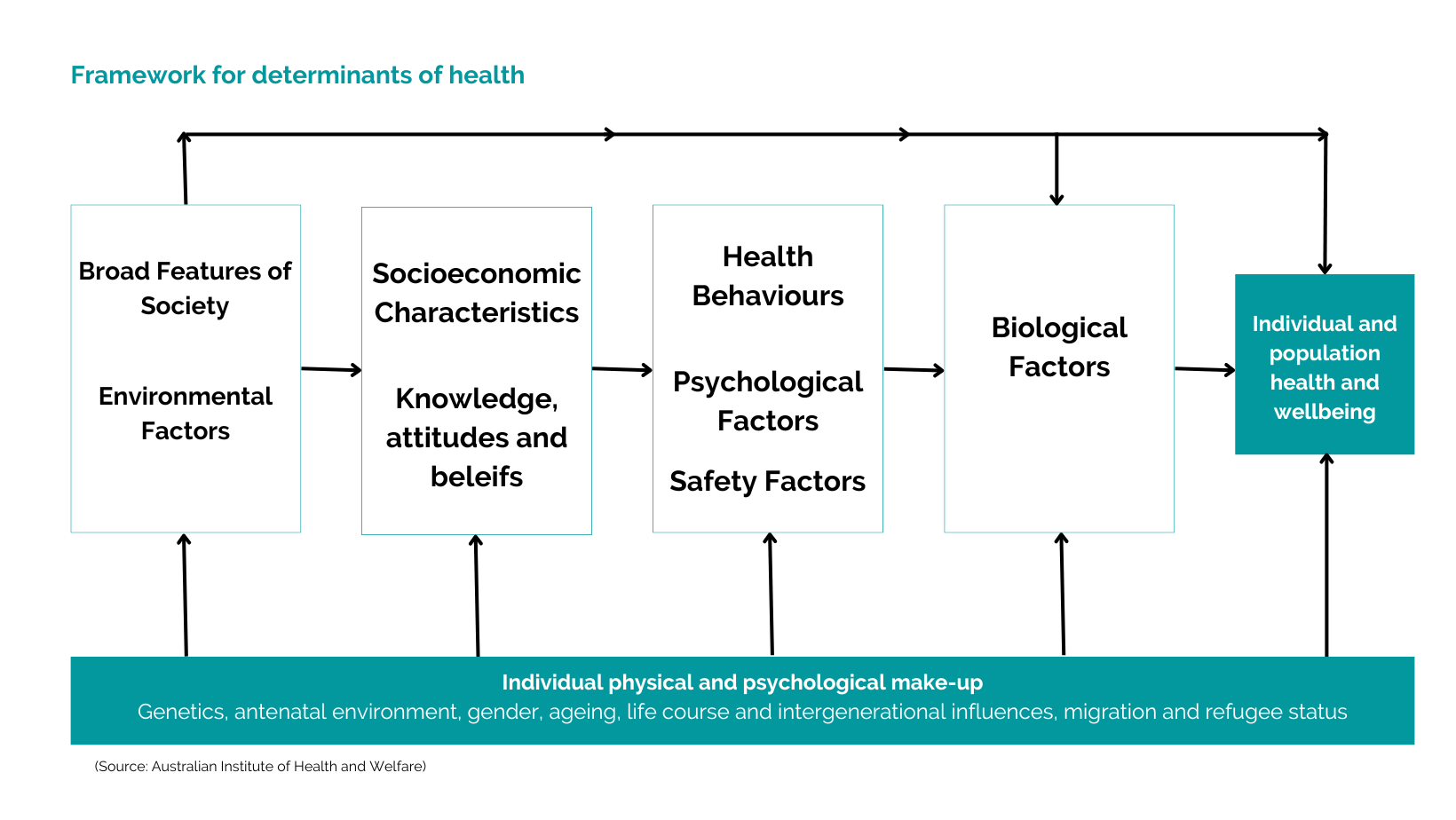
In most developed countries, the health system promotes the wellbeing of the country through illness treatment, disease prevention and population health maintenance.
The health system is held up by the belief that people will live as long and as healthy as possible if the health system is functioning properly. Most health systems make this possible by giving access to preventative measures like immunization and vaccination, as well as treatments like hospital care, primary health care (such as general practice and allied health services) and both in combination.
It is only recently that an additional component has been added to the health care system: supporting people’s health through the promotion and protection of their health.
Numerous factors influence one’s ability to stay healthy
Genetics
All of a person’s genes are present at birth. Some individuals may experience less-than-optimal levels of health due to an atypical genetic pattern or alteration.
People may inherit genes from their parents that put them at higher risk for developing specific diseases.
Environmental
It is also now known that the environment has a direct impact on health. Sometimes health effects might be caused just by the surroundings. Other times, a person with a higher genetic risk of developing a specific disease may become unwell as a result of an environmental trigger.
Although having access to healthcare is important, the WHO has determined that the following factors may have a greater impact on health:
• where someone lives
• the quality of their immediate environment
• their genetic makeup
• their degree of income; and
• their occupational situation
Social and economic environment
The financial standing of a family or community, as well as the social norms and interpersonal interactions, may be included in maintaining health.
Physical environment
The physical environment includes the types of germs that are present and the extent of contamination.
Individual characteristics
A person’s general health may be impacted by their genetic composition and personal lifestyle decisions.
According to numerous research studies conducted around the world, a person’s socioeconomic status (SES) determines how likely they are to be in good health, have a good education, have a well-paying job and be able to afford quality healthcare in the event of an accident or illness.
They contend that those with poor SES are more prone to feel stress from everyday issues including money problems, marital problems and unemployment. People with lower SES may also be more susceptible to poor health due to social issues including marginalization and prejudice.
Low SES frequently results in less accessibility to healthcare. According to a 2018 study published in Frontiers in Pharmacology Trusted Source, persons in developed nations with universal healthcare have longer life expectancies than people in developed nations without it.
Culture can also have an impact on health. The way a family responds to societal traditions and norms can directly affect health in both positive and negative ways.

Case Study: Seven Countries Study
The Seven Countries Study indicated that persons who ate a healthy diet had a decreased 20-year mortality rate. The study looked at people in seven different European nations.
According to the study, those who routinely eat fast food are less likely to consume high levels of fruits, vegetables and olives than those who follow a healthy diet.
The Mediterranean diet was also linked to a decreased 10-year all-cause death rate, according to the study. This diet can assist a person’s heart and lower their risk of a number of ailments, including type 2 diabetes, cancer and conditions that damage the brain and nerves, according to the International Journal of Environmental Research and Public Health.
A person’s health will also be impacted by how they handle stress. People who use illicit drugs, alcohol or cigarettes to cope with stressful situations are more likely to suffer from health issues than those who manage stress with a healthy diet, relaxation methods and exercise, according to the National Institute of Mental Health.
Other areas of health
While physical and mental health are the front runners in the industry, there are a number of other areas of health that are starting to rise and have an impact in everyday life.
Because it seems like it’s all or nothing, spiritual health is frequently disregarded – but it doesn’t have to be that way! Spirituality can take the form of organized religion or anything that makes you feel connected to the cosmos, including yoga, meditation, being in nature and practicing gratitude.
It’s also critical that we now start to take into account occupational health and wellbeing, or how you feel about your work or employment. Even when occupations are unfulfilling, many people have a tendency to keep them, and this can surely have an impact on their wellbeing. Being in a job you despise can generate stress and worry, which can lead to a variety of physical and emotional ailments, as well as make you not fun to be around. Recognizing the warning indications that your career is the wrong one for you – and working to change it – is a critical component of maintaining your health and wellness over the long-term.
Last but not least: how does your environment affect or benefit your health? Does it get too dark in your house? Do you have trouble getting to the parks in your neighborhood? Do you share a home with someone who doesn’t value or respect you?
All of these and more make up your environment, which can have an impact on your wellbeing.

Defining Wellness
The Global Wellness Institute defines wellness as: “… the active pursuit of activities, choices and lifestyles that lead to a state of holistic health”.
This definition has two crucial elements. First, striving for maximum health and wellbeing is a ‘active pursuit’, not a passive or static condition. It involves intentions, decisions and actions. Second, wellness is related to holistic health, which includes many distinct facets that should complement one another and go beyond mere physical health.
Although wellness is a personal goal – each of us is responsible for our own decisions, actions and way of life – the physical, social and cultural contexts in which we live have a big impact on it as well.
You may already lead a healthy lifestyle – whether you’re in perfect health or dealing with a chronic illness. Your body, your job, your relationships, your emotional health and so much more are all part of your wellness.
You can obtain a high level of wellbeing by combining health and wellbeing. You can acquire good health for life by putting a special emphasis on wellbeing.
Health, wellbeing and happiness are sometimes used interchangeably with the word “wellness”. Even if they share some characteristics, wellness stands out because it doesn’t relate to a fixed state of being (that is, being happy, in good health or a state of wellbeing). Instead, wellness is linked to a proactive process of awareness and decision-making that results in optimal holistic health and wellbeing.
Dr Jack Travis is credited as a pioneer of the modern wellness movement in the late 1970s. He created the ‘Wellness Continuum”, which considers a spectrum of ‘health’ that an individual can experience at different times in their life. Thinking of health as a continuum that stretches from illness to a state of optimal wellbeing is one way to comprehend wellness.
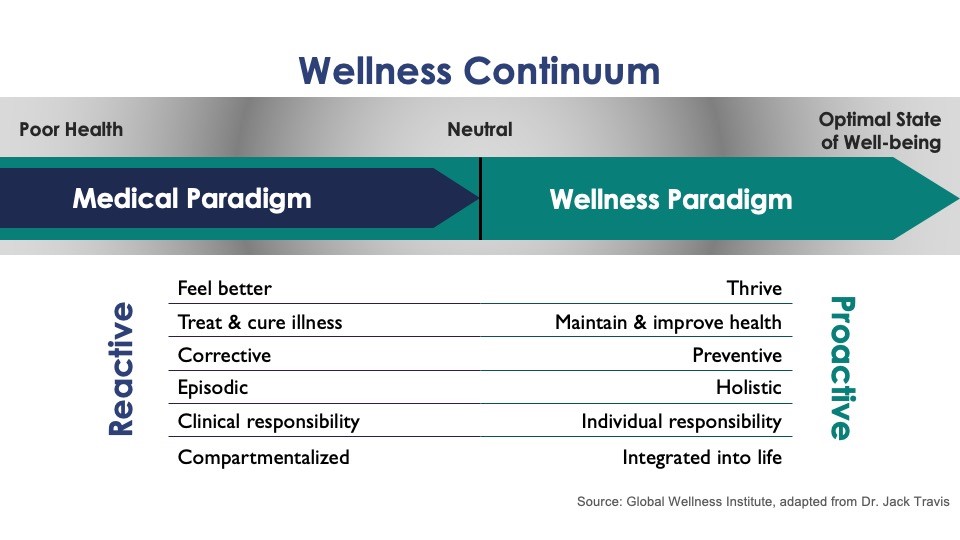
On the one hand, sick patients use the medical paradigm to treat their ailments; they communicate reactively and sporadically with healthcare providers like doctors and clinicians.
On the other hand, there’s focusing on the possibility of proactive prevention and maximizing vitality as the main concerns of people. They adopt behaviors and attitudes that promote health, fight off sickness, improve quality of life and make them feel better about themselves.
In other words, wellness is motivated by self-responsibility and is proactive, preventive and intentional. The expansion of this consumer value and worldview is what has led to the rise of wellness.
Healthcare is different from wellness. The pathogenic and reactive approach used by our healthcare systems is centered on the causes, effects, diagnosis and treatment of illnesses and injuries.
In contrast, wellness is a proactive, salutogenic strategy that emphasizes healthy living, prevention, and the goal of overall wellbeing. In the end, a strong foundation for wellness aids in both the present and future prevention and treatment of disease.
Why they’re inseparable
The terms wellbeing and health are often used interchangeably. Although one cannot exist without the other, they are two distinct ideas with varying degrees of variability and distinct meanings.
The main distinction between wellness and health is that although wellness is the active process of gaining health, health is the end result.
In order to be healthy, you must first become well. Overall health, which is crucial for leading a vigorous, contented life, is directly impacted by wellness.
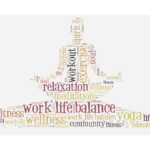
Wellness versus wellbeing
While wellness is the ‘… state of being healthy, especially when you actively try to achieve this …’ (Oxford Dictionary), ‘wellbeing’ is considered to be ‘… general health and happiness, a state of emotional/physical/psychological wellbeing …’ (Oxford Dictionary).
These definitions show us that wellness is the daily pursuit of achieving a sense of wellbeing, where wellbeing is the outcome of the pursuit. In simpler terms, wellness is the action taken and wellbeing is the effect of taking the action.
Wellness is, therefore, a critical component of wellbeing.
There are five distinct and holistic aspects of life that are included in wellbeing. Gallup are renowned for the research they conduct globally, and their research shows that while there are numerous definitions of wellbeing, they have identified five components of wellbeing that together make for a thriving life:
• Career wellbeing: You enjoy your daily tasks.
• Social wellbeing: You are surrounded by enduring friendships.
• Financial health: You have good money management.
• Physical health: You have the stamina to complete tasks.
• Community wellbeing: You enjoy your neighborhood.
For employers, poor employee wellbeing has costs that extend far beyond insurance; in the end, it affects employee engagement, productivity and performance.
Recent Gallup research shows that 4% of US adults are flourishing just in terms of physical health.
By adjusting for factors such as age, gender, race/ethnicity, income, education, geography and marital status, Gallup compared these adults to those who are thriving in all five aspects of wellbeing.
People who are only thriving physically (compared to those who are thriving in all five areas) are:
• more likely to miss 68% more work per year due to illness.
• more likely to file about three times as many workers’ compensation claims.
• five times as likely to look for a new job in the coming year.
• more than twice as likely to actually switch employers.
Physical wellness is one of the first things an organization focuses on when creating a ‘wellness’ plan for their company. Even though it seems like a physical wellness plan is easy to measure, it is but one driver that underpins employee productivity and satisfaction.
To be successful, effective and efficient, a ‘workplace wellness plan’ has to embody a holistic approach that assists individuals to create bespoke solutions that address all aspects of wellbeing. Without this, it’s a ‘tick the-box’ band-aid that will only hold the organization’s wellness together for a short period of time.

Exercise 1.3 – Five Factors of Influence on Health and Wellness
1. Make a list of the things you believe to be the biggest barriers that affect people’s health.
2. From this list, identify those things that an individual (either alone or with the assistance of the organization) can have some control over.
3. Write down three things you believe the organization can do to simply and easily assist its employees to reduce some of these barriers.

Course Manual 4: Great Expectations
Introduction
To live a higher quality life, across the entirety of your life, maintaining your optimal level of wellness is vital.
Because everything we do and every feeling we experience has an impact on our wellbeing, wellness is important.
Our actions and emotions are therefore immediately impacted by how we are feeling. It is a never-ending circle. In order to manage stress, lower the risk of illness and maintain healthy interactions, it is crucial for everyone to reach optimal wellness.

But whose responsibility is it to ensure the health and wellbeing of a population?
In May 2019, the World Health Organization (WHO) released the 11th Revision of the International Classification of Diseases (ICD-11) and included burnout as an occupational phenomenon. They stated:
‘Burnout is a syndrome conceptualized as resulting from chronic workplace stress that has not been successfully managed. It is characterized by three dimensions:
• feelings of energy depletion or exhaustion.
• increased mental distance from one’s job, or feelings of negativism or cynicism related to one’s job.
• reduced professional efficacy.
Burnout refers specifically to phenomena in the occupational context and should not be applied to describe experiences in other areas of life.
It may be a coincidence, but it seems that from the moment this definition was updated, individuals from around the world moved to a different consciousness around health and wellness, including moving to a new standpoint around who is responsible for the health and wellness of individuals.
Interestingly, burnout was also previously included in ICD-10, in the same category, but the definition wasn’t quite as detailed or descriptive. Importantly, it did not previously have any impact on the thought processes of individuals.
The weight of expectations
For a long time, we’ve been taught that if we’re unwell, we go to a doctor and we rely on them to tell us what’s wrong with us, and what we need to do to be ‘fixed’.
This can often entail receiving a diagnosis, a prescription and sometimes, referrals to other professionals who specialize in the area that is of concern. We’re passed from one person to another, almost as if we’re on a conveyor belt where different people add a widget, nut or bolt and someone else alone the line might also tighten some screws.
Most of us don’t have much (or anything) to say throughout the process. We simply do as we’re told, because that’s what we’ve been trained to do.
What this system has created is an expectation that when something goes wrong with your health, someone else is responsible for solving the problem and providing the solution.
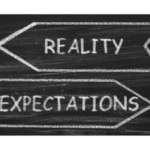
Pre-pandemic, a workplace wellness movement of sorts had started with approximately 25% of companies introducing a wellness program of some sort. However, they were largely ineffective and almost impossible to measure because of the type of services provided and the way they were offered to employees.
Coming less than 12 months after the WHO release of ICD-11, the COVID-19 pandemic served to exacerbate global consciousness around health and wellbeing. With that came strongly voiced expectations around the health and wellness services that employees now demand from their employers.
Part of this demand has come from the increase in the divide between the upper socioeconomic class and the middle- to low-income earners. This has mainly come about because of affordability issues, but also because the sheer number of people in these groups has created a groundswell with a growing voice that will not stop until it is heard.
The pandemic also highlighted the vulnerability of each and every organization’s ability to survive – let alone thrive – if their people and, by association, their business, are inherently unwell.
A final overlaying factor is the movement that came to be known as the ‘Great Resignation’, where individuals simply walked away from workplaces they deemed to be toxic and put their health and wellbeing at the forefront of their life equation. This added specific and immediate pressure onto almost every organization in the world to lift their game, in terms of their workplace culture as well as the health and wellness support that they provide on an ongoing basis.
So, who is responsible?
The missing piece in all of this, and perhaps the element that creates all the confusion and the lack of action, is where the responsibility for health and wellness really lies.
Unfortunately, there isn’t a clear answer.
It’s generally accepted and acknowledged that an employer has a legal requirement to provide a safe workplace for their employees. Whether deliberate or unintentional, when the WHO released ICD-11 they seemed to be placing responsibility for health and wellness at the feet of organizations. The behavior of individuals since then seems to indicate that they believe this to be correct.
It would seem sensible that individuals should be responsible for their own health and wellbeing. After all, each and every one of us is bio-individually unique, so we are actually the only one who can possibly know what it is we need to be well.
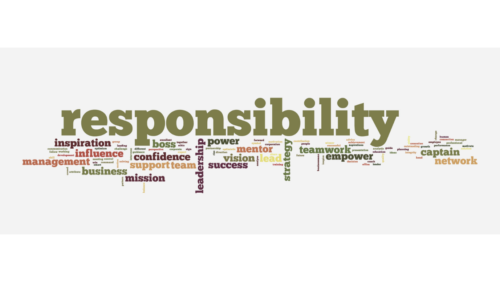
But then the ‘grey area’ creeps in.
In general, we’ve been trained by the medical profession, and in some ways brainwashed by marketing campaigns, that our only way forward is to hand over responsibility and surrender to the instructions being provided to us.
What this has created is a society of individuals who are wholly dependent on others for their health and wellbeing, and this doesn’t work within the realities of life.
A workplace must be safe, but this is also dependent on individuals playing their role in maintaining that safety. Health and wellbeing is an individual’s responsibility, but managers and leaders need to play a role in creating a business environment where individuals are enabled and actively encouraged to be in good emotional, mental and physical health.
The responsibility for establishing a safe and healthy workplace should fall to the employer, but this only works when employees also take part in fostering an environment where they can achieve alongside their co-workers.
So, who is responsible for health and wellness?
It’s clear that the answer is both employers and employees.
Each individual is ultimately responsible for their own health and wellness, because wellbeing is, and has to be, a personal matter. The organization can contribute to the wellness journey of their workers by providing a framework, and then allowing each individual to approach how they work and take care of themselves within the framework they’ve been given.

Unconscious behavior
Marketing gurus will promise anything and everything to satisfy society’s rising desire for everything “now”, even assurances of wellbeing. While some of their claims are supported by reality, years of experience and contemporary science and technology, many are gimmicky, while others contain entirely unsupported assertions or are outright lies. The issue is that they can produce ‘yo-yo’ results that are detrimental to anyone’s long-term health.
Psychologists often reach an unexpected conclusion when attempting to explain how our mind functions: people routinely make decisions without giving them much consideration – or, more specifically, before they have given them conscious thought. Unconscious ideas that we are not even aware of usually play a significant part when we decide how to vote, what to buy, where to go on vacation and a variety of other things. Recent studies have revealed how significantly our unconscious mind impacts how we connect with others on a daily basis.

Case Study: Unconscious Bias
The process of determining whether a candidate was qualified to occupy public office was the subject of one of the most well-known experiments to demonstrate the influence of the unconscious.
A group of fictitious voters were given a brief opportunity to look at the online portrait photos of senatorial and governor candidates from states other than their own.
Then they were asked to evaluate the applicants based on their brief glances of each photo.
Surprisingly, the results of the straw poll were a reliable representation of the decisions made later by actual voters in those states.
In two out of three elections, the results were predicted using competency assessments based on a brief glimpse of the candidates’ faces.
Automatic cognitive processes
Scientists whose primary goal is to research and study the mind have been interested in the impact of unconscious influences on our thoughts and behaviors for more than a century.
In his extensive body of work, Sigmund Freud stressed the conscious as the seat of reason and emotion, and the unconscious as the home of the irrational.
However, modern cognitive psychologists have revised Freud’s worldview to emphasize a less divided psychological dynamic.
It turns out that both ways of thinking enable us to adjust to the changing needs of a species – one that can survive by using its mental resources to hunt a Stone Age mastodon, engage in a Middle Ages joust or, in the 21st Century, short-sell Apple’s stock.
The id (the primitive and instinctual part of the mind that contains sexual and aggressive drives and hidden memories), the super-ego (operating as a moral conscience) and the ego (the realistic part that mediates between the desires of the id and the super-ego) were disregarded in post-Freudian psychology in favor of a more practical interpretation of what constitutes our unconscious self. The distinction between the automatic and the controlled in modern society has been explained by Nobel laureate Daniel Kahneman.
In this new model, automatic cognitive processes, which lack deliberate thought or preparation, are quick, effective and frequently outside of conscious awareness. They simply need a minimal stimulation, such as the words on this page, which you may easily associate with their intended meaning.
Conversely, consider the use of controlled procedures. Imagine the laborious work it takes to complete your tax returns – they need deliberate and rather slow conscious thought.
The automatic and regulated systems work in harmony but occasionally clash, much like Freud’s id, super ego and ego constructs. For example, to avoid being hit by an approaching bus, you must act quickly, but you must also restrain yourself from punching the inattentive bus driver.
We frequently make snap judgments – relatively automatic mental processes – and for good reason.

The majority of people we interact with are strangers we might never see again, such as those we encounter while waiting in line somewhere, or people we come into contact with while performing their jobs such as cashiers, taxi drivers, waiters, insurance agents, teachers and so on.
This is in contrast to the relatively small number of people that each of us knows extremely well.
Based on scant information, the default unconscious perception develops predictions about personality and conduct. In contrast to what we expect of truck drivers or librarians, we have distinct expectations about how waiters should behave. These expectations, which are solely based on a person’s status in society, come to us without our conscious consideration.
It is a reflexive response to how we unconsciously interpret other individuals throughout the course of the day. We must make a deliberate, intentional effort to set aside any unjustified and occasionally irrational, unfavorable feelings we might have for other people. The more effort we must expend consciously to overcome an unconscious influence, the stronger it is. This is especially valid for repetitive behavior. A person with a weight problem might grab for the potato chips when they get home in the evening if they have a drink, just as an alcoholic might easily ignore the opposing need to exercise restraint.
It’s crucial to comprehend the pull that the unconscious has on us in order to prevent being overtaken by difficult-to-understand and difficult-to-control urges. Making friends, adjusting to a new job or kicking a drinking habit all require the ability to control one’s own behavior, which is dependent on factors other than genes, temperament and social support systems. It also depends, in no small part, on our ability to recognize the automatic impulses and emotions that affect every facet of our waking existence, and work to fight them. We must develop the ability to understand and accept our unconscious self if we are to succeed in the world.
Unconscious thoughts, feelings and emotions affect not just how we view ourselves and the world, but also how we behave in daily life. Psychologists have been debating the influence of the unconscious on behavior for decades.
B. F. Skinner and the Behaviorist School of Psychology made a strong case for the majority of the 20th Century that our actions were wholly dictated by what we saw, heard and touched in our surroundings, and that conscious intention had no bearing on any of them.
The classic experiment in which a rat discovers through trial and error that pressing a bar leads to the animal receiving a food pellet each time embodies this principle.
According to the Skinnerian worldview, the majority of what we do can be summed up as a more sophisticated variation on the theme of pressing the bar with one’s snout.
Therefore, in order to get what we want, all we have to do is press the appropriate bar, which could be as simple as sliding a dollar bill into the candy dispenser.
The behaviorism of Skinner was refuted by research in the 1960s. However, the opposing extreme, which holds that conduct is never directly influenced by environmental cues and is always under purposeful control, is also untrue. Even just observing or listening to someone else might cause us to act in ways we are unaware of.
People naturally copy and replicate the physical actions of others, including their body postures, arm and hand movements, and emotional expressions. These impulses can be seen throughout the natural world in the fluid manner that fish schools, antelope herds, and bird flocks coordinate their social behavior to move almost as if they were one cohesive organism.
Since very young infants and toddlers in humans have been seen to voluntarily mimic and imitate what people around them are doing, psychologists have claimed that this desire to copy others may help us learn language and other behaviors from our parents.
Furthermore, imitation does not end with childhood. You can experience what is known as the “chameleon effect,” where you adopt the body language and other physical characteristics of someone with whom you have just had a conversation at a party.
Examples of this include the same head scratching, crossed knees, and folded arms. The mimicking continues until you decide to rehydrate your beverage and look for a new conversation partner, whose posture and gestures you then adopt, like a chameleon blending in with its surroundings.
It would seem, then, that adopting the same actions as others makes adaptive sense, particularly when you are unsure of the right move to make in a particular social circumstance.
Without the need for a clear indication that tells others what to do next, imitation promotes a social mindset. For example, waiting patiently in line inspires others to follow suit; opening doors for neighbors, controlling one’s dog and avoiding littering inspire others to act morally.

Unintentional mimicry encourages empathy, which acts as a “social glue” to bind even complete strangers together. When two or more people perform the identical action simultaneously, such as troops marching or churchgoers singing a hymn, the strongest type of mimicry occurs.
Even when those engaged have never met previously, behavioral synchronization increases cooperation, according to research.
Given this, it’s easy to see how perception about a situation can gain momentum in what seems like the blink of an eye. Pre-pandemic, workplace wellness programs were a ‘nice-to-have’ service that a small percentage of organizations chose to give to their employees. Post-pandemic, workplace wellness programs are a ‘must have’ and in a significantly ramped-up format than has ever been provided before.
It’s no longer okay to provide ‘wishy-washy’, watered-down and generic ‘wellness’ sessions that make everyone feel good for five minutes. Now, survival of the organization depends on providing bespoke, tailor made programs that provide every individual the unique solution they need for their individual situation.
Understanding our unconscious behavior is critical to creating a successful health and wellness program that will be both efficient and effective. If we understand our pre-conceived and long-held views, including about who is responsible and what they need to do to solve the problem and provide solutions, we can step back, look at the situation from a new perspective and collaborate to create a new pathway forward.

Exercise 1.4 – Conscious Connection
2. Set an intention about this thing.
– For example: “I want to go for a half hour walk three times each week.”
3. Create three steps that will help you to achieve this intention.
– For example: “On Monday, Wednesday and Friday, the moment I get home I will put my walking shoes on and walk to the local park and back.”
4. Identify the emotion you want to feel as a result of successfully achieving this intention.
– For example: “So that I can forget about work, feel my stress dissolve and my happiness at being in nature take over.”
5. Write down when and how you will take your first step.
6. Write down how you will hold yourself accountable for taking this step.

Course Manual 5: The Principles of Wellness
Introduction
62% of Americans agree that their health is more important to them now than before the COVID-19 pandemic (Source: Ipsos survey Dec 3-6, 2021).
This statistic is mirrored in similar surveys conducted in other places around the world.
Health and wellness is THE focus of the current moment in time, and it’s not going away anytime soon.

Health and wellness will never be the same again after the pandemic. And it’s not just because the pandemic brought people face-to-face with their mortality in a way that hasn’t been experienced since the Spanish flu was experienced globally in 1918. The marked difference post-pandemic is that people are embracing their rise in consciousness and taking positive action to change their lifestyle, stay well and dramatically impact the way they live.
Trends, business opportunities and new wellness careers are popping up as if out of thin air and a new wellness revolution is in full swing.
In every corner of the developed globe, people are finding the most efficient ways to connect themselves to health and wellness. With the collaboration between technology and wellness providers, people can now access products and services that have been developed anywhere in the world. It is this collaboration that has blown open the possibilities and opportunities for development within the wellness industry.
Never before have barriers to entry been so low. Furthermore, the introduction of technology has also seen a significant challenge made to the long-held belief that health and wellness is a niche industry that can only be serviced in certain ways and by certain providers.
Products and services are more readily available, more easily accessible and are provided in ways that are more adaptable to every lifestyle. No longer are there large price tags, big chunks of time required or being able to get to specific locations in the world. Now, you can supercharge your health and wellness from the comfort of your home, for a fraction of the price it used to cost.
The pandemic brought health and wellness into the conscious mindset of everyone, and the momentum that gathered behind this has been overwhelming. No matter the cause, it is undoubtedly a good thing that individuals are now focusing on their health as a priority. This can only serve to support the collective health and wealth of each nation around the world.
No matter the product or service that is provided in the marketplace, there are a number of accepted principles of wellness that drive the industry.
Wellness is seen as the maximum potential an individual has to achieve health. It is an active lifestyle and holistic mindset that doesn’t wait for things to go wrong before taking action. People who exhibit neither symptoms nor indicators of illness are frequently considered to be in good health.
Beyond the absence of symptoms, wellness focuses on realizing one’s full potential and avoiding health issues.
According to holistic philosophy, a person’s body, mind and spirit are all interconnected. For the person to be healthy, these elements must work together as a unit. As a result, if a health issue arises, the “whole” person needs to be evaluated and treated. This viewpoint is distinct from the conventional “allopathic” style of healthcare, which places a greater emphasis on symptom relief. It is crucial to understand that when an allopathic approach is taken, even a natural kind of healing, the treatment process is not holistic.
Principles of wellness
Throughout the wellness industry, there are generally seven principles of wellness that underpin the guidance the industry provides:
1. Holistic wellness. It is crucial to integrate body, mind and spirit as one whole person rather than concentrating on symptoms.
2. The only real healer is the self. The healing process can only be aided by health professionals. Your body, mind and spirit are the ones that perform all the healing.
3. You are in charge of your health. Instead of placing the blame on yourself, consider each disease as a lesson in obtaining wellness. Acknowledge your positive feelings.
4. Being positive gives you power. Positive thinking equips you with solutions, control and a path out of illness and issues, whereas negative thinking deprives you of power and control. Positive and negative qualities make up everything in equivalence. There is good in everything!
5. Achieving wellness requires effort. Don’t wait for excellent health to come around, or rely on others to solve your difficulties. To reach wellness, you must take an active role in your health. It is crucial to consult with your healthcare practitioner and ask questions.
6. Wellness is results-driven. By concentrating on issues, do not let yourself get caught. As soon as a problem is identified, focus your efforts on finding remedies.
7. Treatment is not necessary if prevention is practiced. Preventing issues requires very little time, money and effort. Prevention is actually preferable to treatment.
The eight dimensions of wellness
Eight interdependent components make up wellness: financial, emotional, physical, occupational, social, spiritual, environmental and intellectual. One’s health, wellbeing and quality of life will suffer if one of these dimensions is neglected over time. A holistic harmony to one’s own wellbeing is provided by a well-rounded balance of various wellness characteristics.
Source: The School Counselling Yogi
Balanced wellbeing involves the body, mind and spirit, just as a balanced diet is necessary for good nourishment. This multi-faceted approach to wellness emphasizes the value of optimism and constant inspiration for encouraging healthy behaviors to raise one’s quality of life.
Each aspect of wellness contributes to fostering and developing a healthy lifestyle.

Emotional Stability
The capacity to recognize and manage one’s own emotions falls under the category of emotional wellbeing.
Emotional wellbeing is defined by the National Institute of Health as “… the capacity to successfully manage life’s pressures and adapt to change and tough circumstances …” (NIH, 2018).
Emotional health is the capacity to deal with life’s challenges successfully and form fulfilling connections with others.
People with strong emotional wellness are capable of overcoming obstacles in life, are in control of their emotions and behaviors, and are self-assured.
Resilience can be developed by overcoming obstacles in life and learning that failures can be overcome. Regular participation in leisure and recreational activities might help to maintain or improve emotional health.
Engage in activities that use all of your senses, including taste, touch, sight, and hearing. Play with your pet, watch your favorite movie, eat your favorite cuisine, light your favorite candle, listen to music, and enjoy the sunset.

Physical Dimension
This dimension includes all aspects of health that have to do with the body’s physical structure, such as diet, exercise, weight management, ergonomics, tobacco use, illness and disease prevention.
Physical activity, a nutritious diet and enough sleep all contribute to physical wellness.
There are several types of physical activity that range from light to robust in intensity. Yoga, riding a bike, jumping rope, playing sports, running, walking, jogging, skiing, dancing, tennis and gardening are all good ways to keep your physical fitness.
Smoking is a common coping mechanism for many. Unfortunately, using this coping mechanism can raise the risk of premature death and a host of physical health issues, such as cancer and heart disease.

Occupational Wellbeing
Occupational wellness includes all aspects of health that have to do with feeling satisfied in your work or career.
The feeling of happiness with your career choice is known as occupational wellness.
Building relationships with co-workers, juggling work and play, and controlling workplace stress are all aspects of occupational wellbeing.
Finding meaningful and financially gratifying employment could be a goal for occupational wellness. Finding work that aligns with your values, interests and abilities can help you keep a healthy work-life balance.
Take into account the office culture, and assess your level of support; if you find that you lack support, ask for aid from loved ones, and make sure to partake in leisure activities that can help offset job stress.

Social Wellbeing
Social connections, relationships, and personal expression are all included in the concept of social wellness.
The chances to improve your social wellness status offered by the resources described in this area can have a positive effect on your general health and wellness.

Spiritual Health
All aspects of wellbeing related to the search for meaning and purpose in life fall under the umbrella of spiritual wellness. Spiritual wellbeing can entail having faith in a higher power, but it is not necessary for it to be connected to a particular religion.
The options to improve your spiritual wellness are provided in this part and can have a favorable effect on your general health and wellbeing.
Social wellbeing can be related to a feeling of community and connection.
The social determinants of health involve establishing and preserving a strong social support system.
Asking a co-worker or friend out to lunch, joining a club or organization, establishing healthy boundaries, using assertive communication techniques rather than passive ones, being real and authentic with others, and treating others with respect are all ways to develop a healthy social dimension.

Intellectual Wellbeing
The term “intellectual wellness” refers to a person’s whole state of health that includes their ability to progress intellectually.
When you are in a state of intellectual wellbeing, you are aware of your individual creative potential and actively look for ways to put your knowledge and skills to use.
When you engage in activities that promote mental development, you are cultivating your intellectual wellness.
You can maintain or enhance your intellectual wellness by reading, working on difficult crosswords or Sudoku puzzles, debating topics with others who hold different opinions, learning a new language or musical instrument, taking up a new pastime or teaching and tutoring others.
You develop your cerebral health when you push yourself to acquire a new skill. Focus, memory and critical thinking abilities all seem to improve for those who are concerned with their intellectual wellness.

Environmental Wellbeing
All aspects of health that are related to the environment and how the environment may affect human health are included in this dimension.
Eco-friendly practices, active engagement in recycling and correct disposal of gadgets and medications, energy, fuel and water conservation, and the usage of sustainable products are all part of environmental wellness.
The environment you live in affects your environmental wellness.
This aspect of health establishes a link between your general health and the health of your surroundings.
Your surrounds, including your social and physical surroundings, have a big impact on how you feel. If your surroundings are cluttered and disorganized or you feel dangerous, it may be difficult to feel good.
Environmental wellness is impacted by a number of issues, including pollution, violence, rubbish buildup and water conservation. In order to manage environmental wellbeing, one can organize neighborhood watch programs, recycle, start a garden at home or in the neighborhood, buy goods with less packaging, refrain from littering, and save electricity and water by turning off lights and faucets when not in use.

Financial Wellbeing
Financial wellness includes all aspects of welfare related to money, such as knowledge and expertise in budgeting and spending management.
Financial wellness is a feeling of satisfaction about your financial situation. Finances are a common stressor for people, so being able to minimize worry about this aspect of your life can enhance your overall wellness.
Options for managing financial wellness include having a household budget, starting a savings account and adding to it every month even if it is just a small amount, saving some of your income in an emergency account, cutting back or limiting unnecessary expenses, avoiding credit card debt, donating to a meaningful charity, shopping at thrift stores, utilizing the library for free books and DVDs, and cooking your own meals instead of dining out.
Try tracking your spending for a month to see where your money is going and set goals based on what you find.
Creating healthier people and workplaces
Thanks to the rise in consciousness attributed to the pandemic, organizations are now turning their attention to creating healthier employees and, by extension, healthier workplaces.
You can’t force someone to be healthy; they have to want to achieve that for themselves. You can, however, create situations and provide products and services that influence them to choose to be healthy.
Luckily, the pandemic affected a rise in consciousness around health and wellbeing, so people generally need less convincing that being heathy is a worthwhile pursuit.
The number one focus for any organization wanting to provide health and wellness programs to their employees needs to be the provision of a tailor-made solution that can adapted by any individual working for them.
Generic solutions will no longer cut the mustard – bespoke programs that have been designed to specifically meet the needs of the unique individuals within the organization are the only thing that are going to work.
There are a number of things an organization can do to assist their employees in stepping into a healthy routine:
1. Pay attention to behavior: The first and possibly most crucial step is to comprehend what their employees are regularly doing. Who are they? What’s important to them? What are they saying versus what they are doing? What do they think are good habits? Do they consider their current habits to be a problem? What are some of the elements that prevent and encourage these habits? What is getting in the way of them establishing new habits?
Making behavioral observations is key to understanding the health beliefs your employees have and what makes them tick.
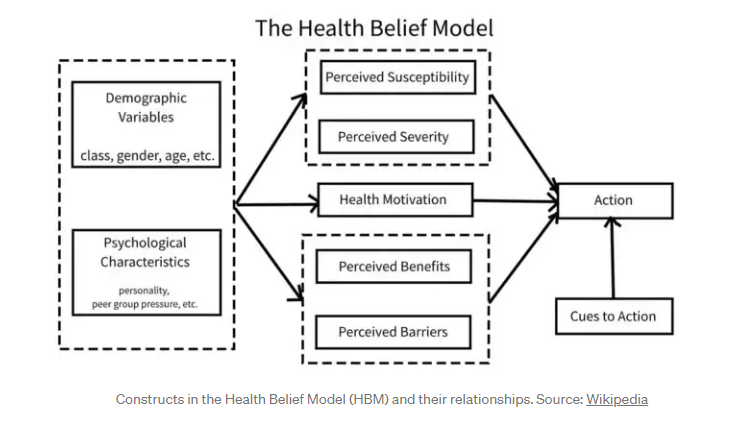
2. Make it simple and fun for them: to create a good habit, you must include enjoyment and simplicity. Asking someone to join you in a run if they detest running won’t entice them into healthy habits. Discover their preferred pastimes and then make them part of the plan.
Does dancing appeal to them, for instance? Without the stress of a rigorous workout, dancing is a simple and pleasurable approach to get people moving.
What about a nutritious dish they enjoy in terms of diet? Think about ways you can increase the frequency of that meal to help them alter the healthy-yet-delicious food choices they make.
3. Work as a team: It’s crucial that you participate in the activity with them when you’re trying to get them to do it. This not only adds a little type of social pressure, but it’s also more enjoyable for everyone involved!
The likelihood that an activity will become regular is increased by having friends or a group that share your interests.
4. Work it into your regimen. Next, repeat the process.
A habit is a pattern of action that is automatic and repeated in response to a signal. When will you start practicing the habit?
Maintain that, and eventually your brains (and those of your subjects) will come to associate a cue with the behavior. Et voila! One develops a habit!
5. Chat about how they’re feeling: Discuss the advantages of the activity and how it makes them feel as a group. When it comes to health, results like weight reduction or increased speed are frequently delayed, whereas feelings like a healthy glow or contentment from taking care of your body are more noticeable.
Two-way, regular conversation about activities will give you the fastest and most accurate information you need about what’s loved, what’s working and what will likely help keep a health outlook long-term.
Modify the routine to suit their comfort levels based on their feedback regarding the activity’s perceived advantages and disadvantages.
6. Measure ongoing progress: A big element of creating a habit is being aware of your progress.
Progress doesn’t have to be measured on an individual basis, it can be measures against group metrics. Regular measurement gives you real-time feedback about where the program is working, where it needs tweaking and suggestions on how it can be improved.

Sustainable wellbeing
Sustainable wellbeing is a concept that is gaining greater traction as time goes by.
We’ve heard about sustainability for some time now, and in recent times we’ve begun playing on the edges of wellness and ways that we can incorporate more wellness into our days.
But the two concepts have only recently been put together as a thought about where we as humanity can go if we consciously expend our energy and efforts.
Sustainable wellbeing is about living at the nexus of personal wellness and environmental sustainability. In addition to pursuing solutions that increase the resilience of social and ecological communities, it involves achieving balance for oneself.
Many people are passionate about leading sustainable lives, and frequently think about how their actions affect the environment in which they live. More and more, people are adopting this strategy in their lives and realizing how practicing sustainable behaviors also benefits them personally.
A person’s health and welfare are intrinsically linked to the health of their immediate environment, and the relationships between the two can be intricate. However, it is possible to have a more comprehensive awareness of how the decision we make in our life to help protect the environment is also a step towards protecting ourselves.
Similar to sustainability, wellness is a lifelong endeavor that calls for help from loved ones, introspection and support from the neighborhood community.
It implies that we go beyond ourselves as isolated individuals as we consider how to take care of our own personal wellness, both bodily and emotional. We begin to recognize the connection between our health and the health of the global human population and ecosystems.
It signifies that we are aiming for everyone’s collective wellbeing: health for ourselves, others and the environment. Extending our search for personal wellbeing to include the sustainable component is intriguing and exciting, and it pushes the boundaries of what we know to be possible. It also indicates that the actions we are taking are contributing to the sustainability of the environment and our communities.
Finding the profound connection that each of us has with nature, and letting it serve as a source of inspiration and validation for who we are as earthbound beings, is the goal of sustainable wellbeing.
Sustainable wellbeing entails realizing our interconnectedness with the rest of the world. It enables us to go beyond our individual wants and recognize that true wellbeing is rooted in the health of the planet’s ecosystems, the health of all life and the demand for equity, social justice and resilient communities.
We are aware that where these converge, genuine sustainability is seen.
We discover that we are content with our lives, our interactions with others, and the environment. We are rooted in the relationships we have and in the work we do.
What does it look like?
Sustainable wellness is multi-faceted, so it’s helpful to look at a few different aspects when attempting to describe what it looks like:
• Personal: realizing the importance of seeking the sources of happiness and health in our own lives.
• Community: being a part of a group where we can offer and participate while also knowing that others are there for us.
• Environment: ensuring that our behavior is consistent with our ecological sustainability beliefs and aspirations.
Sustainable wellbeing is not as difficult to attain as you might believe. It frequently occurs, and whenever it does, you are in a terrific position. You are there whenever you take a step that enhances your health as well as the health of others, the environment, and yourself.
For example, you might have seen and experienced it when shopping at a local farmer’s market, where you had the opportunity to buy nourishing food, direct from a local farm, in a way that limited the distance getting the food to you, where there was minimal packaging and you could take it home with you on your bicycle.
There are so many ways to incorporate sustainable wellness into our lives. The question becomes: ‘How can we do so in an affordable way that makes it available to everyone?’

Case Study: Connecting Sustainability to the Eight Dimensions of Wellness
Our Physical Wellbeing.
In addition to getting you to where you need to go, using other modes of transportation like brisk walking, jogging, cycling, or even rollerblading are all heart-pumping exercises. So, by reducing the usage of cars and public transportation, we are not only reducing our carbon footprint but also enhancing our physical wellbeing.
Being conscious of your eating choices also has a positive effect on the environment and your physical health, especially if you are unable to commit to these modes of transportation or they are not accessible to you.
In this way, you may fill up on healthy foods while also lessening your carbon footprint. It goes without saying that meals derived from plants often have far lower carbon footprints than foods derived from animals, which is why so many people have started to follow a vegetarian or vegan diet.
A plant-based diet also contains a wealth of the vitamins, minerals, and proteins your body needs to sustain your physical wellbeing.
Our Social Wellbeing.
You’ll discover that achieving sustainable goals in a big community takes a lot of teamwork.
Attending sustainable activities, distributing knowledge and news among friends, volunteering, and establishing relationships within the community are all behaviors that are typical of people who are attempting to live more sustainably.
Today, you may even create a social network online with people who have similar beliefs and aspirations to your own.
Being a part of this community and having a strong support network is crucial to putting your own welfare first, whether you’re feeling frustrated or burned out.
People in communities who are actively pursuing a sustainable way of life will support one another in a wide variety of ways, you’ll find. Your mental health and the wellbeing of the community are both positively impacted by it.
Our Emotional Wellbeing.
A person’s physical health benefits from maintaining the vitality of their environment, but it may also help them feel less stressed, which is one of the most often encountered emotions.
It has been demonstrated that just 20-30 minutes a day spent walking or sitting in a natural setting can considerably reduce levels of the stress hormone cortisol. You will experience a stress-relieving natural environment as a result of connecting with nature, which is an important step towards a sustainable future.
This is a fantastic approach to protect the environment while also taking care of your mental and emotional health. So why not take the family out for a couple of bike rides?
Instead of driving, take a trek or walk to your desired locations. If you enjoy taking a few vacations each year, camping is a terrific method to increase your sustainable living.
Utilizing firewood, going without electricity, and avoiding hotels, trains and cars are all excellent methods to move towards environmentally friendly vacations.
Our Environmental Wellbeing.
Simply put, environmental wellbeing refers to our awareness of and attention to the environment around us. It may be your room, the office, your house, the globe, the school – you get the idea.
Consider the effect that location is having on you. Thinking about this with a sustainable perspective and putting your local environment’s wellness first may motivate you to spend less time acquiring material possessions.
Instead, you’ll start devoting part of your precious time to creating extra space that makes you happy, comfortable and productive.
Many people who want to live sustainably have switched to a simpler way of living.
Okay, so you might not be able to or want to purge your space of everything that makes you unhappy. But making the effort to donate unused clothing, take down unused lights or decorations, or reduce the number of ‘things’ you accumulate in your house are all excellent sustainable decisions. You may build a sustainable, uncluttered, stress-free atmosphere by making these decisions.
Our Spiritual Wellbeing.
Your ability to comprehend and interpret your experiences is a sign of your spiritual welfare. It’s also what your mind experiences when it needs comfort or relief.
There is a group that focuses on the correlation between higher degrees of exposure to nature and nature’s stronger spiritual inclination.
Being in nature can provide some people with a profound sense of relief or peace that is in many ways related to spirituality.
Others, however, may use spirituality as a means of giving purpose to their daily activities or behaviors, such as taking the time to sit outside or recycling or adopting a vegan diet.
No matter how each person is affected, our natural surroundings give us a space for introspection and mindfulness. Living a more sustainable lifestyle can help to preserve ecosystems so that we can continue to learn about and care for them.
The next time you go for a stroll, use it as a moment for introspection and solace.
Our Intellectual Wellbeing.
There is undoubtedly a wealth of knowledge currently available about the state of our environment.
It is always evolving, and new strategies are continually being developed to help us live sustainably.
Attending a lecture, reading news articles or scholarly studies on sustainability, or attending local government meetings on sustainability are all good things you can do for your intellectual health.
Additionally, it gives you the authority to spread verifiable facts.
Learning how to make educated decisions both individually and as a group is a crucial component of sustainable living.
It’s one of the essential elements in developing a setting with the appropriate modifications that have an impact and are constructive. Of course, a lot of new initiatives for sustainable living have been introduced into our culture, including programs for recycling food waste, encouraging employees to bike to work, and promoting healthy eating on more days of the week.
However, they are all little adjustments that you may gradually build on.
Our Financial Wellbeing.
Many of the sustainable habits you develop can really result in financial savings.
They may also assist in easing some of the pressure that comes with managing your money. For instance, making little adjustments like caulking air leaks in your home or apartment can reduce your cooling and heating costs by 10% to 20%.
Another significant one that many people have embraced is thrifting.
It’s a terrific way to get affordable apparel and it has a far smaller environmental impact than purchasing new items.
If you often drink water from a bottle, you might be shocked to learn that switching to a reusable bottle might result in an annual savings of about $266 in plastic water bottles.
Our Occupational Wellbeing.
Our workplace can be challenging, especially if they are opposed to implementing lasting changes.
Make sure to take part in any programs for a sustainable workplace if you want to establish a more environmentally friendly workplace.
If there isn’t already a regular gathering of co-workers to discuss sustainability, consider starting one or holding training sessions.
Setting up a recycling station or installing an acoustic wall panel are two examples of easy measures you can take to assist your workplace establish a common set of objectives.
Additionally, it can improve team and individual morale. There are various ways to get engaged in developing and putting into practice sustainable projects at work, regardless of the vocation you are pursuing.

Exercise 1.5 – Examining Wellbeing
1. Write down the things you do for yourself regarding your physical wellbeing.
– Write down any areas you would like to focus on to add to your physical wellbeing.
– What stops you from having those things right now?
– What are three simple things you could do to allow yourself to add one of these things to your life?
– Who do you need to support you and/or help you to achieve by adding this to your everyday life?
2. Ask yourself the same questions with regard to your emotional, spiritual and social wellbeing.

Course Manual 6: Benefits: Employers and Employees
Introduction
Essentially, the concept of employee wellness is not new, although it has not always been a US$8 billion industry where employer-funded gym memberships, meditation sessions and catered meals are the standard.
In 1864, the Pennsylvania Mine Safety Act was enacted into law, which promised minimal ventilation to Pennsylvania mine workers to help prevent the black lung, and which marked the commencement of occupational health laws in the United States.
A few years later, the Commonwealth of Massachusetts initiated the first state-level factory inspection program with a more proactive plan. By 1891, the federal government had caught on, establishing minimum ventilation standards for mines nationwide and outlawing the hiring of anybody under the age of 12.
Since then, and especially during the past 50 years, as the economy has transformed from an industrial to a digital one, the discussion around workplace wellness has grown significantly.
The physical health and safety of workers are regularly threatened by fewer jobs, but chronic stress is a ghost that follows us all.
Employers are paying more and more attention to the value of mental health because it is the primary cause of illness and impairment worldwide.
Additionally, current research demonstrates that the main barrier to employees’ attempts to be happy and healthier is workplace culture. Beyond this, it costs money to ignore these problems.
Every year, one in five adults in the U.S. experience mental health issues, which result in 200 million lost workdays and a cost to businesses of US$200 billion. The statistics are similar in other developed countries.
As the number landscape of the work environment changes, so too does the available talent to service the requirements of the marketplace. With mental health – in particular, stress and burnout – playing a major role in the outcomes of an organization, more and more employers are investigating ways to create workplaces that are friendly and based on the concept of “psychological safety”, while also maximizing employee wellbeing with a glittering array of rewards sometimes referred to as “wellness programs”. Think of the vibrant play spaces, themed meeting rooms and data-driven snack options at Google’s international headquarters, as just one example.
There isn’t an industry that’s been left unaffected by the mental health crisis. Whether in coal mines or conference rooms, in these times an employer’s number one focus is straightforward: keep employees healthy and happy to reduce expenses.
Why workplace wellness hasn’t worked yet
Despite all the focus (and money) put into workplace wellness initiatives by the small percentage of organizations that created wellness programs, it’s still unclear whether these initiatives are actually good for our health.
In fact, a number of studies conducted pre-pandemic contend that corporate wellness initiatives may actually turn off employees who are already in good health, and can alienate those who are currently battling with mental or physical health problems.
There are several reasons why wellness initiatives fail, but behavioral economics is the primary one.

According to several research studies in the behavioral economics field, people respond better when they receive an immediate incentive for sticking with goals that are abstract and far away, like decreasing cholesterol. While randomized trials did not reveal any differences in health outcomes, cost savings, or reduced absenteeism for employees in wellness program, incentives do work in specific situations.
While it seems that the concept of incentives should work – being if we give you X, then you might take care of your health – the results show that it simply doesn’t, and the program becomes a label that the company hides behind.
People need to be engaged and personally committed to make a change to their health and the overly prescriptive, generic and boring programs that have been in place until now have not provided them with the impetus they need to get moving and make changes.
Ironically, the employees who are already healthy are the ones who gain the most from wellness programs.
Getting a voucher for the gym is just a reward for what they are already doing because they exercise frequently and visit the doctor.
Furthermore, there is no proof that joining a wellness program causes healthy individuals to adopt more healthy practices. They are merely enrolling in the program to take advantage of the benefits.
To date, organizations have created workplace wellness programs that have an underlying purpose of reducing costs, but they’ve not related or focused them specifically to the employees within their organization, nor have they necessarily put in place metrics to measure their effectiveness, or regular measurement processes that would enable them to measure the progress of what they have.
Some of the common wellness initiatives that companies have provided to date include:
• Online health risk assessments
• Weight reduction competitions
• Competitions using data from wearable fitness technology
• Biometric checks (health screenings that measure blood pressure, weight, height, body mass index)
• Gym membership reimbursements
• Fitness classes
• Flu vaccines and health clinics
• Chronic disease management and prevention
• Tobacco cessation programs
• Health and lifestyle coaching
• Chronic disease management
Programs vary widely from organization to organization, but they all provide generic solutions to hundreds, sometimes thousands and even tens of thousands of employees in the hope that they will reduce absenteeism and increase employee productivity.
The biggest problem with these programs is that they appear to create discrimination amongst the work force. For example, if an organization introduces an incentive to quit smoking, then they’re seen to be targeting all of the smokers in their ranks.
Another big problem with these programs is that they include measures that are outdated and no longer accepted as industry best practice. For example, many organizations provide access to a biometric screening program that includes a body mass index (BMI) rating. Research conducted into BMI has shown that it isn’t an accurate or effective measurement of someone’s health.
When an organization offers a health and wellness program, but then offers activities and services that aren’t relevant to the unique individuals in their workforce, it adds to the level of disengagement within the organization.

An engaged employee goes above and beyond the scope of their regular duties to support their company. They are so devoted that they constantly exemplify and promote the brand/company principles. They radiate pro-active behavior that advances the standing and goals of an organization.
Their advocacy has a huge influence in a variety of ways, including attracting excellent people in their network to develop careers inside their firm.
They also earn new followers, customers, and employees.
Above all else, they create a “contagion effect” of positive emotion and passion across their organization, which can have a significant influence on productivity, performance and attitude at work.
Because most businesses fail to regularly gather and act upon available business data, engagement is difficult for businesses to quantify.
As in the case of hiring, orientation, exit interviews and yearly employee surveys, for the majority of the time wellness data is also non-existent, despite the fact that it directly affects mood, optimism and productivity in the workplace.
Examples include morale, stress, sleep, activity and health information. Additionally, there is seldom any real-time monitoring of an employee’s mental state, level of mindfulness or even their dietary intake.
Company initiatives often fall short due to the perception of employee relevance, invisible leadership and traditional communication methods. Engagement cannot be measured with inaccurate data nor in annual terms.
Utilizing relevant and regular channels for ‘pulse checks’ on a variety of issues while compiling and managing many data points is the solution. All of this is readily accomplished if you have the proper engagement platform.
The reality is that the employee engagement model needs to be redesigned, and the solution is to think holistically.
Unbelievably, 87% of workers worldwide, according to Gallup, are not engaged at work.
This statistic is startling.
Following a town hall or announcement in a business, employees return to their work; however, if their management is not perceived as supporting the project, things may veer off course. As a result, traditional or antiquated channels of corporate communication drastically restrict and, worse, deliberately hinder your corporate interaction outside of your direct line manager. Comparing broader projects to department-led priorities might make them seem disjointed, irrelevant and deprioritized.
According to Hayes Consulting, an employee’s immediate manager determines 70% of their level of involvement. Given that a direct boss is the reason why a third of employees leave a company, that leaves another 40% of employees who are idle and unproductively hanging around.
The benefits of getting it right
While there isn’t a single answer to this issue, there are a number of actions that businesses and individuals can take to create a workplace that values humanity and compassion. When trust is at the heart of employer-employee interactions, wellness programs can go from being glitzy lacquer to being genuine components of a cohesive, human system.
A company’s most valuable asset is its workforce. Therefore, making an investment in their physical and mental health can help them strike a balance between work and life and position them to perform at their peak.

Better business results are attained by organizations with higher levels of wellbeing, including higher levels of employee engagement, increased revenue, greater customer satisfaction and fewer safety problems.
Globally, many employers remain dedicated to providing wellness initiatives for their employees. However, many employers are taking the next step and are reviewing the more conventional initiatives that only address physical welfare.
They are changing to a more all-encompassing strategy that emphasizes physical health in addition to financial, emotional and social wellbeing, displaying their dedication to accommodating various employee demands and offering a unique employee value proposition.
More engaged and effective workers are those who are physically well, financially stable, emotionally balanced and socially connected. According to research by Willis Towers Watson, companies that focus more on wellbeing achieve better business outcomes, such as higher levels of employee engagement, enhanced revenue per employee, higher levels of customer satisfaction and fewer safety accidents.
As organizations compete for talent, a culture of wellbeing may be a source of competitive advantage. Employees that work in such an environment can flourish and be their best selves.
Many businesses believe that they have no obligation to provide for their employees’ physical and emotional wellbeing, as they view this as solely a personal responsibility.
In order to optimize their workforce they must, nevertheless, maintain the wellbeing of their personnel.
According to a CareerBuilder survey, a third of workers claim that their jobs put them under too much stress and have negative effects on their health, including weakened immune systems, insomnia, high blood pressure, muscle aches, stress eating, anxiety, anger management problems, brain fog and depression. Furthermore, 79% of these employees claimed that their employers don’t offer wellness initiatives to address these issues.
Companies that offer wellness programs help their staff members achieve better results and let them truly enjoy their work through rewards and enjoyable activities. There are numerous benefits to getting your workplace wellness program right for your employees:

Enhances productivity
One of the main factors contributing to a compromised immune system is stress. Therefore, a worker who is under constant stress runs the risk of being sick. This may be avoided by offering staff programs that will assist them in managing their stress, which will in turn enable them to complete duties with greater vigor and motivation.
According to a study published in the Journal of Occupational and Environmental Medicine, wellness initiatives helped employees live healthier lives and demonstrated a considerable boost in their amount of productive time. Therefore, wellness initiatives are advantageous for both the business and the employee.

Enhances morale
The mental and emotional state of self-assurance, self-control and enthusiasm of an individual in carrying out activities or performing their roles is referred to as morale. Through activities where team members lift each other up and work towards a common objective, wellness programs successfully raise employee morale.
Participating in group activities not only helps individuals stay physically active but also improves their connections with their co-workers and boosts morale.
Improved communication within the team fosters the development of better strategies and goals. This is another benefit of improved teamwork. As a result employee bonds will be strengthened, which will enable them to increase the caliber of their output; this ultimately benefits the business.

Enhances overall health
Wellness initiatives including physical fitness activities, smoking cessation programs and wholesome meals might assist employees who are otherwise accustomed to living unhealthy lifestyles in adopting healthier ones. These initiatives push staff members to break unhealthy behaviors and develop good ones. Being with others who share their goals invigorates their inner motivation to carry them out.
A healthy lifestyle lowers the likelihood that someone may contract an illness or experience long-term health issues, as well as increasing their energy levels during the course of their working days.
A healthy lifestyle has also been shown to improve mental wellness. Improved nutrition can reduce the chances of depression, according to a National Library of Medicine study on the success of the Coronary Health Improvement Project (CHIP). Numerous studies demonstrate that upholding healthy eating practices can lower the likelihood of experiencing mental health issues including anxiety and sadness. Engagement in these activities is key to the business experiencing a long-term benefit.

Reduces stress
One of the main factors contributing to a compromised immune system is stress. An employee’s performance at work may suffer greatly if they are physically ill.
Stress makes people more inclined to engage in unhealthy behaviors, which can harm both their physical and emotional health.
There are various reasons why employers offer wellness programs, but one of the most important is stress management. Employees can unwind and temporarily focus their attention elsewhere thanks to wellness initiatives like exercise, nap breaks, yoga or meditation sessions.
Employees will be able to release their stress and regain their vitality, allowing them to work productively once more.

Encourages attendance at work
Employee attendance is encouraged by wellness programs.
They become more vested in their work and motivated to produce higher quality work since they are healthy and not under extended stress.
Employees will be less likely to take days off or vacations because they can relieve their tension at work, which will increase productivity.

Bolsters employer-employee relations
Offering wellness programs that meet the unique demands of the organization’s employees demonstrates the employer’s interest for its staff. Employee relationships with their organizations can thereby be enhanced.
Employees feel valued and are inspired to perform harder and remain devoted to their employer when they are recognized as important assets to the organization.
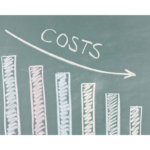
Lowers costs for healthcare
Costs associated with health care rise over time, making it difficult for businesses to maintain them. The main objective of wellness initiatives is to persuade workers to adopt a healthier lifestyle.
Employees who lead healthy lifestyles lower their risk of contracting illnesses, which means fewer doctor visits and lower health care expenses.
Since healthy employees don’t need to take as many days off from work and can complete more tasks, this also contributes to higher production.
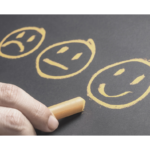
Increases employee satisfaction
The provision of wellness programs demonstrates the employer’s concern for the wellbeing of its employees, as noted in the previous statistics.
Employees will feel more appreciated as a result, which will increase their job satisfaction.
In a study by the International Foundation of Employee Benefit Plans, employees whose workplaces offer wellness programs reported greater financial sustainability, an improvement in productivity, and job satisfaction rates of 67%, 63% and 66% respectively.
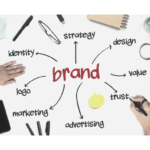
Enhances the employer’s brand
A study from the Journal of Occupational and Environmental Medicine found that 59.4% of workers expect their companies to offer wellness programs to enhance employee health.
Given that several businesses continue to adopt and execute them, many employees are anticipated to desire these programs. This will more than likely be a top consideration for individuals in the near future when selecting a job.
Employers can take advantage of it, though, by using wellness initiatives as a recruitment tool. You can enhance your employer brand and recruit more employees by providing wellness initiatives.
Employers now have a competitive advantage over rival businesses that don’t offer them. Businesses that provide wellness initiatives also benefit from increased employee and referral recommendations.

Workplace happiness
Employees who participate in wellness initiatives report feeling happier at work.
They feel valued when they realize the organization cares about their wellbeing and supports them in achieving their health objectives.
Feeling secure and content while working in a supportive workplace is contagious. They are better able to perform and deliver high-quality results when they are feeling good. A successful workplace breeds success.
Customers are important to businesses, but staff are what keep them running. A business wouldn’t be able to function without them. Employees must be given the same respect as customers because of this.
When treated well, employees are more inclined to stick around and put in hard effort for the benefit of the business.
It makes sense, therefore, for an employer to make investments in its most precious asset – its employees – if it wants the company to succeed.
Offering bespoke wellness programs that benefit both employees’ physical and mental health and enable them to perform at their highest levels at work is one of the best ways to provide value to your workforce.

Case Study: Financial Benefit When You Get Wellness Programs Right
According to a report by the non-profit International Foundation of Employee Benefit Plans entitled A Closer Look: Wellness ROI, the majority of North American employers that have examined the return on investment (ROI) of their wellness programs have discovered $1 to $3 reductions in their overall health care costs for every dollar spent.
The study looked at data from the foundation’s 2012 Wellness and Value-Based Health Care survey and compared findings between businesses that had calculated the return on investment for their wellness initiatives and those that had not. An important finding was that businesses who saw a return on their wellness investment (ROI) employed wellness program incentives like insurance premium discounts and communications tools like web linkages and social networks more frequently.
The foundation’s CEO, Michael Wilson, said in a statement to the media that even though only 19% of its members are analyzing the financial data of their wellness programs, the data provides insights into the initiatives within those programs that are successful and may serve as a model for other organizations in creating or improving their own wellness campaigns.
Another interesting finding: Compared to just 45% of the non-ROI group, almost 74% of organizations experiencing ROI were more likely to have a broader value-based health care strategy that included initiatives like health screenings, stress management programs, health risk assessments, and fitness and nutrition programs.
Premium Discounts.
The biggest difference between companies reporting wellness program ROI and those that did not was insurance premium discounts for participation, which were offered by 49% of the ROI group versus just 29% of the non-ROI group. Gift cards, non-cash incentives, prizes and raffles were among the other often used incentives.
Additionally, individuals in the ROI group were more inclined to link incentives to particular sorts of projects, such as:
• health examinations (65% ROI group versus 43% non-ROI group).
• health risk evaluations (74% versus 51%).
• advocates or coaches for health (43% versus 22%).
In particular, when incentives were connected to health screenings and health risk assessments, participation in wellness programs rose sharply.
Variety of Communications.
One of the most commonly reported factors for attaining a favorable ROI was communication. Those that saw ROI were more likely to offer the majority of wellness-related information and electronic communications than the non-ROI group, including:
• websites with resources for health promotion (43% ROI group versus 32% non-ROI group).
• using social media (18% versus 9%).
• speakers and workshops on wellness (65% versus 45%).
According to Julie Stich, the foundation’s head of research, “… determining ROI can be of enormous benefit to employers—leading to higher buy-in from organizational leaders and employees.” She did point out that it can take three to five years to start seeing cost savings, though.

Exercise 1.6 – Engagement in the workplace
1. How engaged are you with your own health and wellness?
2. What do you do, every day, that provides inspiration and leadership to your team in relation to health and wellness?
3. What do your actions currently say about the importance you place on health and wellness?
4. Are you currently leading by example? Do your people follow your lead with regard to health and wellness?
– Is that a good thing?
5. Write down three simple things you can do, starting now, that will create a positive impact on your health and wellness, but that will also provide a positive leadership example to your team.
– Create three simple steps for each thing to help you simply implement these things into your life.

Course Manual 7: Organizational Change
Introduction
The old adage ‘… If you want some things to change, you have to change some things …’ certainly applies when you’re attempting to create and implement a wellness program. Whether you’re an individual or an organization, if you aren’t prepared to change things then it’s completely unrealistic to expect you can achieve a different outcome.
Change as an individual can be hard enough, but trying to implement change at an organizational level comes with a whole new level of challenge, simply because of the number of people involved and all the intricacies and unique requirements they bring with them.
Organizational change is the process through which a firm or business changes a key aspect of its structure, such as its culture, the operational infrastructure or supporting technologies, or its internal procedures.
It might be challenging to implement organizational change; by its very nature, the strategies implemented must vary from company to company. Generally, however, there are core principles that can always be used to create a starting point.
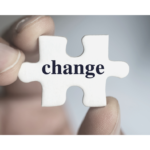
Organizational change can be a sensitive topic to tackle in the business world. When given the choice, people choose continuity over change, because change comes with so much ‘stuff’ that can make it seem daunting and just too hard – and who has time for that these days?
Whether the change that is trying to be implemented is for the better or worse, it’s common for people to reject it until they understand what it means for them.
Change can be advantageous – embracing it can help you stay relevant and gain competitive advantages in business. But not everyone is a fan of change. Some people are change leaders and early adopters. Some people are slow adopters and won’t make even the most pressing changes.
It is a well-known reality that the world is changing at an accelerating rate, and that this will continue to have an impact on how we do business, pass our leisure time, and even interact with one another. To enable each employee to adapt to changes and contribute to the success of the business, it is crucial to establish a stable work environment. Organizational change may be approached in a variety of ways, and it is crucial to understand each one and the wonderful advantages that it can provide.
Organizations change their business practices for a variety of reasons. It can involve an external consultant or the organization itself starting the procedure.
Maintaining organizational health and growth may require and depend on organizational transformation.
In the realm of business, adapting to change is frequently required to stay competitive and satisfy the demands of a changing market. In general, change is a good thing and is frequently welcomed in life. It is also the one constant that we can rely on happening. However, not all change is advantageous, and some businesses find it challenging to adjust to it.
Organizational change can take many different forms, including:
• Strategic Transformational Change
• Structural Change
• Remedial Change
• People-Centric Organizational Change.
Strategic Transformational Change
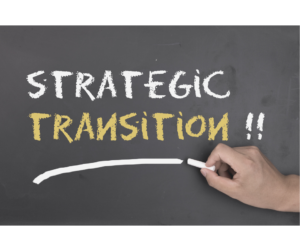
The process of changing the general direction of an organization, or a group inside an organization, is known as strategic transformational change management.
Senior organizational executives frequently start strategic revolutionary change.
Strategic transformational change frequently entails a protracted process that calls for careful planning and preparation. It is a creative challenge that calls for strong leadership and a lot of support.
It is a method built on the premise that every organization has the capacity to develop and change. This method focuses on the desired objective and is outcome oriented. The method is the secret to strategic transformational change.
The method should be designed to empower the participants in the change and foster a sense of ownership in them.

Structural Change
When we consider change, we frequently consider structural change. We typically hear about this kind of change the most.
It entails a total overhaul of how something functions. For instance, a business that has a lot of debt might decide to restructure to reduce costs, boost productivity, and make debt repayment simpler.
This kind of change is rarely successful and is frequently challenging to achieve.

Remedial Change
The process of fixing something that has already gone wrong is known as remedial change.
Where is the benefit in waiting for the error to occur before rectifying it?
Don’t try to mend something that isn’t broken. Allow the business to operate flawlessly within the framework of the current system, process and procedure.
The greatest approach to prevent errors is to keep your surroundings organized. In this manner, you can be certain that everything is in its proper location and won’t lead to any problems in the future.

People-Centric Organizational Change
The organizational changes that are executed with a focus on people have the greatest chance of success.
The employees, clients and other stakeholders whose mindsets and actions the change will affect are the focus of people-centric change management.
The organization concentrates on the feelings of these stakeholders during this type of transition.
The premise of the change management strategy for this kind of transition is that if your staff and customers are content, they will support your new offering and comply with your new rules.

Case Study: Organizational Change Failure
Organizational change typically fails, according to the main finding of a Robert Half Management Resources research entitled “Where Change Management Fails”, a study which involved 300 senior managers at US businesses with at least 20 employees.
According to the study, the executional phase is where failures happen most frequently. This is primarily the result of poor or broken communication.
46% of respondents claimed that execution problems plague most change-management initiatives. Interestingly, only 10% stated it happened at the strategy creation stage.
In response to the question of what was most crucial when guiding their business through a significant organizational transformation, the respondents stated:
• Frequent and clear communication: 65%
• Outlining the objectives in detail: 16%
• Effective delegation: 9%
According to Tim Hird, executive director of Robert Half Management Resources, “… whether significant or incremental, many firms are launching changes, from restructuring their business models to modernizing business processes and looking for ways to boost productivity. While change is never simple for a business, it may be especially challenging for employees.”
“People naturally worry what a transition will mean for them. To prevent rumors, resentment and stress, managers must quickly and continuously update staff, not just on the nuts and bolts of the change but also on how team members will be expected to contribute and, ultimately, benefit from it.”
Robert Half Management Resources also highlighted some change management ‘do’s and don’ts’:

The Change Management Process
Despite sometimes being referred to as the ‘soft side of change’, managing the people side of a change is frequently the trickiest and most crucial part of an organizational transition.
Think about an acquisition or merger. The technical aspect of the modification is undoubtedly intricate. You need to decide on the structure of the new corporation, integrate corporate systems, sort out the deal’¬¬s financial details, and more. But whether a merger or purchase is successful or unsuccessful may depend on how many people are involved.
Why? People will have to carry out their work in a different way.

Their willingness to adapt new behaviors and procedures will have a big impact on the initiative.
This is why a change’s soft side may also be its hardest side. Fortunately, you can manage the human side of change in an organized way and significantly increase overall success.
If you don’t take your people along, developing a new organization, building new work procedures, and putting new technology into use might never reach their full potential. That’s because a company’s ability to make money depends on how fully its employees accept change.
A defined procedure and a collection of tools are used in change management to guide the people side of change towards a desired result. In the end, change management focuses on how to assist individuals in embracing and utilizing change in their regular work activities.
We acknowledge that change management is both a process and a capability when we define it.
The change management process enables professionals inside businesses to grow and leverage the change management initiatives that aid in the transition of impacted people and groups.
Why is change management necessary?
Effective change management should be used on both large- and small-scale projects for a variety of reasons. Here are the top three explanations:
1. Individual changes affect an organization.
2. It is expensive to ignore the human component of change.
3. Using change management techniques enhances success chances.
Change inside an organization occurs one individual at a time.
It is simple to solely consider change only from an organizational standpoint. You might concentrate on financial structuring, data and system integration, and changes to physical locations when considering a merger or acquisition. However, any type of organizational transformation happens one individual at a time. That’s because only when Andre, Becky, Carlos, and Dharma perform their tasks differently does an organization-wide shift take place.
We see it as an organization that is changing, but the reality is that it is the people within the organization that are changing. Successful organizational change is the result of the cumulative effects of successful individual changes. An organizational transformation project won’t succeed if people don’t make adjustments to their regular tasks.
It costs money to ignore the human component of change.
There are several repercussions from improperly handling or disregarding the human component of change:
• Customers notice negative effects of a change that should have been invisible to them.
• Suppliers experience productivity declines on a larger scale for a longer period of time than necessary.
• Managers are unwilling to devote the time or resources needed to support the change.
• Key stakeholders do not attend meetings.
• Employee morale suffers and divisions between “us” and “them” start to emerge.
• Stress, burnout, confusion and exhaustion increase.
• Suppliers begin to feel the impact of a change that should have been invisible to them.
Additionally, projects experience rework, budget overruns, missed deadlines and even abandonment.
The health of the project and the organization are directly impacted by these repercussions.
Fortunately, if you apply a disciplined strategy to the people side of change, you can minimize these problems.
Change management enhances success chances
Despite being referred to as the ‘soft side of change’, change management is actually the difficult aspect of change because of its impact on people.
When it comes to the success of your initiative and avoiding the countless expenses that come with poorly managed change, investing the time and effort to manage the people side of your organizational initiatives pays off in the end.

Positive Organizational Culture
There is nothing more enjoyable than working for a company with a fantastic work environment. Favorable workplace culture has a positive impact on your company’s financial objectives and staff retention.
A healthy workplace culture increases employee engagement, promotes increased productivity, and ultimately improves business results. This is why developing a supportive workplace culture is important.
A positive organizational culture is one where:
• the employees wake up every day energized and looking forward to going to work.
• the employees enjoy being around their colleagues.
• the retention rate of employees is high because they love the challenges and the work atmosphere.
• stress, burnout and exhaustion rates are low because the work/life blend is spot on.
• the work demands individual growth and development, but not at the expense of health and wellbeing.
Some signs of a positive organizational culture include the following:
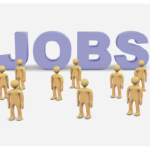
Feeling secure in your job
One indication of a healthy corporate culture is the development of a sense of job security among your personnel.
It could be difficult to detect at first, but you won’t become aware of it until the team meeting or project briefing. Your employees are not concerned about their co-workers completing a task or project successfully. They even congratulate and support one another without hostility.

It is more than “simply a job”
It’s one thing to look forward to going to work every morning, but it’s quite another to look forwards to seeing your co-workers. When at work, employees take their jobs seriously and feel driven to do the assignments provided to them.
When it’s time to leave the office for the day, though, your employees take their time because they are still conversing with their co-workers and don’t want to leave just yet. Or perhaps they watch the soccer match together after work by going to the pub.
The fact that they greatly enjoy the company of their co-workers does not imply that they do not have other pals. This can be one of the unintentional ways to involve your workforce and encourage involvement.

Low staff turnover
When your present employees have been with the company for a while and have no plans to leave, that is another indication of a healthy corporate culture.
It is usually having a healthy corporate culture that makes your employees stay for an unexpectedly long period.
Having a high income and being comfortable in the company are frequently good reasons not to hunt for another employment. If workers wake up each morning pleased and eager to work, they won’t leave the company.

Lighthearted banter
How can you tell if your workplace culture is healthy? A kind smile or the exchange of “Good morning!” greetings from your co-workers at the workplace corner are good signs.
Whenever you are sitting at your desk, moving down the hall, or entering the office, the sound of lighthearted banter is a positive one.
In the midst of tremendous stress and intense attention, you can hear individuals conversing and enjoying themselves.

A lengthy queue of potential employees
People who are lined up to work for your firm are a sign that you have a strong company culture.
They could be able to get a better compensation package elsewhere; it is unlikely that it is because you are paying more than other organizations. People want to be a part of your corporate culture, though, since they have heard about it.

No need to gossip
When gossip is not accepted but simply does not occur, your workplace culture is healthy. Speaking directly to the person is encouraged to stop rumors at any level or position.
Employees are less likely to spread rumors about one another when they know they can be open and honest with their co-workers. Instead, they often provide a hand to one another when assistance is needed, whether it be for a personal difficulty or a work-related one.

Honest dialogue
Another indication of a strong company culture is an environment where there are no secrets or hidden agendas.
The staff members are not taken aback by any information that they were not made aware of prior to it being announced at a meeting or when they checked their email.
New information is disclosed well in advance, and managers may even solicit assistance from staff in problem-solving.
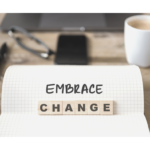
High energy employees are the norm
When there is a sense of employee engagement when it comes to finishing a task as a team or individually, that is another indication of a healthy company culture. Employees frequently talk about the task at hand and attempt to work as a team to solve problems. They acquire energy from it and are continuously coming up with solutions.
Employees collaborate on all work-related initiatives and offer assistance as needed because they are motivated to do so.
Whoever gets credit for what doesn’t matter because they did everything collectively. Your staff is integrated rather than dispersed.

Accepting of new concepts
Observing your staff adopt new ideas consistently is another indication of a healthy corporate culture.
When you impose a new idea on them, they don’t pout or complain; instead, they provide their opinions, and some even suggest improvements that would make the idea great.
A positive culture is the sole place where wellbeing originates.
So, how can you foster a positive culture?
1. Encourage social interaction.
Positive social relationships at work lead to outcomes that are extremely desired, according to a substantial body of empirical studies.
People also have fewer illnesses, heal from surgery twice as quickly, learn and remember things better, manage pain and discomfort better, are more mentally sharp and work better.In contrast, a study conducted by Sarah Pressman at the University of California, Irvine indicated that those with poor social connections have a stunning 70% higher chance of dying young than those who are obese, frequent drinkers or smokers.
Workplaces that are toxic and stressful have an impact on social interactions and, as a result, life expectancy.
2. Show empathy.
You have a significant influence on how your staff feels as a manager.
According to a telling brain imaging study, employees’ activity levels in the brain regions linked to avoidance and negative emotion were higher when they remembered a cruel or unempathetic boss, whereas the opposite was true when they remembered a kind or empathetic boss.
Furthermore, according to Jane Dutton and her colleagues at the University of Michigan’s CompassionLab, compassionate leaders encourage both individual and group resilience during trying times.
3. Make an extra effort to assist your employees.
If you have ever had a manager or mentor go above and beyond to assist you when it wasn’t necessary, chances are you have never forgotten what they did for you.
According to Jonathan Haidt’s research at the Stern School of Business at New York University, when leaders are not only just but also selfless, their followers are really motivated and inspired to uphold higher standards of commitment and loyalty.
As a result, they are more inclined to go above and beyond to be kind and helpful to other workers, starting a vicious loop.
According to research by Daan Van Knippenberg of the Rotterdam School of Management, followers of selfless leaders cooperate more because they have greater faith in them.
Additionally, they are more effective and see their leaders as being more charming and effective.
4. Encourage others to talk to you, especially if they’re having troubles.
It should come as no surprise that having faith in your boss to act in your best interests raises productivity.
A culture of safety, or one in which leaders are inclusive, humble, and encourage their staff to speak up or ask for help, leads to better learning and performance outcomes because employees feel safe rather than afraid, as research by Amy Edmondson of Harvard demonstrates in her work on psychological safety.
Feeling comfortable at work promotes the attitude of experimenting that is essential for creativity, as opposed to cultivating a culture of dread of unfavorable outcomes.
In contrast to a number of effective manufacturing and operations approaches, empowerment, when combined with effective training and teamwork, results in superior performance outcomes, as demonstrated by Kamal Birdi of Sheffield University.
Adam Grant, a professor at Wharton, shows in his book Give and Take that leadership generosity and kindness are excellent indicators of team and organizational efficiency.
In organizations where there is a positive work environment, employees typically have lower heart rates and blood pressure as well as healthier immune systems, whereas severe work environments are connected to poorer employee health.
A great workplace culture is a by-product of a positive work environment, and this culture in turn fosters dedication, engagement, and performance.
As a result, a joyful and compassionate workplace culture enhances client satisfaction and health outcomes in addition to employee wellbeing and productivity.
In conclusion, a happy workplace fosters positive feelings and wellbeing, which makes it more effective over time.
In turn, this strengthens interpersonal interactions and enhances people’s skills and inventiveness. It protects against problematic experiences like stress, and makes it easier for workers to recover from setbacks and problems while promoting their health.
Additionally, it draws in workers, increasing their loyalty to the boss and the company while bringing out their greatest qualities. In terms of financial performance, customer satisfaction, productivity, and employee engagement, firms do much better when they cultivate good, virtuous cultures.

Exercise 1.7 – Organizational Change
1. Using the boxes below, give each sign a score out of 5 where:
– 2 = exists but is poorly done
– 3 = exists and is done reasonably well
– 4 = exists and is done very well
– 5 = exists and could not be better


Course Manual 8: Personal Responsibility
Introduction
The concept of personal responsibility, often known as individual responsibility, holds that people choose, start, or otherwise cause their own acts.
It’s a skill that is vital to every individual creating and living a successful life. But in recent times, society has been teaching us that we need to look beyond ourselves to find the solutions that fix our problems.

The introduction of social media and the rise in connectivity through technological developments saw the world connect to individuals without the need for anyone (supplier or customer) to leave their couches.
Barriers to entry for any industry where services can be provided online fell, and it became extraordinarily easy to create an organization that provides products and services to clients and customers located all over the world.
Social platforms expanded to create the capability of delivering marketing campaigns and these campaigns focused on hitting trigger points in consumers that would ensure they bought the goods that were being offered.
While the marketing process hasn’t really changed, what has changed is the ability to use algorithms within the social platforms that send the campaigns directly to a target market, instead of using a more ‘scatter gun’ approach through traditional campaigns on television, in newspapers, on the radio or in magazines.
The social platforms have served to create a much more visible life than we previously enjoyed. With global time zones coming into play (social platforms are being used at all times of the day and night across all the different time zones in the world), people spend more time each day being digitally connected and switched on.
Most people use social platforms to announce and share the good things that are happening in their lives. When this is seen by others, they compare the amazing news and announcements they’re seeing from everyone else with the normal ups and downs of their own life and are left feeling like either they’re falling behind, they’re failing or that something is lacking in their life.
Of course, they’re comparing apples with oranges because they’re comparing their everyday, ordinary life with the virtual reality of bits and pieces of someone else’s life. In the moment, however, the feelings that come with that comparison are real.
Because we’re connected 24/7, there’s no break from the seeming onslaught of shining success in everyone else’s life. Because there are millions of users of the social platforms and they’re all posting their success regularly, it feels like the speed of life is constantly increasing.
When you get immersed in this, life can easily spin out of control as you take on more and more ‘stuff’ in an attempt to keep up.
Before long, you’re attending every event. You’re joining every group. You’re becoming a member of every association – all in the hope that it will help you find your way to success.
When that doesn’t work, you sign up for all the courses and programs, hoping that the answer lies within the course content.
And around all of it, the marketing campaigns get cleverer and cleverer, hitting trigger points and making you feel like you’ll fall further behind if you don’t sign up and do exactly as they tell you to do.
The problem with this, of course, is that doing exactly as you’re told to do almost never works. Any program that is created with a ‘you have to follow all these steps to be successful’ outlook is never going to give you what you need. The only thing these programs do is separate you from your personal responsibility.
It is only when you step into taking personal responsibility that you can understand what it is you need and then work out the simplest way to give it to yourself.
Understanding what personal responsibility is, why it’s important to have it and how you can take back control is the best way to get yourself back on track and give personal responsibility the place it deserves in your life.
It’s particularly important to understand how we get employees to take personal responsibility in a time when they are collectively looking to their employers to solve their health and wellness issues.
What is Personal Responsibility?
Personal responsibility, also known as individual responsibility, is the idea that each person makes their own decisions and is in charge of their own life.
It is the level of dedication you have to setting and achieving your goals. Additionally, it implies that you fully accept responsibility for all aspects of your conduct, emotions, and choices.
You won’t have much room for finger-pointing if you take responsibility for the things in your life. Additionally, it will enable you to take charge of your life more. If you are presented with the results of your actions, whether positive or negative, you will own up to them and accept responsibility.
You accept the idea that it is your responsibility and power to create the life you want. You understand that everything in your life occurs for a reason. And rather than happening to you, these circumstances occur for you.
Being willing to follow society’s rules for proper conduct is a sign of having a feeling of personal responsibility. A person who takes responsibility for himself won’t try to place the blame elsewhere.
In contrast, they react with maturity to the circumstance and take ownership of their actions.
Whether we like to or not, every one of us is ultimately accountable to ourselves. Nobody else should or can be held accountable for how our lives turn out or for the decisions we make. The repercussions of your actions and reactions are entirely your responsibility to bear.
An essential trait for leading a successful life is personal accountability. It shows that you take responsibility for every element of your life and are equipped to deal with anything that comes your way.
Why is it important?
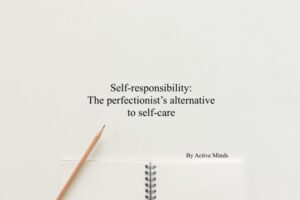
According to research conducted by the U.S. Centers for Disease Control, a person’s ability to deal with illness is influenced by their lifestyle 53% of the time, their surroundings 21% of the time and their doctor 10% of the time.
Thus, the individual and his society have full control over 84% of the capacity to deal with, and lower the risk of, sickness and premature mortality.
Only 16%, then, is either out of our control or is influenced by our genes. The potential for genetic engineering to replace defective genes inherited from parents may further lower this number.
Health is more than just being free of illness.
It is a component of a broader idea of wellbeing that emphasizes:
• Being in good physical, mental, and social health (in terms of relationships with others and one’s own body).
• The interconnectedness of all facets of life.
An individual who is informed and motivated to adopt and maintain healthy behavior is more likely to achieve optimum health – by choosing healthy behavior and making the most of their heredity and environment.
When personal responsibility is in play:
• It is the responsibility of each individual to get the knowledge and skills necessary to become an independent adult and to maintain good health.
• Health is a state of complete physical, mental, and social wellbeing. It is a measure of one’s quality of life.
• Wellness is a holistic idea that encompasses every aspect of life and how positive and/or negative feedback loops affect one another.
• Healthy conduct is behavior that:
– aids in the prevention of sickness or accident
– advances your health and the health of others, and/or
– enhances environmental quality.
• People are promoting good health by educating and inspiring others to adopt and sustain healthy practices.
The polar opposite of healthy behavior is risky behavior.
Being responsible for your own acts is personal responsibility. This implies that you are accountable for the results of your activities – good or bad. When you make a mistake, you should be able to accept responsibility for it and take steps to fix it without blaming anyone else.
Accepting the results of your choices is also crucial. There are consequences to every choice we make – just cause and effect, really. We make choices every day, both significant and insignificant, that determine the course of our lives. Accepting personal responsibility is realizing that the choices you’ve made have led you to where you are today.
Prior to taking care of others, it’s equally important to look after your needs and take care of yourself. During the safety briefing that is given before every flight, you are instructed to put your own oxygen mask on before attempting to help others. There is a very good reason why: how can you help someone else if you aren’t able to breathe? In order to be your best self for others, you must first take care of yourself.
In real life, this entails establishing boundaries and putting your own needs—both bodily and psychological—ahead of those of other people.

You are in charge of your thoughts, feelings and actions in every circumstance. In reality, we have very little power over the outer world. Our thoughts and behaviors, however, are things we can control. We have the freedom to decide how we express our emotions and how we interact with others.
Understanding what you’re feeling, what caused the sensation, and how to deal with the feeling in a healthy way require a certain level of emotional intelligence.
You are only responsible for changing your circumstances; you cannot place blame on anyone else. Being sad and stuck in a rut occasionally is normal. And while it may be simple to lay blame for your misery on others, the truth is that nobody is compelled to keep you where you are. You have the ability to alter and improve your current circumstance. You always have a choice and a duty to act in a certain way.
Being responsible means that when someone asks you for something, you owe them an answer or a response—not an explanation or a postponement. The correct course of action is to acknowledge the instructions, start working on the assignment, and finish by the deadline if you are required to complete a job by a specific date. If the deadline cannot be met, communication with the proper parties is necessary to let them know. Personal responsibility is answering a friend’s request for time spent with a definite yes or no and informing them if your plans change for whatever reason. Being responsible means you recognize the need for mutual respect and trust in all interactions, whether they be personal or professional.
Being responsible can be a valuable life skill.
Responsibility is one of THE most crucial life skills to have. Being responsible entails being aware of the significance of deadlines and due dates, as well as showing up on time for meetings, job interviews and social gatherings. It entails abiding by established laws and regulations and maintaining order in all of your personal concerns, including your family, house, finances and health. Being accountable makes life easier to navigate and wins you respect from others.
Responsible people keep their word and fulfil their obligations.
Unless there is an emergency, a responsible person wouldn’t often cancel on you at the last minute. When you commit to anything, other people rely on you to follow through. They have high expectations of you and place their faith in your ability to keep your word. Personal responsibility is taking ownership of your commitments (to others or to yourself) and carrying them out.
There is no blame in embracing responsibility. It is a waste of time to try to determine who is at fault in situations where more than one individual is at fault for things that are going wrong. Even if you weren’t involved in the issue at all, taking responsibility means taking charge and finding answers rather than laying the blame.
Responsibility is both a skill and a personal choice. You can successfully integrate into society by being responsible. A lack of accountability leads to a more challenging and stressful life. For instance, spending money on items you don’t need when you have bills to pay is a decision you make on your own that has far reaching effects.
A variety of things contribute to personal responsibility, such as accepting responsibility for your actions, being dependable, holding yourself accountable, having emotional intelligence and respecting commitments and deadlines.
Additionally, it demonstrates maturity and a comprehension of how society functions better when everyone does their part.
Taking Control
Taking personal responsibility involves building skills in key areas including:
• Acquiring knowledge so that you know which behaviors are healthy and which ones are holding you back.
• Examine your actions to raise your awareness of what you are regularly doing.
• Setting personal goals and then creating detailed plans to achieve each goal you set.
• Make informed judgements about your life, choosing the healthiest course of action by applying a problem-solving mindset.
• Make a commitment to your lifestyle and exercise self-control to engage in healthy behaviors and abstain from risky ones.
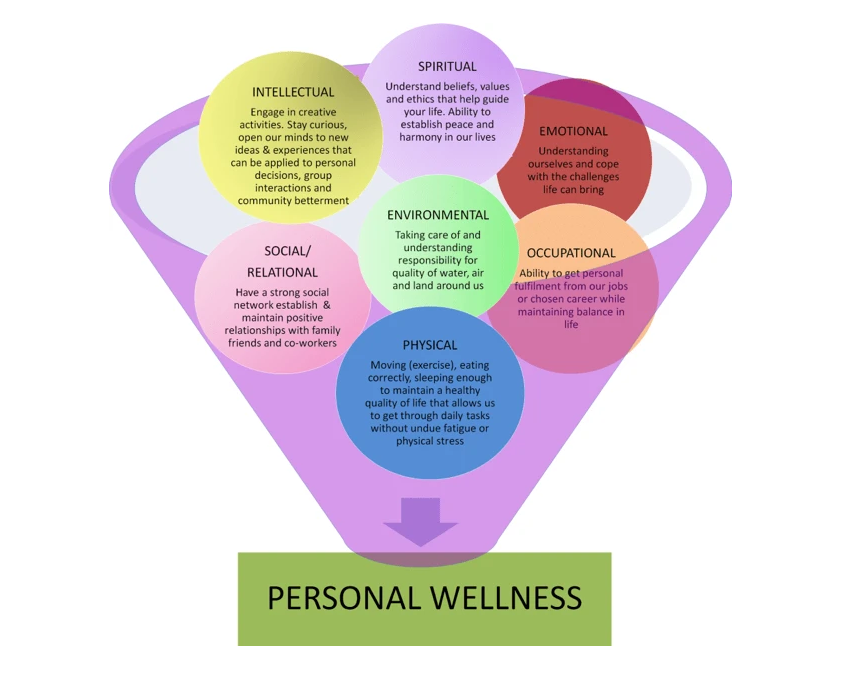
The benefits of personal responsibility
Being personally responsible keeps you inspired and committed to achieving your goals. Stepping up and taking responsibility can see your health and quality of life enhanced in a number of ways.
In those times when do you experience failure – and we all experience times when things don’t go as planned – you’ll be more driven to keep trying. When outside factors interfere with your ability to complete tasks, you can show accountability by accepting responsibility for these setbacks. This can help you get the confidence that your choices are under your control and enable you to move forwards with your plans to accomplish your objectives.
Being personally responsible makes it more likely that you will keep track of your progress towards your goals and the steps you are taking to accomplish. You can alter your behaviors to continue working towards achieving your goals if you stay on track and stay focused on your goals.
Taking responsibility for your actions could lead to better interpersonal interactions. Researchers from Utrecht University in the Netherlands discovered in a 2005 study that encouraging personal accountability led to children behaving more positively in social situations. People will know they can trust you to accept responsibility for the results of your activities, which may manifest itself in the form of trust being built.

Case Study: Metro AG
The youngest CEO among DAX-30 companies, 43-year-old Olaf Koch assumed control of the global retailer Metro AG in January 2012. Never one to sit still, he had big plans for the business, including restoring customer-centric value creation, stimulating global entrepreneurship, and ensuring success via excellence.
It was necessary to go through a tendency towards complacency, silo mentality, and inward orientation in order to put his plan into action.
Koch was adamant about tackling the necessary change at the source of everything: culture. He made the decision to begin the process with the Metro Cash & Carry sales line, involving 120,000 people, in consultation with the executive board, Heiko Hutmacher, the CHRO and others.
Genuine Leadership Obligation.
“It was immediately apparent that every employee needed to be given full, genuine leadership responsibility if we were to overcome fragmentation and self-absorption. This required reviving internal motivation and sincere accountability. Leaders needed to develop into genuine role models capable of forging deep bonds of inspiration and trust.”
Metro AG and Oxford Leadership (OL) started a two-step process. The Self Managing Leadership® (SML) solution from OL – a highly interactive and engaging program that uses plenary sessions, small group conversations, and individualized reflection to create insight, focus, and commitment – was introduced as part of the Leadership for Growth 1 wave. Koch and Hutmacher determined that the Metro Cash & Carry organization would cascade the initiative through top officials.
The main goal of SML was for employees to restore focus on a very personal level by re-establishing genuine communication with one another and themselves.
Leaders and staff members considered the evolution of their own behaviors, values, vision, impediments, choices, tactics and actions throughout the SML Compass process.
Participants felt empowered to make deliberate personal decisions, participate in significant conversations, and alter some of their essential behaviors as they received understanding.

Exercise 1.8 – Personal Responsibility
1. Choose one area in your life where you would like to make a change.
2. Write down how you can give yourself:
– Freedom to act differently.
– Room to make mistakes.
– The ability to grow from your experience.
– Time and space to complete tasks and get things done.
3. How will you take personal responsibility for making sure these things are implemented and completed?
4. How will you hold yourself accountable?
5. How will you measure your level of personal accountability?
6. What can you put in place to help you notice the moments when you’re not being personally responsible?

Course Manual 9: Truth, Myths and Marketing Spin
Introduction
For an organization to achieve the most it possibly can, they MUST get the most out of their people.
Basically, without healthy employees the organization can’t fire on all cylinders, and its results will be mediocre at best. The healthier your people, the more exceptional your results will be.
Acceptance of this fact has given rise to what is now being termed as a “corporate wellness” approach in business.

Unfortunately, the corporate wellness industry is replete with hype, deceptive information and empty claims – so how do you know what is truth, what is myth and what is downright marketing spin?
It’s likely that you’ve noticed a discrepancy between the ideal workplace “health” and the all-too-common reality. In the ideal scenario, you have a workplace full of energized, healthy workers who take part in your activities and have long-lasting effects. However, your reality probably looks more like this: low enrolment, poor involvement and few long-lasting effects.
Why is this situation so drastically different?
Workplace wellness initiatives are the subject of numerous urban legends which impede businesses from assisting employees in making long-term changes to their health.
Truth
The majority of employees dislike taking part in conventional wellness programs.
Picture this scenario: you make the decision to start your employee wellness initiative with a ‘couch-to-5K’ program, which will result in a group of employees competing in a local event. Why not adore it? It involves some light physical activity, some friendly competition and much-needed team building.
But it seems that a sizable section of your workforce doesn’t share your enthusiasm. One group of workers are experienced distance runners who don’t find training for a 5-kilometer event exciting or difficult. Another significant portion of the population declines to participate because they feel so out of shape that even this gradual approach would be daunting to them or too taxing on their bodies.
Thus, your first wellness initiative fails miserably as a result, turning off participants even before it begins.
Traditional competition-based wellness programs have trouble attracting participants, and it’s easy to understand why. They usually exclude people who can’t participate physically, and they emphasize temporary motivations that don’t impart or implant long-term behavioral change. Competitors merely compete for bragging rights and awards, when the true objective should be to enhance employee health over time.
In order to increase program engagement and participation, employers must create incentives and programs that are appealing to a wide spectrum of workers, and motivate them to modify their habits or lifestyles permanently.
Not all medical conditions can be cured by diet and exercise.
People wondered how Bob Harper, a fitness expert and the host of the U.S. TV program “The Biggest Loser,” could have had a heart attack at age 51. Because he was physically fit and followed a heart-healthy diet, he appeared to be the picture of health.
What can employers learn from Bob’s health concerns? Not all illnesses can be detected or treated with diet and exercise. Employers aren’t offering the correct possibilities for comprehensive wellbeing if they don’t treat illnesses and symptoms that aren’t readily apparent, such as stress, burnout and depression.
Even if an employee appears to be in excellent health, actual wellness cannot be determined solely by looking at eating and activity habits. Wellness initiatives that simply emphasize diet and exercise neglect the very real impact that other forms of wellness can have on general health, which is detrimental to both employees and employers.
Employers should strive for a comprehensive program that addresses emotional, monetary, social and occupational aspects, while providing workers with the resources they need to make long-lasting gains.
You can’t expect complete savings with an incomplete wellness program.
With the correct wellness program, you may both save and earn money.
Another scenario: since the majority of your employees are young and in good physical shape, you anticipate that their healthcare expenses would be extremely low. But several squad members are getting help for their persistent suffering. One person is on temporary incapacity due to depression. High levels of sick days are reported. Additionally, morale and production are suffering.
The typical fitness-based approach to lifestyle management ignores mental health, which accounts for a significant portion of healthcare spending. Additionally, because 6.7% of all U.S. adults experience at least one depressive episode year, depressed workers cost their employers more than US$44 billion in lost productivity annually, with presenteeism accounting for more than 81% of that loss.
Long-term savings AND financial gains can be achieved by organizations with the RIGHT wellness program in place.
A wellness strategy that is adaptable and takes into consideration each person’s needs is more likely to be successful.
Telling someone they MUST engage in a certain activity is usually the most effective approach to prevent them from doing so. Programs for wellness are not an exception: just because you engage in a wellness program and encourage employees to participate doesn’t mean that their health will automatically improve.
Over the years, we’ve all attended dozens of ‘lunch-and-learns’ and seminars, gathered hundreds of handouts, and learned many “interesting facts”. But how much of that knowledge have we actually internalized and put into practice? Even if knowledge is crucial, it cannot significantly alter daily behavior on its own.

Consider every online “expert” who claims that giving up dairy, performing 50 burpees each day, or going on a barefoot mountain hike at sunrise are the actual paths to wellbeing. That may well have worked for them, but it’s almost impossible for it to work for everyone else. Similarly, a wellness program that is designed to accommodate everyone may be a poor fit for a significant portion of a company’s employees, leading to lower engagement and lower motivation.
However, a strong wellness program that can be customized for every individual can actually make a difference.
According to a study conducted by Aon Hewitt, 35% of respondents said they wanted reminders and recommendations that were tailored to their goals and circumstances so they could form new, healthy habits.
Offering health activities that include a range of themes – which could of course include the ‘couch-to-5K’ programs, seminars on work-life balance, lunchtime meditation sessions, culinary classes in the cafeteria, and retirement planning seminars – can aid in making the program relevant to all employees.
Corporate wellness aims to make workers feel happier and healthier. As a result, the team of individuals working together to achieve the goals that the organization has established becomes more effective.
The adaptability, leadership support and participant engagement of a program all play a significant role in its success.

Case Study: Saving Money Through Wellness
Many organizations overlook a crucial point in the discussion about cost-cutting: a standard wellness program won’t automatically solve their problems with healthcare costs. Only 13% of corporate health care savings, according to the RAND Corporation, come from lifestyle modification initiatives. A program that merely emphasizes eating and exercise may not provide significant savings, because health encompasses so much more than these two areas.
However, a well-designed wellness program can help firms save money and generate long-term profits.
This is how:
• Wellness savings: for every $1 invested in wellness programs, $3 in absence expenses were saved.
• Decreasing absenteeism: in the first four years after opening an employee health center, absenteeism decreased by 50% in the city of Plantation, Florida.
• Increased work hours: workers who had finished the first six months of a two-year weight loss program put in an extra four hours per day (on average). Prior to the program, they put in 5.2 hours fewer per month (on average) than anticipated.
• Company retention: 45% of Americans surveyed said they would stay at their employment longer as a result of employer-sponsored wellness initiatives, saving businesses money on costly employee turnover.
• Increased productivity and morale: companies that promote an effective workplace wellness program can increase productivity by as much as 8% because happier employees are more productive and innovative in their work and perform it better.

Myths about health and wellness
It might surprise you to learn that nearly half of senior managers assume none of their employees will encounter a mental health problem at work, despite the fact that one in five people experience mental health difficulties each year.
This was brought to my attention a few years ago when I was speaking with a senior manager of a multinational corporation. He was interested in learning how to fire employees who were struggling with mental health issues or, even better, how to screen applicants to ensure that he didn’t hire anyone with those issues in the first place.
Seven widespread misunderstandings about corporate wellness
Myth #1: Corporate wellness costs a lot of money.
Corporate wellness initiatives are quite affordable, and they have also been shown to be highly cost effective. The savings in expenditures are only the beginning of the benefits. Increased vigor, concentration and output at work have significant advantages. Another cost-saving benefit is a decrease in turnover due to the increased camaraderie and loyalty of a team that appreciates the employer’s care and assistance.
Myth #2: Corporate wellness requires a lot of time.
An effective employee wellness program requires the involvement and cooperation of management. It shouldn’t be thought of as a time-consuming task, though. The majority of what employees can do to participate – and this is most significant – is done outside of work hours, with even better results if you’re willing to give your staff more time during the workday to exercise. However, individuals can exercise even around lunch or after work – using incredibly quick and efficient 20–30 minute workout routines – if they are unable to find the time throughout the workday.
Myth #3: It’s hard to determine if it’s working.
You should decide what you hope to accomplish when you set up an employee wellness program in your company. Statistics will demonstrate the wellness program’s success over time, through healthcare expense reduction, productivity indicators and a decline in on-the-job illness.
Myth #4: Falling ill is uncontrollable.
Most illnesses occur as a result of our lifestyle choices. Six of the top seven causes of mortality, according to a poll, are brought on by lifestyle decisions. The degree to which someone is healthy – from how frequently they get colds, to their risk of developing any kind of repetitive stress injury or life-threatening illness – is much more under their control than we typically wish to acknowledge.
Myth #5. There are no exercise facilities.
You don’t need a gym to have space to work out. For your staff to exercise, there is absolutely no need to make large investments in sophisticated gym equipment. Exercise sessions can be carried out with ease in confined spaces using only one’s own body weight as resistance.
Myth #6: Workers don’t take part.
In a company, no employee may be deemed unfit and forced to take part in the wellness program. Many of the employees may already participate in physical activity, but some may require additional instruction and direction before actively engaging in the program. For those workers who must participate in corporate wellness, you can offer incentives, which will draw more people from across the firm. If your company has the funds for it, the incentives offered to employees may be a portion of lower health insurance costs or an additional one.
Myth # 7: What a worker does after hours has nothing to do with workplace wellbeing, nor is it a company concern.
The truth is that factors outside of the workplace – a worker’s dietary habits, sleeping patterns, social and personal connections, and many more – have a big impact on their general heath. All of these factors have an impact on how well individuals behave, perform and produce at work, which in turn has an impact on workplace morale, organizational culture and productivity.
Marketing spin used to keep you locked into the health and wellness spiral
The current corporate wellness focus is a spin-off from the multi-billion-dollar diet, supplement and fitness industries. They profit off the modern iteration of “health” which is characterized, at least in part, by the requirement to buy something in order to have it.
The highly competitive – and hugely crowded – wellness industry has seen the rise in popularity of extremely expensive ‘treatments’ and fads that take wellness to a whole new level. Think of standing in a cryotherapy room that has been cooled to extremely low temperatures, allegedly to delay the onset of ageing and speed up recovery. Or treadmills that are equipped with oxygen vaporizers to supposedly increase endurance. Meanwhile, the popularity of diet books has skyrocketed.
The wellness industry has developed its own mythology, making wellness much more complicated than it has to be. The messaging that underpins the wellness industry is emotive: don’t smoke, don’t drink too much, exercise when you like, eat a variety of foods with lots of vegetables and little processed stuff, see people, participate in activities that help keep your mind sharp – and the list goes on.
With the way that ‘well-being’ is marketed today with little oversight and by millions of participants in the wellness industry, a healthy lifestyle, which ought to be simple, becomes a complex consumerist muddle.
This does not negate the significance of nutrition and exercise. According to a global analysis that was published in the Lancet in 2017, being physically active more often was linked to living longer and having fewer heart attacks and strokes. This included doing chores around the house and walking instead of going to the gym. In other words, getting fit doesn’t mean you need to chain yourself to a treadmill for hours on end.
Research in the British Journal of Sports Medicine came to the following conclusion: “Higher doses of running may not necessarily be associated with greater mortality benefits, but any amount of running, even only once a week, is better than no running.”
Obsession isn’t necessary; all you may need is a little time, some space and a pair of sneakers. That doesn’t seem like wellbeing if you are spending money you don’t have on equipment or neglecting your family or your job out of necessity.

The diet industry is the same. Weight loss is undoubtedly a key component of treating some diseases, and research links wholegrains, fruit, vegetables, variety and olive oil to enhanced health.
However, the barrage of “experts” promoting their diet through marketing spin, PR programs and in the media is likely to lead observers to conclude that there is no broad consensus in food science regarding anything.
Many dietitians are advocating for evidence-based guidance, but a lot of the media creates the false impression that a good diet can only be attained through a specific belief system. Here, it seems, the fundamental concept of enjoying food is wrong.
The worst aspect of contemporary definitions of wellness is that they assign personal accountability for health to people through a market-based system. However, our living conditions ought to be created to promote optimal health. At its finest, exercise should be enjoyable, and we should hardly notice that we are doing it. Street play used to be commonplace, but now in many places it requires specific programs that temporarily give children the right of way over cars. We need to ‘flip the script’ on how we think about wellness, and instead focus on populations rather than on individuals.
In order for walking and cycling to replace other forms of urban transportation, we need better infrastructure. Cycling should be safer than driving, easy than walking and quicker than running errands. Children should be able to walk to school without being concerned about traffic. The degree of our health should not be determined by our weight.
Significant improvements in our collective health are much more likely to result from policies like ‘minimum alcohol price’ and reducing the “food deserts” that over a billion inhabitants around the world are believed to live in. These areas have restricted access to affordable fresh fruit and vegetables.
It also entails giving up staying awake at night worrying about a review of sickness benefits. It would be lovely if being less wealthy had no bearing on your lifespan or your propensity to develop chronic diseases.
The marketing campaigns ignore fairness, civic responsibility, science and empirical data, which are all essential to genuine societal wellness. It won’t reach us through an oxygen-diffusing device on a treadmill, that’s for sure.

Exercise 1.9 – Simple Wellness
– Was it the words used?
– How did it make you feel?
– How often, and where, did you notice the campaign?
– Did you click a link, take a look and then see the campaign again multiple times?
– Was it on a billboard that got your attention every time you drove/walked past?
– Was it a radio advertisement that you kept hearing over and over again?
– What did the campaign promise you?
– Did it live up to its promise?
– Did you start and not finish?
– Did you find it prescriptive and not relevant to you in parts?
– Did you experience buyer’s remorse?
– Do you feel like Fear of Missing Out (FOMO) drove your purchasing decision?
– Did you not buy and now regret it?
– Do you keep thinking that it might have been the solution to your ‘problems’ and now you’ve missed out?
4. Where was ‘marketing’ used to spin the truth to get you to buy?
5. What are three simple questions you can ask to help you identify marketing spin in campaigns to help you move away from impulse purchases that are designed around triggering emotions.
– What will you do to help you remember to ask the questions?

Course Manual 10: Happiness
Introduction
One of the most fundamental things about being human is the need to feel happy.
We’ve been attempting to create new tools, technologies and lifestyles since the dawn of human civilization, with the primary aim of finding happiness. However, most of us are scarcely aware of what precisely qualifies as happiness – this can be seen in our drive towards technological advancement and our quest for wealth and extravagances.

According to Britannica, happiness is a ‘… state of wellbeing that a person experiences either in a narrow sense, when good things happen in a specific moment, or more broadly, as a positive evaluation of one’s life and accomplishment overall – that is, subjective wellbeing.’
Happiness can be distinguished from other pleasant feelings – such as affection, excitement, and interest – as well as from negative emotions – such as sadness, fear and rage. This positive feeling frequently arises along with the smile, one particular facial expression.
The particular emotion of happiness is frequently listed as one of the few fundamental emotions that cannot be divided into more basic emotions, and that may mix to create other, more complicated emotions – in fact, it is sometimes the only positive emotion that is considered to be basic. As a result, the concept of happiness is crucial for researchers who study emotions.
The more inclusive idea of subjective wellbeing, which is characterized by a wide range of happiness-related occurrences rather than a single fleeting emotion, has given rise to a whole field of research. People who are pleased in this way tend to have frequent pleasant emotions and infrequent negative emotions, as one might predict. However, this broader definition of happiness includes a cognitive component in addition to an emotional one. When asked to reflect on the circumstances and events in their lives, cheerful people are more likely to give them a positive assessment. As a result, happy people express satisfaction with their life and all of their aspects.
It’s interesting to note that these many aspects of happiness don’t always coexist in the same person. It is conceivable for someone to have a lot of bad emotions while still accepting that their life’s circumstances are favorable. For instance, a person who helps the sick, the underprivileged or the homeless may frequently feel depressed, yet also be content with life because of the work they do. Similar to this, those who frequently indulge in hedonistic pleasures could occasionally feel happy or content, but they might also feel that life is pointless and empty. Researchers who study subjective wellbeing are interested in the different variables that affect these unique elements.
For two reasons, psychologists are drawn to the topic of happiness. First, psychologists research happiness because the general public is curious about it. Happiness routinely ranks first on lists of the things that are most important to people around the world. People place achieving pleasure higher on their priority lists than getting rich, staying healthy or even entering heaven. Psychologists think that by researching the variables linked to happiness, they might assist people in achieving this aim.
A person’s evaluative reactions to the outside world may reveal details about the fundamental traits of human nature – this is the second reason why psychologists research pleasure. One of the fundamental tenets of psychology theory is that both humans and animals are driven to seek out and stay away from things in the world that make them feel pain. This behavior most likely originates from adaptive processes that direct organisms in the direction of resources and away from threats. If so, the opinions of many people regarding the world ought to be instructive and insightful.
For instance, some psychologists have proposed that people have a fundamental urge to engage in powerful and encouraging social connections. They argue that a person’s social connections are dependable predictors of happiness, and they use research in the area of subjective wellbeing to back up their position. The aspects of human nature should therefore be better understood by documenting the correlates of happiness.
The findings of scientific investigations point to a number of tendencies. People who claim they are happy today also tend to say the same thing when questioned again in the future, for example, when researchers ask people to report on their level of happiness. The stability of happiness measurements lends weight to the notion that these measures actually touch this crucial dimension because people’s circumstances rarely change. Additionally, research demonstrates that people’s assessments of pleasure alter in reaction to actual life experiences.

Perhaps more significantly, these measures all tend to point to the same conclusion when psychologists attempt to quantify happiness in a variety of different ways. For instance, when people are asked to self-report their level of pleasure, they frequently concur with informant-reports of happiness, or assessments made by friends and acquaintances. In addition, psychological tests that require participants to recall as many joyful experiences as they can in a minute may also be used to identify people who are happy, without explicitly requesting such a judgement. Once more, these measurements tend to coincide with self-reports.
Even the brain contains signs of happiness, according to psychologists, as particular patterns of brain activity are consistently linked to positive emotions.
When psychologists monitor people’s degrees of happiness, the majority of people report having somewhat happy moods the majority of the time. In addition, the majority of respondents give psychologists ratings of overall life satisfaction that are higher than neutral. This study’s findings are not just applicable to samples from wealthy backgrounds, like the college students who are often asked to participate in psychological studies. Instead, it has been repeated among several populations in numerous countries all over the world. Therefore, when psychologists examine the correlates of happiness, rather than seeking characteristics that separate the happy from the wretched, they typically seek out traits that separate the extremely happy from the mildly happy.
How happiness impacts health and wellness
In their quest to find factors that predict pleasure, psychologists have come to a number of unexpected results. Happiness does not appear to be significantly influenced by many of the first things that may come to mind. For instance, despite the fact that many people aspire to work in high-paying positions and harbor lottery dreams, happiness and income are not highly connected. Happier people tend to be wealthy, but the gap between the two is not that wide.
The relationship between wealth and happiness is largest among really impoverished people and in developing nations, as one might anticipate. As income levels increase, happiness increases in a decreasing proportion.
Subjective wellbeing is similarly influenced by health, but the correlations are again unexpectedly weak. According to surveys of representative populations, there is relatively little relationship between happiness and objective indicators like medical reports, hospital visits and symptom lists. Subjective assessments, such as an individual’s assessment of their health, frequently show stronger correlations, but even these relationships are, at most, modest in magnitude.
Additionally, despite the fact that persons with serious health issues, including paralyzing spinal cord injuries, are significantly less joyful than people without disabilities, the difference is not as significant as one might anticipate. Even those who have very severe illnesses frequently report happiness levels that are higher than neutral.
Social connections have been found to be the element most strongly associated with high levels of happiness. Strong social connections are regularly linked to better levels of wellbeing, according to research. However, even more objective measures of happiness, such as the number of close friends one has, the number of social groups to which one belongs, and the amount of time one spends with people, all show weak to moderate relationships with happiness.

Specific social ties are also crucial for subjective wellbeing, as one might anticipate. For instance, one of the most reliable demographic indicators of happiness is marital status. People who are married consistently report being happier than single people, who are happier than widowed, divorced or separated people.
It’s intriguing to note, though, that it doesn’t seem that marriage itself results in higher levels of subjective wellbeing. According to longitudinal research, people only experience a modest increase in happiness around the time they get married, after which they soon return to their baseline levels. The differences between married and single people are mostly the result of selection factors that may actually encourage happy people to get married, as well as the long-term detrimental impacts of divorce and widowhood.
Other demographic traits also exhibit sporadic relationships with happiness. Though the strength of these impacts vary depending on whether religious beliefs or religious activities are measured, religious persons often report higher levels of happiness than non-religious people. Additionally, there is only a weak correlation between wellbeing and factors like IQ, education and career prestige. Furthermore, over the course of a person’s lifespan, happiness does not appear to fluctuate significantly, with the possible exception of the final years of life, when reductions are rather severe. And finally, there aren’t many distinctions between genders in terms of subjective wellbeing.
Research demonstrates that internal factors have a significant impact on subjective wellbeing, in contrast to the comparatively weak effects of external circumstances. Individual variations in factors associated with happiness manifest themselves early in life, are stable through time and are at least largely inherited. For instance, behavioral genetic research reveals that identical twins and fraternal twins who were raised apart share far greater similarities in their degrees of happiness. This shows that genes have a significant impact. Most estimates place the heritability of subjective wellbeing components between 30-40% for the negative emotional states of depression and anxiety, and between 40-50% for the positive emotional states.
Researchers that study personality have demonstrated that at least some of these genetic effects may result from the impact of particular personality qualities on happiness. For instance, the stable personality characteristic extraversion has a weak correlation with life satisfaction and a strong correlation with positive affect. Positive feelings are typically more powerful and more common in the reports of people who are gregarious, forceful and friendly.
This relationship between extraversion and pleasant emotion is so strong that some psychologists have even proposed that the two variables share the same physiological underpinnings. In a similar vein, studies have revealed that negative affect is moderately to significantly connected with the fundamental personality trait of neuroticism (and again, to a lesser extent, with life satisfaction and positive affect). This and other studies examining the relationships between characteristics and happiness (including elements like optimism and self-esteem) demonstrate that personality has a significant impact on people’s subjective wellbeing.
It’s a common belief that how people perceive the world should affect how happy they are. Some people are always looking for the good side of things, and it is likely that this optimistic attitude influences their emotional responses. According to psychologists, one’s perspective on the world and their general degree of happiness are related. Many studies have been done to look at the cognitive processes that influence someone’s subjective wellbeing.
For instance, a lot of scholars study how social comparison mechanisms affect happiness. Initially, psychologists believed that people assessed the circumstances in their own lives by contrasting them with the circumstances in the lives of other people. Individuals who are less fortunate than those around them (or, in other words, those who engage in upward comparisons) ought to be unhappy; those who are more fortunate than those around them (or, in other words, those engaged in downward comparisons) ought to be joyful. Despite the possibility of this effect, other research points to somewhat more intricate procedures.
For starters, happiness can increase or decrease as a result of both upward and downward comparisons. People may observe someone who is doing better and believe that either they are doing badly in contrast, or that the other person is an example of something they can aspire to. These two views should, of course, have different outcomes in terms of happiness.
Additionally, studies demonstrate that people’s comparisons of happy and unhappy people frequently differ. Others who are content with their lives may find comparisons that help them stay content; people who are dissatisfied may choose parallels that make them less content. So, social comparison has nuanced effects on happiness.
Goals and objectives have been demonstrated by psychologists to affect happiness. Unsurprisingly, those who are moving more quickly towards a goal have higher levels of happiness than those who are moving more slowly. However, research also demonstrates that simply having significant goals is related to being happier. People may be shielded from the negative effects of brief setbacks by the sense of purpose these goals give them. Interestingly, people’s happiness may also be influenced by the exact goals they decide to pursue. According to research, picking objectives that are difficult but doable is crucial.
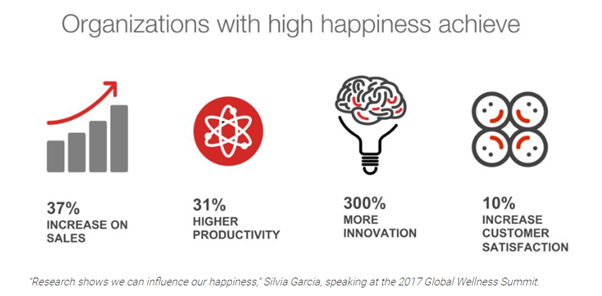
Psychologists have started to wonder what purpose happiness serves, despite the fact that people typically view happiness as an end in itself rather than as a means of achieving other objectives. The most well-known theory, put forth by American psychologist Barbara Fredrickson in 1998, contends that the purpose of happiness – or more specifically, the purpose of happy emotions – is to increase one’s capacity for thought and resource development. Positive emotions, according to this notion, encourage people to think imaginatively and try new things. As a result, contented individuals can discover fresh perspectives on the world, new hobbies, fresh connections with others and even new physical abilities. Positive outcomes in people’s lives are brought about by each of these effects.
Experimental and long-term investigations are now being used by psychologists to ascertain if positive affect influences future favorable results. These studies show that cheerful people are more friendly and cooperative than miserable people, as well as being healthier and having higher incomes. Even happier people live longer than unhappy people, according to a number of studies – and this is not just due to the fact that happy people tend to be healthy. Because it feels nice, most people want to be happy, but this desire may also result in other favorable developments in their life.

Is happiness a choice?
Yes, happiness is a decision and not a by-product of success or material possessions.
In reality, most of us don’t always feel cheerful; let’s face it, life just isn’t like that.
Genuine happiness is the capacity to feel a wide range of emotions while appreciating and maintaining focus on the positive aspects of your life. It does not, however, imply the absence of bad emotions like grief and suffering.
The majority of individuals believe that achievements or positive events are what make them happy – such as getting a promotion or a new job, obtaining a salary raise or receiving 100 new likes on their most recent Instagram post. In fact, a significant proportion of people don’t understand that happiness is a decision, and instead go through the motions of life in anticipation of joy striking them in the face.
Science has demonstrated, however, that these kinds of quick pleasures don’t actually make us happy – well, not in the long term, anyway. In reality there is no quick fix for happiness. Working at being happy is on the main things that helps to improve wellbeing.
Since happiness is a choice, you must continually work for it with effort, attention and dedication on your part.
Can you create happiness?
You can teach your brain to ‘default’ to happiness, even when the situation calls for something else. By engaging in specific “feel better” activities, you can raise your natural happiness ‘set point’. There are eight science-backed techniques you can implement into your daily life if you’re having trouble figuring out what makes people happy.
1. Decide to be grateful and optimistic.
There is always something positive to focus on, no matter how horrible life appears. It may be having a place to live in, loving friends and family, having clothes to wear, or even just having eyes to see and legs to walk on. Millions of people around the world lack some of these necessities.
Start identifying things in your life for which you are grateful, since happiness is a choice. It might also be seemingly unimportant, everyday occurrences that we frequently take for granted, like the aroma of freshly cut grass or the sound of the ocean. Making a list of these things in a thankfulness journal will help you to feel happier overall. Try listing three positive aspects of each day – according to studies, doing this boosts optimism, lessens anxiety and alters the brain’s chemistry to make it more optimistic.
2. Decide to think kindly.
Try to live by the proverb that “every cloud has a silver lining”. It’s more said than done to concentrate on good thoughts and attempt to reduce negative thinking, but give the following strategy a shot: simply replace every negative idea you have with a good one. Through this exercise, you can retrain your automatic thought processes to think more uplifting thoughts and experience happiness.
Finding contentment will be easier if you alter your viewpoint of the issue. Even if the error was significant, attempt to shift your attention to your past successes by picturing your achievements and joyful moments.
3. Smile.
Flip that scowl around! Thich Nhat Hanh, one of the most significant personalities in the disciplines of mindfulness and meditation, observed that “… sometimes your joy is the source of your smile, but sometimes your smile can be the source of your joy …”.
In fact, research has demonstrated that smiling and other outward displays act as a continuous feedback loop, supporting the reinforcement of our internal feelings. Making yourself smile while engaging in stressful activities can help lower your heart rate, according to research from the University of Kansas. Therefore, grinning even while we’re feeling bad will eventually make us happier (and healthier). Try grinning at someone you don’t know; cheerfulness is contagious and may be chosen.
4. Decide to be kind.
Serotonin, the neurotransmitter in charge of emotions of happiness and fulfilment, is increased when you choose to do good deeds for other people. These so-called happiness hormones are released when you do something selfless. Additionally, endorphin levels increase, resulting in the “helper’s high” condition.
Kindness also has a positive physical impact on the body by reducing anxiety. Low positive affect (PA), which refers to a person’s experience of good moods including joy, interest and alertness, is linked to social anxiety. In a four-week study on happiness conducted by the University of British Columbia, it was discovered that participants who performed acts of kindness showed significant increases in their PA levels, which persisted throughout the study.
5. Pick meaningful associations and interactions.
According to research, happy people engage in fulfilling social interactions. We need daily contact because humans are social creatures. In fact, it has been shown that loneliness lowers happiness levels, and latest research indicates that it may even be as deadly as smoking 15 cigarettes a day.
Choose good friendships if you want to choose happiness. In fact, even a brief, positive connection with a complete stranger can make you happier.
6. Decide to pay closer attention.
The simple practice of mindfulness meditation might help you strive to feel happier. Just 10-15 minutes of morning meditation can help you get ready for the day ahead because it will immediately increase your inner focus and clarity.
Numerous studies have demonstrated that meditation can increase pleasure by, among other things, lowering stress hormones, reducing the size of the brain region in charge of worry, and reducing rumination.
There’s always something positive you can find to focus on, no matter how horrible life appears. Start identifying things in your life for which you are grateful, since happiness is a choice.
And, according to Psychology Today, meditation is the mental exercise that has the most power to reset your happiness set point, making you a happier person and literally re-wiring key brain regions to support happiness.
7. Select a goal.
A positive trait you may extend across your entire life is meaningfulness. Activities with a purpose, such as volunteering, gardening or getting involved in politics, have been demonstrated to increase people’s happiness and lower stress levels simultaneously. According to a study published in the Annals of Behavioral Medicine, participating in such activities reduced stress and depressive symptoms by 34% and 18%, respectively.
8. Decide to be content
Theodore Roosevelt, a former US president, reportedly observed that “… comparison is the thief of joy …”. And this is truer than ever in today’s Instagram-ready culture. Flaunting your wealth, trips, and other purported triumphs or happiness in today’s social media-savvy world is all too typical, especially among the younger age. Comparing oneself to other people, on the other hand, will only lead to sadness if happiness is a choice.

Case Study: Happiness is an Experience, Not an Idea
The notion that choosing happiness is a choice seems to be just that – a notion – and it doesn’t seem to apply to you. How can you decide to be joyful when someone has treated you so poorly and when painful situations are happening all around you?
This is how many people feel.
The World Happiness Report is published yearly by the United Nations Sustainable Development Solutions Network. This gauges the general contentment of various nations. Finland’s citizens are found to be the best in the 2018 survey, while Americans are found to be the furthest behind at 18th place. Even though American earnings have more than doubled since 1972, the U.S. doesn’t even rank among the ten happiest nations.
Even while Americans have consistently increased their income, they don’t seem to be happier. The Easterlin Paradox is the name given to this discrepancy between wealth and happiness. Most likely, you have more money than you have ever seen in your life, but you’re still caught in the paradox and unable to figure out why you’re unhappy.
Why does the paradox make sense?
You can learn more about happiness by finding out the answer to this question. Since this problem is a paradox, it seems difficult to resolve. Yet the solution is much more straightforward than you may anticipate: choosing happiness.
What Buddhists Are Aware Of.
Buddhism places a special emphasis on developing happiness via consistent practice. Buddhists first recognize that suffering and mental illness are a natural part of life. This is the result of wanting and expecting things that you don’t have in the world.
Buddhists conduct specific rituals in their quest for enlightenment:
• Purge the bad thoughts from your mind: Recognize your negative ideas, change them to good ones and then act on them.
• Develop mindfulness: Pay attention to your breathing, how your body feels and your own thoughts without passing judgement. You should also pay attention to “phenomena” or the environment around you.
• Meditate and focus: While sitting and focusing on a single object, such as the sound of water, your breathing or a humming sound, let random ideas go.
• Be compassionate: One’s own pleasure is correlated with others’ happiness. True compassion can only be attained via thinking about other people and their pain, and compassion is a direct route to happiness.
Buddhists decide not to dwell on the past or the future.
Brooding and depression can be brought on by remembering the past, while anxiety can be brought on by worrying about the future. Depression and anxiety can be lessened by contemplating the present and having compassion for others in the present, which can open your mind to accepting happiness.
In their search for happiness, people adhere to a wide range of creeds, philosophies, and religions. You can decide to focus on what makes you happy in any circumstance.
You might decide to view even the most agonizing issue as a chance to improve the present and spread happiness.

Exercise 1.10 – Deliberately Choose Happiness
1. Write down one negative thought you had this morning.
– What was the thought?
– What situation occurred before the thought arrived?
– Were there other thoughts that came into your head at the same time?
– How has the thought(s) impacted your emotions this morning?
2. Turn the page in front of you 90 degrees to the right.
3. Viewing the negative thought from a different perspective, how can you see the thought differently?
– Is there another perspective to the situation?
– Is there something that the situation can give you that the negative thought has distracted you from?
– Is there an advantage you can gain from having experienced the negative thought?
4. What can you do to release yourself from the emotion attached to the negative thought?
– For example, if the emotion attached to the thought made you angry, and you’re still experiencing the feeling of anger, is there something you can do to let the anger go and move forwards with a more positive emotion driving your day?
5. Looking back on the situation that occurred when you experienced the thought, write down three simple things you can do to allow yourself to experience the same situation differently if it arises again. For example:
– What questions can you ask yourself to get a different view of the situation?
– How can you release challenging emotions in the moment rather than carrying them with you throughout the day?
– Is there a physical movement you can make to view the situation differently?
– Is there something you can do to experience the emotion of the situation differently?
– What other ways can support you in choosing a different experience from an emotional and consciously connected point of view?

Course Manual 11: Values
Introduction
Values are essential and fundamental ideas that direct or inspire behaviors. They assist us in deciding what matters to us. Values are the character traits we decide to live by to direct our behavior. They also characterize the type of person we want to be, how we treat ourselves and others and how we interact with the outside world. They also provide us with a general framework for behavior.
Values are only those things that are right, preferable or worthwhile. They provide us with a driving force that underlies meaningful activity. They take many different shapes and forms and represent the goals that we are striving to achieve in life.
Personal values are opinions on what is morally right and wrong that may or may not be regarded as such. Cultural values are those that are upheld by cultures or faiths and represent what is significant in each situation.
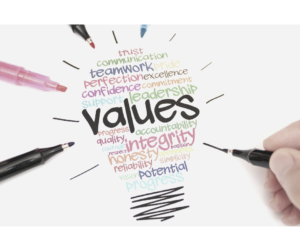
Value describes the connection between a person and a purpose. It is relational in the sense that, even in the same circumstance, what one person values may not be what another person values. For instance, someone who values honesty might come forwards with information about financial malfeasance by a boss, whereas someone who values loyalty might keep quiet.
The faithful person can think there are boundaries to loyalty and that keeping silent about wrongdoing might hurt others. Because of the trusting relationship, the loyal individual may think it is important to maintain one’s confidence even if doing so could hurt others.
Some values stand the test of time; they are consistent with good or moral conduct – for example, sincerity and kindness. They foster trust in relationships, which makes it impossible to conceive of having one without them.
Though they are uncommon, there are always exceptions. For instance, you probably won’t answer yes and justify it out of a sense of honesty if a criminal looking to harm your friend knocks on your door and asks if you’ve seen the friend. In this example, the greater good, so to speak, is to keep your friend safe.
In general, people have a tendency to adopt the ideals that their parents instilled in them. Due to the fact that those values are a part of their particular culture, people also frequently assume that they are “correct.”
Making ethical decisions frequently entails comparing different values and deciding which values to prioritize. People with different values may disagree with one another, which can result in conflicts over priorities and preferences.
Love, truth and freedom are three examples of ideals that have inherent value. Other values, like ambition, responsibility and courage, characterize traits or actions that are useful in achieving goals.
Still other ideals are regarded as moral requirements for people who adhere to them. Because they are seen as obligations, rather than criteria to be taken into consideration while making decisions, sacred principles are rarely compromised. For instance, for some people the national flag symbolizes a holy ideal. Others, though, can only see the flag as a piece of fabric.
Values, therefore, differ between people, across cultures and over time, regardless of whether they are sacred, have intrinsic value or are merely a means to an aim. But everyone agrees that values serve as a motivating factor in moral judgement.
What are values?
Values are personal beliefs that steer people’s behavior in one direction or the other. They act as a manual for how people should behave.
Your values are the things you hold dear in terms of how you live and in the way you choose to do business. Your priorities should be based on them, and it is also helpful to use them to gauge whether your life is going in the direction you want it to go.
When life is going the way we want it to, and we’re happy and feel like we’re in flow, we rarely consciously think about our values. However, when things are a bit tougher and we see and experience things that don’t align with our values, that’s when things start to feel … off.
It’s the tough times that remind us how important it is to consciously identify our values.

Why do you want values?
Personal values serve as the yardsticks by which we judge what constitutes a successful and fulfilling life.
When someone says “I want to be good”, their understanding of what that means reflects the things they value.
Some people may equate ‘doing good’ with earning money. Others may interpret it as starting a family. Others still will seek thrilling experiences to achieve their aim of ‘doing good’. Each person will individually decide the value that sits behind the statement of ‘doing good’.
As a result, discussing self-improvement without addressing values is impossible. Simply ‘growing’ and ‘being a better person’ is insufficient. What constitutes a better person must be defined. You must choose the direction that you want to take your growth – because if you don’t, then it makes it very hard for you to achieve any of your goals.
Most individuals are unaware of this. There’s a tendency to excessively concentrate on feeling happy and wonderful all the time, not recognizing that if the values don’t support the activity, feeling joyful will really do more harm than good. Feeling good won’t make your life better if your largest value in the world is snorting Vicodin through a wavy straw.
What role do they play?
Whether you are aware of it or not, you are choosing how to spend your time, what to focus on and where to put your energy – every instant of every day.
Although there are countless things you could be doing, you are choosing to be here right now. You choose to stop and read a text, have something to eat, go to the bathroom or chat to a friend.
You make straightforward, value-driven choices: ‘this’ is more valuable than ‘that’, and in line with that, you then take action.
As a direct result of where you place value on your time, your actions will follow accordingly. We continually demonstrate our principles by the actions we take.
This is crucial, since we all have a few things that we claim to value but never demonstrate via our behavior.
You may say that you worry about climate change and the risks of social media until you’re blue in the face. But if you spend your days commuting in a gas-guzzling SUV and continually scanning your newsfeeds, then your behaviors and actions speak for themselves.
Actions are truthful. We really do want that job, but when the going gets tough, we’re always kind of glad no one phoned us back, so we can go back to playing video games. We express our want to catch up with someone, or go to a work related event in person (but somehow we never find the time), yet the moment our mates call, a gap in our schedule appears as if Moses had parted the Red Sea.
What happens when we become disconnected from our values?
Many of us pretend to have values we don’t actually have, in order to hide the values we do have.
Aspiration frequently transforms into avoidance in this way. We lose ourselves in who we want to become rather than confronting who we truly are.
Or, to put it another way, we tell ourselves lies because we dislike some of our own values, and as a result, we start to really not like a portion of ourselves.
Because of this disconnect between our self-perception and reality, we frequently find ourselves in a variety of sticky situations. This pushes us to hide the fact that we have certain values and forces us to wish we had others.
This happens because we are extensions of our values. We are defined by them.
You feel glad when something positive occurs to something or someone you value. You feel happy – as if these things happened to yourself – when your mum receives a new car, your husband gets a raise, or your favorite sports team wins a championship.
The inverse is also accurate. When something horrible happens to something you don’t value, you will enjoy it. For example, when Osama Bin Laden was dead, people cheered in the streets. Outside the prison where serial killer Ted Bundy was put to death, people held a party. In the minds of millions, the death of a person viewed as ‘bad’ felt like some great moral victory.
Therefore, our beliefs and ideas become separated from our behaviors and emotions when we are not connected to our own values. For example, when we enjoy playing video games all day, yet think we value ambition and hard work. We need to develop delusions about the world and ourselves in order to overcome this gap.

Exercise 1.11 – Define Your Values (Part 1)
1. Consider the following question:
2. Next, ask yourself the following question:
– FACT: we all believe we will live forever.
– ANOTHER FACT: we are all going to die one day.
– YET ANOTHER FACT: none of us are certain of the exact time that day will arrive for us.
3. Now, taking into account your answers to Questions 1 and 2, ask yourself:
4. Now, create your values.
Part 2

1. Start by asking yourself these questions:
2. Use the ‘Notes’ column to add some additional words or a description to describe each value, as some may be similar.
3. After all of the five values have been written down, rank the values by asking: “Is 1 more important than 2?”; “Is 2 more important than 3?” and so on until you end up with a hierarchy of values with the most important one at the top.
4. Use this list of values to analyze opportunities as they come to you.
Part 3
1. When you are presented with an opportunity to do something, go somewhere, be involved in something, donate your time or money to something (and so on), what is the first question you would like to ask yourself so that you can make sure it matches at least one (but preferably at least two) of your values?
2. What other questions would you like to ask yourself to help you match your activities to your values?
– Think about what is important to you.
– What are the minimum requirements that this opportunity / activity needs to meet?
– How long are you prepared to be involved for?
– How does that match your values?
– Are you prepared to give up that much time?
– What else can’t you do if you become involved in this?
– How will this affect aligning what you are doing with your values?
– Is this opportunity / activity in alignment with your values?
– If yes – how?
– If no – how is it misaligned?
– Based on your above answers, is this something you want to participate in / be involved in?
What barriers could you face in having your values?
Even when we understand what our values are, why they’re so important to us and how to develop them, so many of us still find it difficult to embody our values.
Sometimes the issue is a lack of clarity or an ignorance of our true values. It might be that you see and experience things in the workplace that don’t fit with your values, but you feel that keeping your mouth shut will help you keep your job. You may appreciate tolerance, but some of the groups you’re a part of don’t seem to care about it. Or perhaps there’s a clash between your moral principles and the situational demands you’re under. Even if you respect creativity, you can’t risk starting an art profession because you have family obligations. Or perhaps you respect honesty but feel that there are some lies you must tell to maintain significant relationships, keep your work or for other reasons.
These are significant obstacles that merit careful consideration. However, it’s also important to keep in mind that there are numerous ways to live your life aligned with your principles – and that you can compromise in practical ways that take these obstacles into consideration.
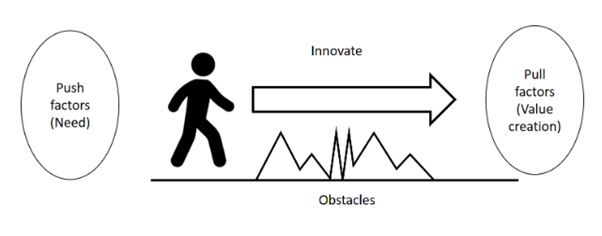
You can make a compromise now while ultimately working towards a course of action that is more consistent with your ideals. For example, if tolerance is one of your values and your employer doesn’t display tolerant behaviors, then you might not say anything to them (in the short term) to maintain your employment while you look for employment elsewhere (in the long run). It’s perfectly acceptable to not risk being fired in the near term by being completely honest with your manager.
You may encounter some challenges if your ideals contradict those of others or the larger culture. However, you can still conduct your own life honorably. You can also battle to alter society in accordance with your personal ideas if your circumstances permit. Many historical figures, such as Susan B. Anthony and Martin Luther King Jr., had personal values that were in opposition to those of their day. However, if you don’t feel up to the challenge, you could decide to concentrate on your own behavior and principles rather than confronting individuals who live in a different way.
How to adapt and change your values when needed
Your values as an individual are flexible and will, should and NEED to change as you ebb and flow through life.
Of course, there are some core values that will likely remain constant throughout your life, but others may change with your circumstances or as you age and develop a different perspective on what’s significant. Or, even if the values remain the same, you might change the order in which you give them priority.
For instance, having children and creating a family may make you value safety and financial stability more than you did when you were single. Or a divorce could spark a resurgence of the drive for independence and self-discovery.
So, it becomes very important to periodically check in to determine if your values have changed.
When should you perform this? It’s probably wise to do this at least once a year and whenever a significant life change occurs – for example, a job loss, a death in the family, a serious illness, a divorce and the like.
Of course, you should continue to revisit your beliefs and make frequent references to them rather than just once a year. Feel free to change your values right away if you ever find that anything just doesn’t feel right.
Once you’ve created your new values list, review your objectives and, if required, revise them to reflect your updated or newly prioritized values. Additionally, each time your values change, you can start using your updated list of values to guide and inform your daily activities.

Case Study: A Business Case for Working with Values
Vodafone (New Zealand).
When Vodafone came to New Zealand to acquire BellSouth, they made the decision that their strategy approach would be values-based in order to successfully and seamlessly facilitate the purchase. Therefore, in order to successfully win over their personnel and establish a shared basis for all decision-making, the new culture had to be values-based.
According to Vodafone, a values-based organization is one that operates for purposes other than just producing money.
A values elicitation approach was integrated as a way to enable all workers to have the chance to assess and integrate their individual values with those of the organization. This values process was incorporated into a workshop along with a deep understanding of the organization’s basis and motivating beliefs.
The Outcomes.
1. In a little more than two years, their market share increased from 17% to 55%. With many of the same individuals operating in the same market as BellSouth, they have successfully accomplished this. The mentality of the personnel has changed the most as a result of this remarkable development.
2. The workforce turnover dropped from over 50% to under 20%, and there is a considerably greater percentage of staff retention. As much as 50% of these findings have been attributed to the values process.
3. People have stated (during performance management sessions) that realizing their own personal values has made them feel much more invested in their work.
4. The company has observed a rise in decision-making speed. They note that their focus has shifted from having to consider every possibility to relying just on their gut feeling. As a result, they may produce outcomes without continually scrutinizing their methods and actions.
5. Vodafone claims to have been effective in maximizing employee potential. Since their employees believe they are capable of making the proper decisions, managers do not require strict hierarchical restrictions to influence behavior.
Vodafone’s then-CEO Grahame Maher commented: “I am frequently questioned about why I talk about this values approach so much if it is so effective. Some people believe that I am revealing one of our greatest competitive advantages. However, your competitive edge is people, and everyone has values. Working with values makes logical sense because that’s what people naturally do.”

Course Manual 12: Beliefs
Introduction
Holding a view that something is the case or that a proposition is true is called a belief.
Philosophers use the term “belief” in epistemology to describe viewpoints on the world that can either be true or untrue.
To take something as true means to believe it to be true. For example, accepting the truth of the statement “snow is white” is equivalent to believing that snow is white. But actively reflecting on one’s beliefs is not necessary for holding them.
For instance, most people assume that the sun will rise tomorrow without giving it any thought. Additionally, beliefs might be dispositional as opposed to occurring, such as when someone intentionally thinks “snow is white” or when a person who, if asked about the color of snow, would assert “snow is white”.

Contemporary philosophers have attempted to define beliefs in a variety of ways, including as models of how the world might be (Jerry Fodor), as propensities to act as though certain things are true (Roderick Chisholm), as interpretive frameworks for understanding someone else’s actions (Daniel Dennett and Donald Davidson), or as mental states that serve a specific purpose (Hilary Putnam).
Eliminativists about belief, such as Paul Churchland, contend that there are no phenomena in the natural world that correspond to our popular psychological concept of belief, and formal epistemologists seek to replace our binary concept of belief (“either we have a belief or we don’t have a belief”) with the more flexible concept of credence (“there is an entire spectrum of degrees of belief, not a simple dichotomy between belief and non-belief”).
There are numerous significant philosophical discussions that center on beliefs. Examples such as “How should one rationally modify their beliefs in the face of diverse types of evidence?”, “How fine-grained or coarse-grained are our beliefs?” and “Must it be possible for a belief to be expressible in language or are there non-linguistic beliefs?” are questions that need to be answered.
What are beliefs?
‘Belief’ has two distinct meanings:
1. A belief is an opinion we regard to be true. Regardless of whether there is evidence or proof, it is an acceptance that something exists or is true – for instance, believing that fairies are real or that the Earth is round.
2. A belief is a trust or faith in something, such as an ideal like democracy or the death penalty.
We all have beliefs that we firmly hold to be true. However, many of these are unsupported by any evidence. We get erroneous conclusions when we hold false beliefs. We must constantly confront and question our views.
Though beliefs are frequently described as being exclusively religious or spiritual, this is not always the case. We all hold different kinds of beliefs: spiritual, intellectual, political or religious ones. Someone else may hold the opinion that the globe is flat and also claim evidence, while we may hold the notion that the planet is round and have evidence to back it up.
We all have a variety of beliefs, some backed by facts and some not. It makes no difference. Whatever the case, they are nonetheless beliefs.
When we state that we believe in democracy or the death penalty, for instance, we are using the word ‘belief’ in this sense. This is a different meaning of the phrase; it is a way of stating that we appreciate democracy, or that we value capital punishment, or that we think democracy is a desirable thing.
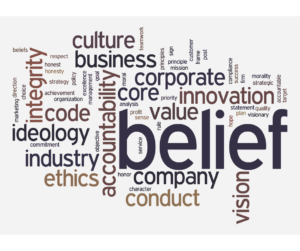
There are two distinct approaches to analyzing belief.
The conventional, or traditional, approach to the topic assumes that believing is a unique type of mental occurrence, also referred to as a “mental act”. This mental act is not always done consciously, but it is always possible to investigate a belief if a person wants to take the time to do so.
According to this perspective, the primary goal of a philosophy of belief is that the subconscious mind examines an introspectable mental event, analyzes it to the extent required, and then clearly distinguishes it from other mental events with which it may potentially be confused, without either accepting or rejecting it.
Modern thought on believing is very different.
Nowadays, most people view belief as a disposition rather than an introspective or other kind of happening.
It is generally accepted that when we say of someone “he believes the proposition p”, we are making a dispositional statement about him, which is similar to making a sequence of conditional statements outlining what he would be likely to say, do or feel if various situations were to develop.
For instance, if he overheard someone else disputing or casting doubt on ‘p’, he would make the assertion, either out loud or to himself in secret. When appropriate, the belief would underpin the inferences he makes and he would behave as if ‘p’ were true in any circumstances that may arise where the belief was practically relevant – whether it was true or untrue. He would be astonished if ‘p’ were false, but he wouldn’t be surprised if it were true.
According to this perspective, accepting a statement of belief is comparable to liking the game of cricket or detesting gardening. Similar to these, a belief appears or presents itself in several kinds of events, some of which are mental and others psycho-physical, but it is not an event in and of itself.
Although we aren’t always able to pinpoint the exact moment that a belief is acquired or lost, it is known that beliefs can be acquired at different times of life. Each belief we have is something we have or own throughout a period of time, whether it be long or short, rather than something that is applicable to a specific moment.
And while it may appear in a variety of ways when and if the conditions are right, none of these manifestations are beliefs in and of themselves.
For most of us, it makes more sense to describe a person as “staring anxiously at the clouds” or “debating whether to ask a passing driver for a ride” than it does to declare that at 4:35 p.m., “he is now believing that it is going to rain”.
The majority of proponents of the conventional analysis would probably be willing to acknowledge that the phrase “Jones believes that p” can be interpreted dispositionally. If this were disputed, they would be forced to the paradoxical conclusion that when Mr. Jones shifts his focus or nods off and stops considering the proposition ‘p’ for the time being, he ipso facto stops believing it.
There is undoubtedly a sense in which we can maintain our belief in a notion for a considerable amount of time, perhaps for many years, even though we hardly ever consider it.
What is the role of beliefs?
Our beliefs provide the practical basis for other cognitive attitudes like envisioning, which means beliefs influence whether and when one acts with those other attitudes as the cognitive inputs. Beliefs also motivate and legitimize behaviors that would meet desires.
It molds our thinking and our actions, in turn, define the end result. In fact, the power of conviction is so great that it also affects the attitudes and actions of those around us.
A person’s beliefs shape the filters they use to analyze the information at the outset of the decision-making process, which in turn affects how they perceive reality. This reality perception has an impact on our judgments and choices. These decisions and conclusions frequently serve to reinforce the initial ideas.
A belief system can provide a sense of security, meaning and community. This is particularly true during difficult times. Beliefs may influence recovery and raise overall quality of life.
Sharing ideas and feelings with others can help some people cope with cancer. It could perhaps reduce anxiety. A greater sense of wellbeing and personal development may be the outcome.
Sources of beliefs
We begin to create a network of beliefs in our minds from birth, if not earlier. Then, over the course of our lifetime, we amass thousands of beliefs about every area of life.
A belief system is created as a result of the interactions between these beliefs. We obtain them from a variety of different sources, strategies and techniques.
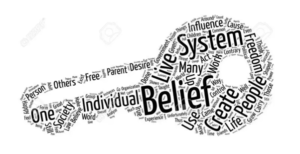
Our surroundings
Your environment shapes you just as much as you shape it.
Here, the notions that ‘failure breeds failure’ and ‘success breeds success’ are played out in the most ferocious way possible. The daily hardships and privations are not the true tragedy of ghetto life. They are surmountable by people.
The impact of the environment on beliefs and dreams is the actual nightmare. It is quite difficult for you to develop the internal representations that will promote success if all you perceive is failure or despair.
In fact, the most powerful factor in determining belief may well be your surroundings, but it’s not the only one. If that were the case, we would live in a world where children from wealthy families would only know money, while children from poor families would never rise above their circumstances.
There are other opportunities for learning and experiences that can foster belief instead.
Small and large events
No matter how big or small, experiences in our lives can influence our opinions. Your personal experience of what happens at these events will shape your beliefs about what is possible for you.
For example, if you were at an event and came face-to-face with someone you had admired – or even held in idol status – and they picked you out of the crowd, acknowledged you and spoke to you in a motivational way, that would form very different beliefs than if they walked straight past you and ignored the fact that you were there.
Knowledge
The power of knowledge: in order to develop new beliefs, we can draw on texts, individuals and quotations.
Knowledge is a third strategy for encouraging belief. One way to gain information is through firsthand experience. Another is acquired from reading, watching movies and taking in other people’s perceptions of the world.
One of the best ways to escape a constricting environment is through knowledge. No matter how bleak your circumstances, if you can read about other people’s successes, you can develop the beliefs that will enable you to be successful.
Past performance
Outcomes speak for themselves. If you’ve already done it, you know you can do it again.
Our prior results are a way in which results are produced. The only sure-fire method to convince yourself that you can accomplish something is to actually do it. It’s far simpler to develop the belief that you’ll succeed again after a first success.
Future oriented results
Just as you may infer future outcomes from past ones, you can also vividly picture coming up with fresh experiences and results. This will enable you to more deliberately shape your beliefs.
The fifth technique to form beliefs is to imagine the experience you want to have in the future as if it were already happening. Both your imagined experience of how you want things to be in the future and your mental representations of the past are subject to change as a result of experiences. This is referred to as anticipating results.
You may easily alter the environment to how you want it to be and step into that experience to change your feelings, your beliefs, and your behaviors when the outcomes you have around you do not support you in being in a powerful and effective state.
Justification for beliefs
When we stop to look at it, it’s interesting to note just how many of our beliefs we can’t support with either personal experience, outside data or evidence.
Without any meaningful proof (that we are aware of, though it may exist) or any questioning, we have accepted some beliefs as part of our education, culture or tribe. Even though it seems natural for us to hold our beliefs, in truth, we have accepted them irrationally.
We may firmly believe that the earth revolves around the sun, yet it may be difficult to defend that belief without considering scientific facts that we have not or are unable to independently check. Many of us accept that global warming is occurring, but we are unable to describe how it works or pass a basic test on the topic.
We retreat within what we’ve done before rather than consistently pushing our views and being willing to think otherwise about the opportunities that are there.

And that creates vulnerability in a world that is changing quickly.
Rarely do beliefs transform suddenly. Over time, they gradually change. Other than the opinions of individuals we love and trust, we have no evidence at all for some of our most fundamental beliefs.
The certainty we feel in our views is absurd given how little we actually know, yet it is also crucial.
We have confidence in particular individuals, communities or information sources. We think their arguments are solid.
But who can we believe? That all depends on which tribes we are a part of.
We are more likely to trust scientists and accept evolution if we come from a liberal tribe. We are less likely to believe in creationism and to trust the scientific community if we are members of a conservative or religious group.
Both believers and doubters are equally intelligent. In general, neither group has even the slightest idea what evolution is. The distinction has to do with our devotion to the tribe to which we belong, not with ignorance or stupidity. The topic is tribal mentality.
We can have faith in both scientific and religious authorities. We rarely consider the reasons behind our blind acceptance of some ideas or our preference for particular information sources over others.
A belief is anything you firmly hold to be true. You might hold an opinion, a fact or an assumption as the foundation for your belief. Although you may not immediately have personal knowledge of anything, when you believe it, you are confident that it is the way it is.
Your worldview may not always be accurate or true. Interestingly, because you don’t want to be wrong, you will instinctively search for proof or other experiences that will support and strengthen your ideas. Your vision of the world and what you hold to be true are frequently reflected in your beliefs. However, this does not necessarily imply that your belief is accurate.
Are beliefs a help or a hindrance?
This question is the perfect example of how our beliefs are formed.
The way the question is formed seems to suggest that there must be a clear cut answer of either ‘help’ or ‘hindrance’. However, the reality is that beliefs can be both a help and a hindrance.
The issue is as follows: according to Frank Lloyd Wright, “… the thing always happens that you genuinely believe in; and the believing in a thing makes it happen …”.
Your worldview (your map) is frequently heavily influenced by the biases and judgments of other individuals. Your map most likely formed subconsciously and without conscious thought. What does it matter if your map points you in the wrong direction, or to a route you don’t actually want to take? Or does your map not reflect your requirements, values and preferences?
To make sure your map supports and points you in the right direction, it is crucial that you regularly question and update your ideas. If you wish to change your views, it’s imperative to go back and re-examine the experiences that led to them, especially the unfavorable ones.
But beware: the brain is resistant to change. The brain needs between 30-60 days to adjust to a novel circumstance – or in this case, novel belief. You frequently have to start over if you regress during that period. The beliefs you hold can often affect the outcomes. So, instead make a design map rather than a preset one. Making meaningful life changes can never be started too early or too late.

Case Study: The Biochemistry of Beliefs
“Man is what he believes.” (Anton Chekhov).
In essence, beliefs are the guiding ideas that give life purpose and direction. Beliefs are the pre-set, structured filters that shape how we perceive the world, both external and internal. When we hold congruent beliefs about something, they act as “internal commands” to the brain about how to portray what is happening. People feel powerless when their beliefs are absent or when they are unable to access them.
Since we were children our beliefs have been formed based on what we have heard and continue to hear from others. The environment, events, information, past experiences, imagery and so on are some examples of the sources of beliefs. One of the most widespread fallacies individuals have is the idea that belief is a fixed, abstract idea. Nothing could be further from the truth! One chooses their beliefs. We are able to decide what we believe. Our worldview shapes who we are.
Beliefs are “hot material” that is entwined with emotions and are not just cold rational principles (conscious or unconscious). Perhaps this is why, when we feel as though our values are being questioned, we feel threatened or respond with often uncalled-for aggression. The emotional brain is no longer restricted to the traditional locations of the hippocampus, amygdala and hypothalamus, according to research discoveries that have been made time and time again. The sensory information we take in from the environment is filtered as it passes via one or more synapses and eventually reaches the area of higher processing, such as the frontal lobes.
At that point, the sensory data reaches our conscious awareness. Our beliefs control how much of this sensory information arrives. For our benefit, cell membrane receptors are adaptable and can change in sensitivity and shape. In other words, there is always a biological capacity for change and potential progress, even when we feel “emotionally” trapped. We become open and sensitive to additional sensory information that has previously been blocked by our beliefs when we choose to change our thinking (bursts of neurochemicals). Our beliefs alter when we shift the way we think. We alter our behavior when we alter our beliefs.
There have been numerous documented instances of placebos having a significant therapeutic impact on a wide range of illnesses throughout medical history. One such astonishing example was a woman who was experiencing extreme nausea and vomiting. Her stomach contractions were measured objectively, and the pattern they showed was interrupted, just as she had claimed. Her nausea was therefore assuredly going to be cured by a “new, magical, incredibly potent” medicine, according to the experts.
Her sickness reportedly left her in a matter of minutes. Even though she had been given ipecac syrup, which is typically used to cause nausea, the same gastric tests suddenly showed a normal pattern. The syrup’s presentation to her, coupled with the authoritative figure’s strong advice that it would help with her motion sickness, served as a command or communication to the brain that set off a chain reaction of the body’s self-regulatory biochemical reactions. This case eloquently illustrates how a placebo’s influence may be stronger than a drug’s anticipated side effects.
A noteworthy finding was that the meaning of the sickness or illness to the individual appeared to have a role in some of the placebo response. In other words, the belief or interpretation of the individual directly influences the biological response or behavior (inter-presents or internally represents).
Another fascinating investigation included a psychotic subject. It was noted that this woman had multiple personalities. Her blood glucose levels were within normal limits. Interestingly, her entire physiology, including her increased blood glucose levels, shifted to that of a diabetic the instant she realized she had the illness.
The opposite of the marvelous life-affirming placebo effect, ‘nocebo’, has also been discovered to be contributing. It is linked to unfavorable, fatalistic or disempowering ideas. According to psychiatrist Arthur Barsky, the patient’s expectations – beliefs about whether a treatment or operation will work or have negative effects – play a critical impact in the result.
Our consciousness is the root of our body’s biochemistry. Our biochemistry is strengthened by our beliefs. Our thoughts, feelings and, of course, our beliefs are clearly and unequivocally known to every single small cell in our body. There is a lovely proverb that says “…people get old when they cease growing”.
Regardless of your weight or bone density, if you think you’re tough, your body will unquestionably reflect that. When you think you’re depressed (more specifically, when you become conscious of your “being depressed”), you stamp the raw data from your senses with a judgement – that is, your personal view – and when you internalize it, you physically take on the “interpretation.”
In contrast to the widely-held belief that growth hormone is released according to a pre-programmed schedule coded into the individual’s genes, a classic example is “psychosocial dwarfism,” in which children who feel and believe they are unloved translate the perceived lack of love into depleted levels of growth hormone.
Bruce Lipton sheds light on the mechanisms of healing at the cellular level and offers scientific evidence in support of a holistic approach to health and healthcare. He highlights the importance of beliefs in health and illness by emphasizing that ‘love’ is the greatest therapeutic emotion and that ‘placebo’ effect accounts for a significant portion of any drug’s action.
He claimed that we still base our beliefs and actions as adults on knowledge we first learned as kids. The good news is that we can act now to replace the old, outdated beliefs that are being repeated by our subconscious mind. Additional recent literature supports information based on biologically based scientific foundations. There are few studies on traditional belief clinics, but if more research is done, we may be able to employ these traditional methods to manage clinical mental health.
Changes in perception are necessary before beliefs can be altered and, ultimately, our body’s biochemistry may be improved. Newer perspectives result from our intrinsic drive and readiness to learn and evolve. The real key to staying young is to actively seek out new experiences, acquire new abilities, and adopt new views that allow our brains to process newer perceptions. Thus, beliefs (internal representations/interpretations) are the power behind the biochemical profile’s amazing changes.

Exercise 1.12 – Examining Beliefs
• Where did this belief come from?
• Do I truly believe this, or did I pick it up somewhere else?
• How does believing this benefit me?
• How does this belief interfere with me?
• How can I be sure this belief is accurate?
• How can I re-write this belief so that it supports and benefits me?
Project Studies
Before the commencement of Workshop 2, each participant is to undertake an internal analysis into both the current position and future outlook in relation to the health and wellness strategy of their organization, as well as for their individual department or division within the organization.
Each participant is to write a report answering the following questions for both the organization and their department/division:
1. What is the health and wellness history of the organization?
– Has there been a specific health and wellness strategy created, adopted and implemented by the organization board?
– Has every department within the organization adopted the strategy?
– Do any departments waver from the strategy (either not adopting the whole strategy or doing different things specific to their department)?
– Is there a health and wellness budget?
– Is it expended each year?
– Who determines what the budget is used for?
2. Is there a communication strategy in place for health and wellness events, services and activities?
3. Is there engagement from employees for health and wellness events, services and activities?
4. Has the health and wellness strategy been measured for effectiveness, and are there specific metrics that are measured?
5. Are employees involved in creating the health and wellness strategy and/or activities, services and events?
6. How often is the health and wellness strategy updated?
– How has it changed?
– What has been added or taken away over the years?
– How have these changes been communicated?
– How have the changes been received by the employees?
7. What is the appetite of your employees for health and wellness offerings?
– Has there been an increase in demand for health and wellness offerings from your employees in recent times?
– Have the expectations of employees regarding delivery of health and wellness offerings by the company changed in recent times?
– How does the organization know what the demands and expectations of the employees are with regard to health and wellness offerings?
8. Undertake a SWOT analysis of the current health and wellness offerings. Describe in your own words where you believe the organization can improve the health and wellness offering it currently provides.
9. Using the above questions, create a monthly survey you will implement into your department, division and/or organization that will continuously measure the experience of health and wellness in your organization.
– What metrics will your survey measure?
– Who will be responsible for sending the survey and collecting responses?
– When will the survey be sent?
– Who will be responsible for collating and analysing the survey information?
10. Create a report template that will be populated each month with the results of the health and wellbeing survey.
– Who will create the report each month?
– Who will the report be disseminated to?
– Who will be involved in discussing the results of the survey each month?
Program Benefits
Human Resources
- Improved engagement
- Improved culture
- Reduced burnout
- Increased retention
- Employee loyalty
- Performance improvement
- Empowered workforce
- Healthy organization
- Increased effectiveness
- Happier workplace
Management
- Stronger leadership
- Increased focus
- Cohesive workforce
- Greater collaboration
- Wellness mindset
- Greater potential
- Improved communication
- Consistent management
- Greater creative flow
- Positive environment
Business Operations
- Improved wellness
- Reduced costs
- Operating efficiency
- Improved quality
- Operational synergy
- Enhanced environment
- Clarified priorities
- Improved effectiveness
- Organizational resilience
- Increased productivity
Client Telephone Conference (CTC)
If you have any questions or if you would like to arrange a Client Telephone Conference (CTC) to discuss this particular Unique Consulting Service Proposition (UCSP) in more detail, please CLICK HERE.




















